Quick filters:
Corn beetle larva Stock Photos and Images
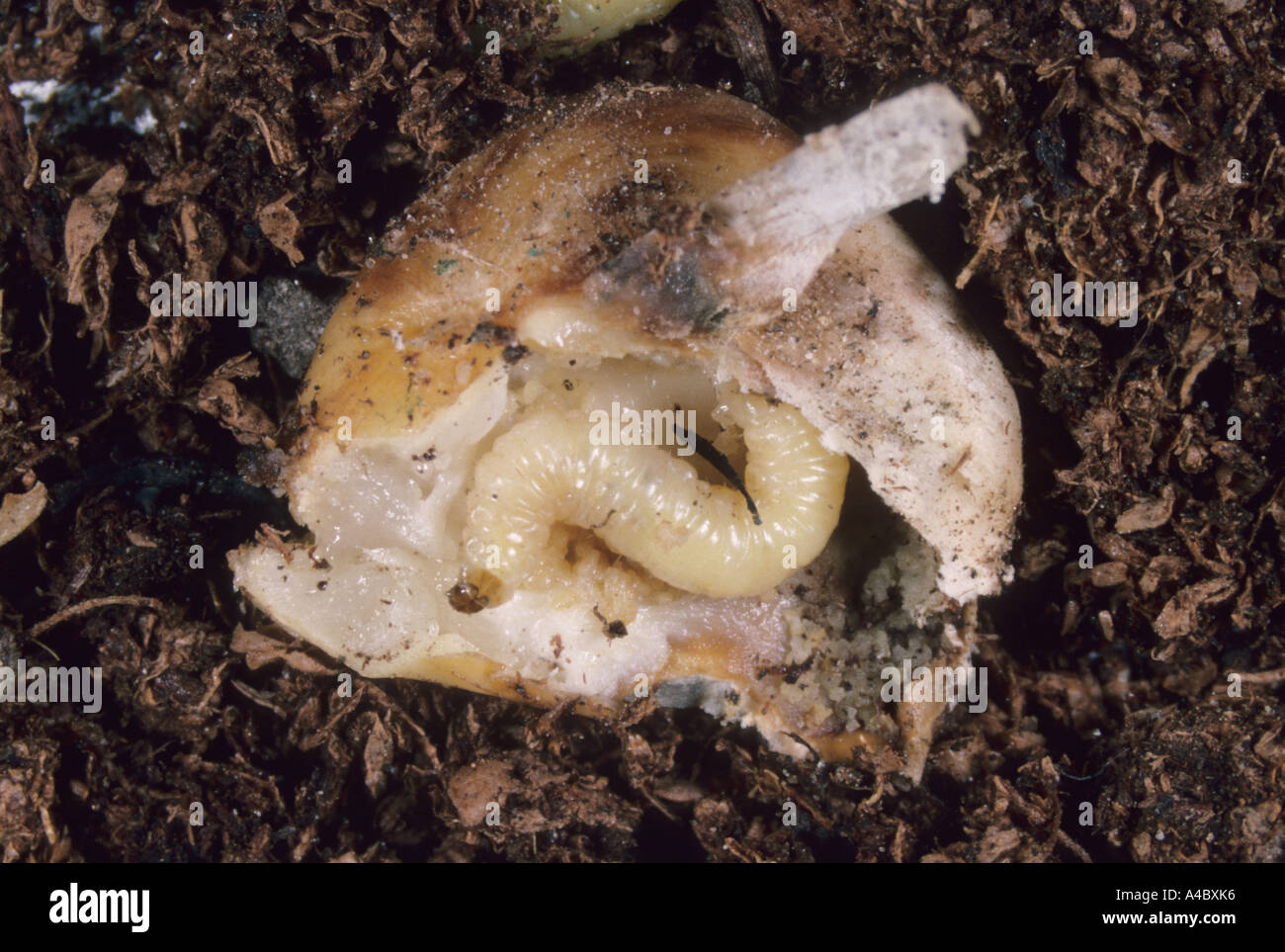 Spotted cucumber beetle Diabrotica spp larva in maize Zea mays seed Stock Photohttps://www.alamy.com/image-license-details/?v=1https://www.alamy.com/spotted-cucumber-beetle-diabrotica-spp-larva-in-maize-zea-mays-seed-image6286005.html
Spotted cucumber beetle Diabrotica spp larva in maize Zea mays seed Stock Photohttps://www.alamy.com/image-license-details/?v=1https://www.alamy.com/spotted-cucumber-beetle-diabrotica-spp-larva-in-maize-zea-mays-seed-image6286005.htmlRMA4BXK6–Spotted cucumber beetle Diabrotica spp larva in maize Zea mays seed
 Larva and damaged cereal plant by corn ground beetle (Zabrus tenebrioides) is a species of black ground beetle (Carabidae). A pest in soil Stock Photohttps://www.alamy.com/image-license-details/?v=1https://www.alamy.com/larva-and-damaged-cereal-plant-by-corn-ground-beetle-zabrus-tenebrioides-is-a-species-of-black-ground-beetle-carabidae-a-pest-in-soil-image451829571.html
Larva and damaged cereal plant by corn ground beetle (Zabrus tenebrioides) is a species of black ground beetle (Carabidae). A pest in soil Stock Photohttps://www.alamy.com/image-license-details/?v=1https://www.alamy.com/larva-and-damaged-cereal-plant-by-corn-ground-beetle-zabrus-tenebrioides-is-a-species-of-black-ground-beetle-carabidae-a-pest-in-soil-image451829571.htmlRF2H72H6B–Larva and damaged cereal plant by corn ground beetle (Zabrus tenebrioides) is a species of black ground beetle (Carabidae). A pest in soil
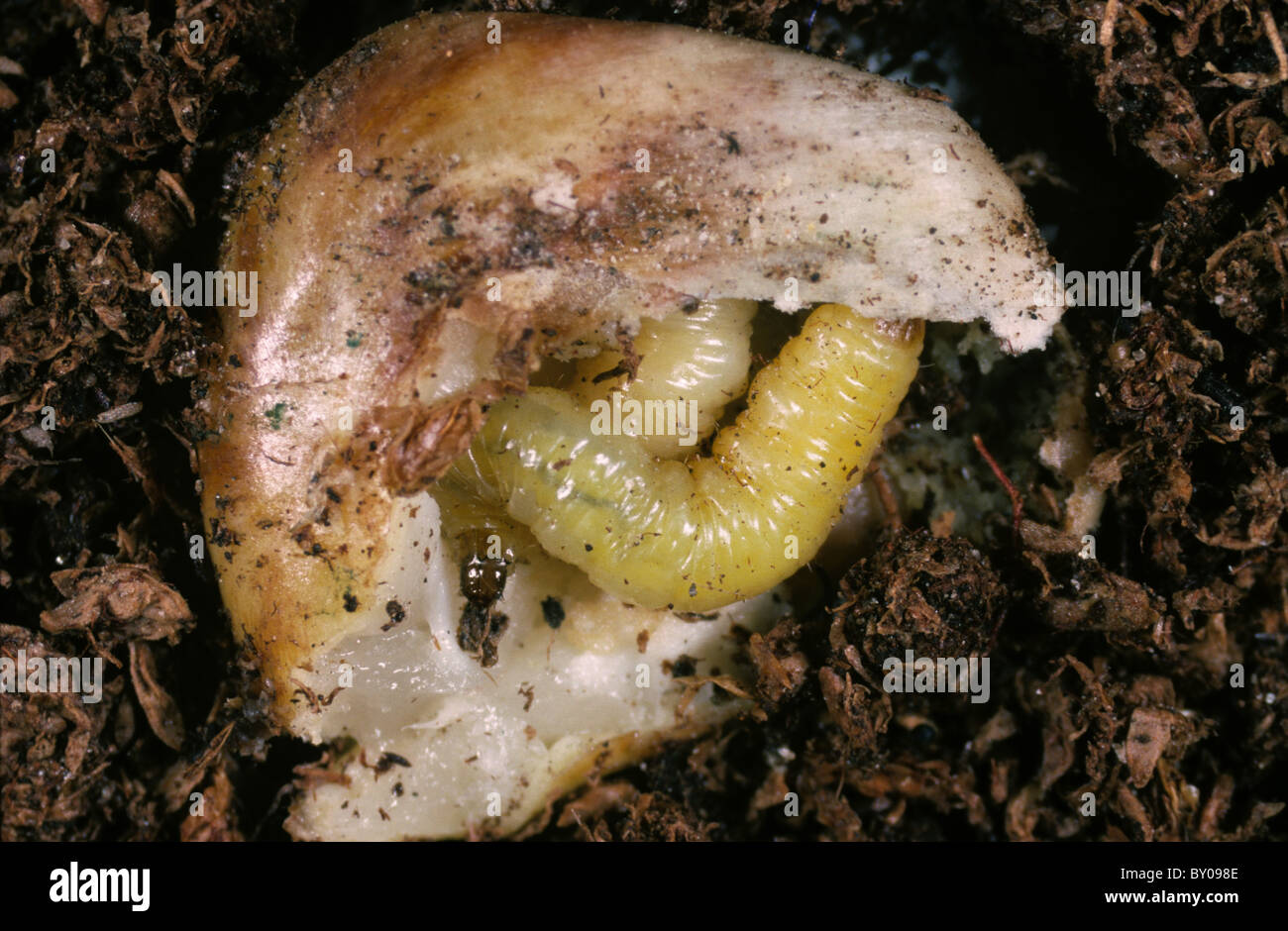 Spotted cucumber beetle (Diabrotica sp.) feeding on maize grain Stock Photohttps://www.alamy.com/image-license-details/?v=1https://www.alamy.com/stock-photo-spotted-cucumber-beetle-diabrotica-sp-feeding-on-maize-grain-33813374.html
Spotted cucumber beetle (Diabrotica sp.) feeding on maize grain Stock Photohttps://www.alamy.com/image-license-details/?v=1https://www.alamy.com/stock-photo-spotted-cucumber-beetle-diabrotica-sp-feeding-on-maize-grain-33813374.htmlRMBY098E–Spotted cucumber beetle (Diabrotica sp.) feeding on maize grain
 Carabid Beetle Rootworm Predator Stock Photohttps://www.alamy.com/image-license-details/?v=1https://www.alamy.com/stock-photo-carabid-beetle-rootworm-predator-135011735.html
Carabid Beetle Rootworm Predator Stock Photohttps://www.alamy.com/image-license-details/?v=1https://www.alamy.com/stock-photo-carabid-beetle-rootworm-predator-135011735.htmlRMHRJ8RK–Carabid Beetle Rootworm Predator
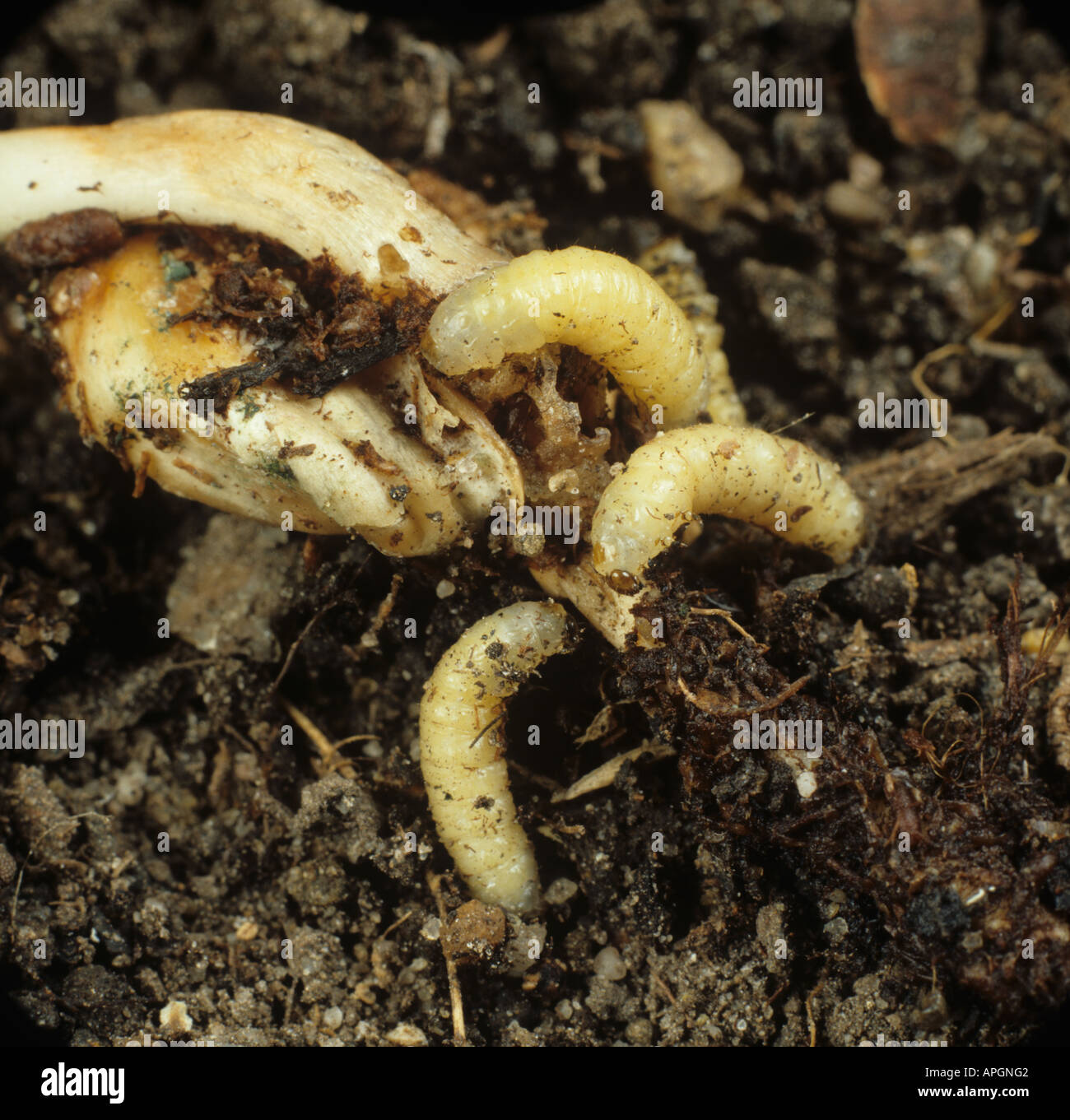 Corn rootworm Diabrotica spp beetle larvae feeding on maize root and seed Stock Photohttps://www.alamy.com/image-license-details/?v=1https://www.alamy.com/corn-rootworm-diabrotica-spp-beetle-larvae-feeding-on-maize-root-and-image9021377.html
Corn rootworm Diabrotica spp beetle larvae feeding on maize root and seed Stock Photohttps://www.alamy.com/image-license-details/?v=1https://www.alamy.com/corn-rootworm-diabrotica-spp-beetle-larvae-feeding-on-maize-root-and-image9021377.htmlRMAPGNG2–Corn rootworm Diabrotica spp beetle larvae feeding on maize root and seed
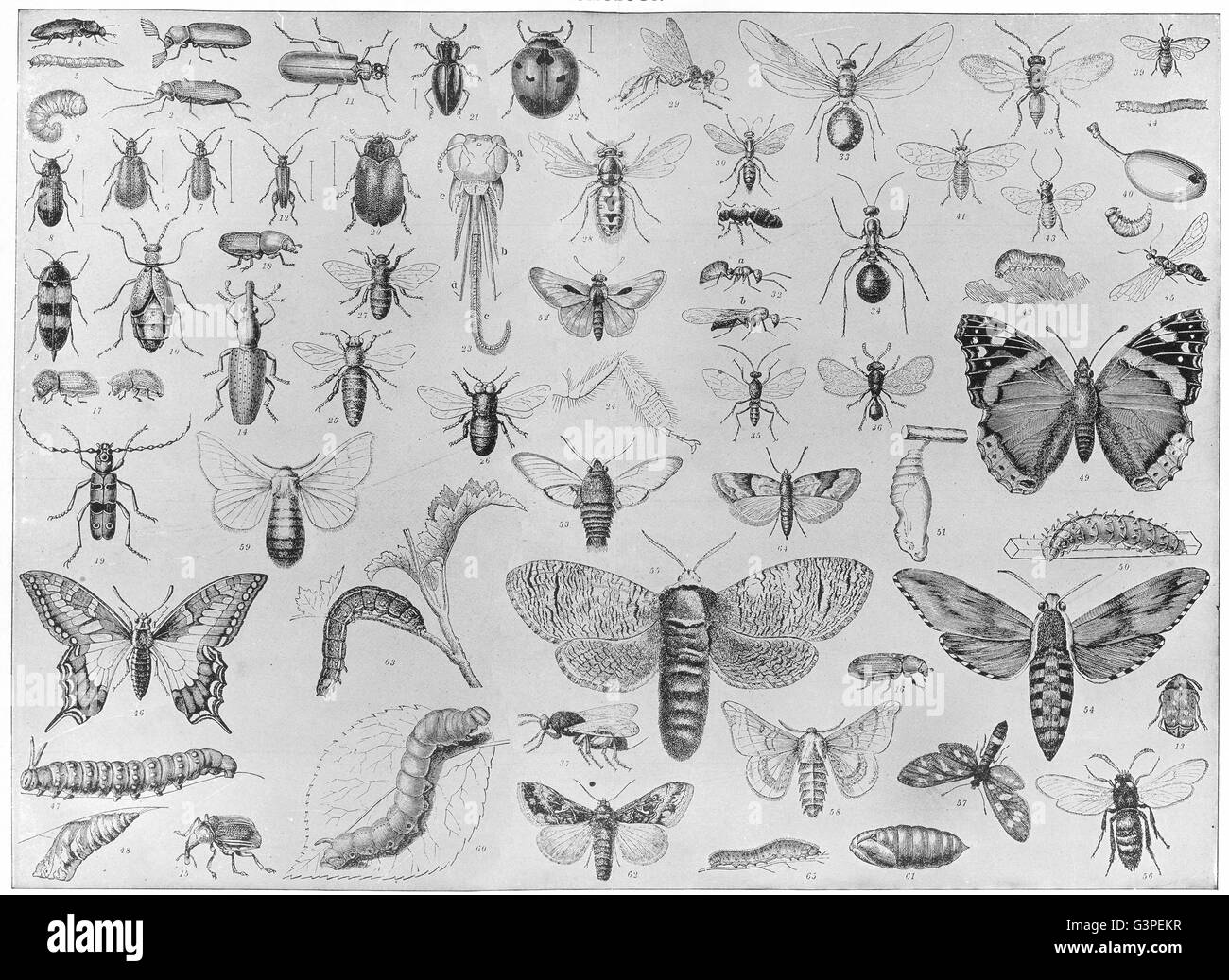 ENTOMOLOGY: Beetle ladybird butterfly caterpillar moth bee wasp weevil, 1907 Stock Photohttps://www.alamy.com/image-license-details/?v=1https://www.alamy.com/stock-photo-entomology-beetle-ladybird-butterfly-caterpillar-moth-bee-wasp-weevil-105600651.html
ENTOMOLOGY: Beetle ladybird butterfly caterpillar moth bee wasp weevil, 1907 Stock Photohttps://www.alamy.com/image-license-details/?v=1https://www.alamy.com/stock-photo-entomology-beetle-ladybird-butterfly-caterpillar-moth-bee-wasp-weevil-105600651.htmlRFG3PEKR–ENTOMOLOGY: Beetle ladybird butterfly caterpillar moth bee wasp weevil, 1907
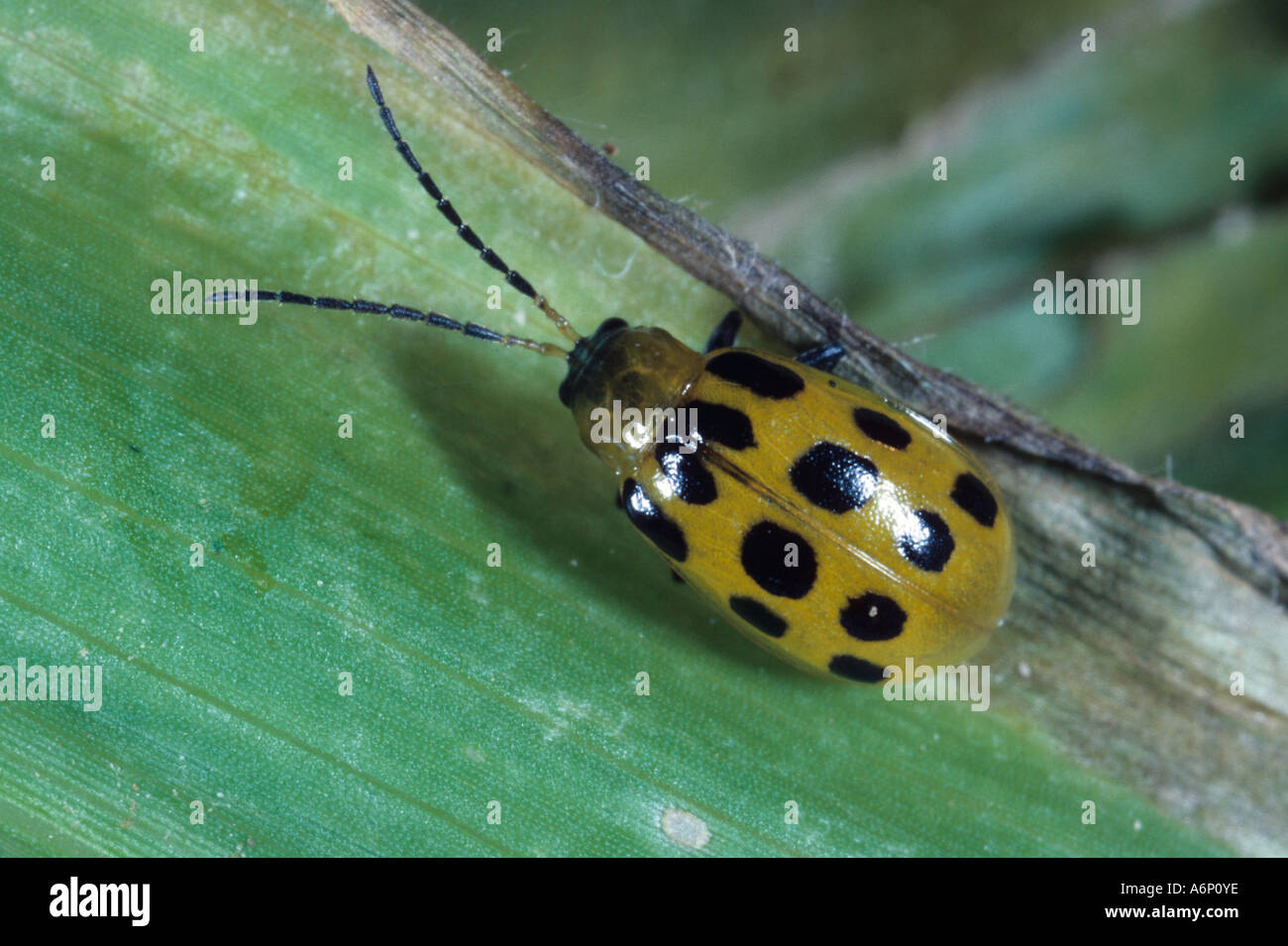 Adult spotted cucumber beetle, Diabrotica Stock Photohttps://www.alamy.com/image-license-details/?v=1https://www.alamy.com/adult-spotted-cucumber-beetle-diabrotica-image6641341.html
Adult spotted cucumber beetle, Diabrotica Stock Photohttps://www.alamy.com/image-license-details/?v=1https://www.alamy.com/adult-spotted-cucumber-beetle-diabrotica-image6641341.htmlRMA6P0YE–Adult spotted cucumber beetle, Diabrotica
 Farm crops, their cultivation and management, a non-technical manual for the cultivation, management and improvement of farm crops . Western Corn Root Worm (Diabrotica longicorni.s).- 1—Adult, or beetle; a, claw of hind leg; much enlai-ged. 2—Larva,or worm, much enlarged. 3—Egg, highly magnified. Stock Photohttps://www.alamy.com/image-license-details/?v=1https://www.alamy.com/farm-crops-their-cultivation-and-management-a-non-technical-manual-for-the-cultivation-management-and-improvement-of-farm-crops-western-corn-root-worm-diabrotica-longicornis-1adult-or-beetle-a-claw-of-hind-leg-much-enlai-ged-2larvaor-worm-much-enlarged-3egg-highly-magnified-image343036192.html
Farm crops, their cultivation and management, a non-technical manual for the cultivation, management and improvement of farm crops . Western Corn Root Worm (Diabrotica longicorni.s).- 1—Adult, or beetle; a, claw of hind leg; much enlai-ged. 2—Larva,or worm, much enlarged. 3—Egg, highly magnified. Stock Photohttps://www.alamy.com/image-license-details/?v=1https://www.alamy.com/farm-crops-their-cultivation-and-management-a-non-technical-manual-for-the-cultivation-management-and-improvement-of-farm-crops-western-corn-root-worm-diabrotica-longicornis-1adult-or-beetle-a-claw-of-hind-leg-much-enlai-ged-2larvaor-worm-much-enlarged-3egg-highly-magnified-image343036192.htmlRM2AX2J4G–Farm crops, their cultivation and management, a non-technical manual for the cultivation, management and improvement of farm crops . Western Corn Root Worm (Diabrotica longicorni.s).- 1—Adult, or beetle; a, claw of hind leg; much enlai-ged. 2—Larva,or worm, much enlarged. 3—Egg, highly magnified.
 Southern spotted cucumber beetle or southern corn rootworm (Diabrotica undecimpunctata) adult Stock Photohttps://www.alamy.com/image-license-details/?v=1https://www.alamy.com/southern-spotted-cucumber-beetle-or-southern-corn-rootworm-diabrotica-undecimpunctata-adult-image340316374.html
Southern spotted cucumber beetle or southern corn rootworm (Diabrotica undecimpunctata) adult Stock Photohttps://www.alamy.com/image-license-details/?v=1https://www.alamy.com/southern-spotted-cucumber-beetle-or-southern-corn-rootworm-diabrotica-undecimpunctata-adult-image340316374.htmlRM2ANJN06–Southern spotted cucumber beetle or southern corn rootworm (Diabrotica undecimpunctata) adult
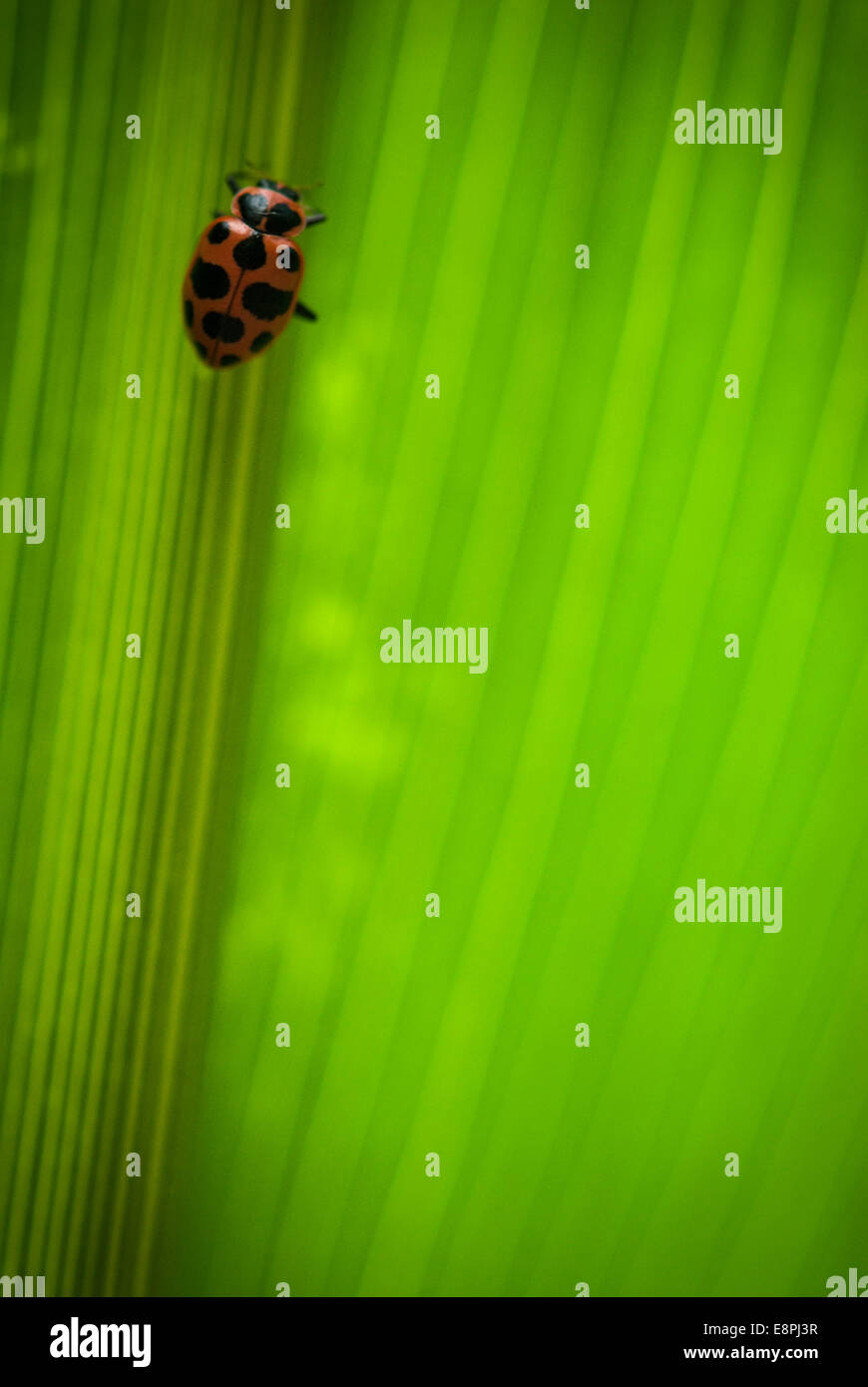 A ladybird (Coleomegilla maculata) on top of a parasitoid cocoon (Dinocampus coccinellae) as seen on a leaf in a cornfield. Stock Photohttps://www.alamy.com/image-license-details/?v=1https://www.alamy.com/stock-photo-a-ladybird-coleomegilla-maculata-on-top-of-a-parasitoid-cocoon-dinocampus-74255883.html
A ladybird (Coleomegilla maculata) on top of a parasitoid cocoon (Dinocampus coccinellae) as seen on a leaf in a cornfield. Stock Photohttps://www.alamy.com/image-license-details/?v=1https://www.alamy.com/stock-photo-a-ladybird-coleomegilla-maculata-on-top-of-a-parasitoid-cocoon-dinocampus-74255883.htmlRME8PJ3R–A ladybird (Coleomegilla maculata) on top of a parasitoid cocoon (Dinocampus coccinellae) as seen on a leaf in a cornfield.
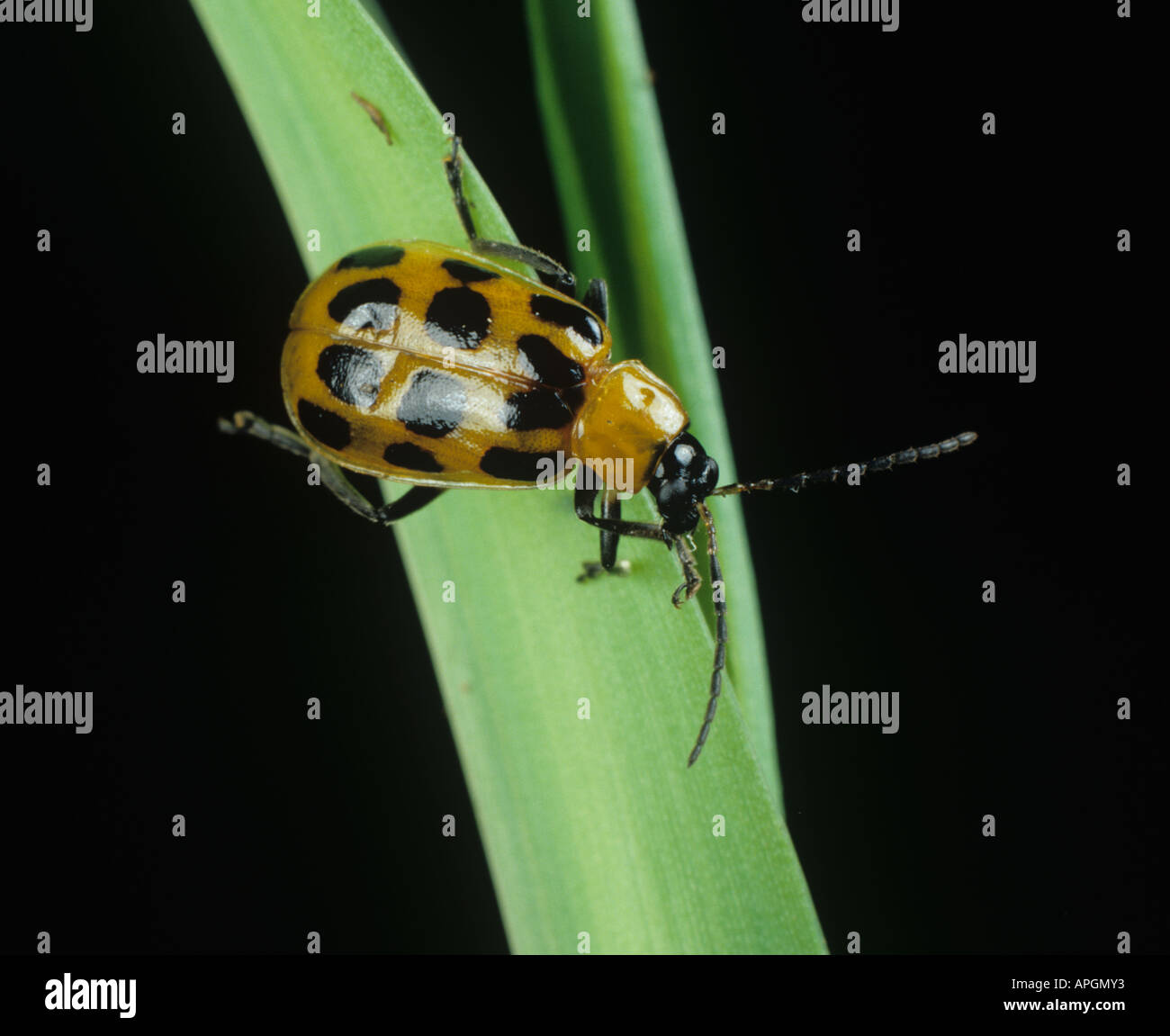 Spotted cucumber beetle Diabrotica sp adult on maize plant Stock Photohttps://www.alamy.com/image-license-details/?v=1https://www.alamy.com/spotted-cucumber-beetle-diabrotica-sp-adult-on-maize-plant-image9021362.html
Spotted cucumber beetle Diabrotica sp adult on maize plant Stock Photohttps://www.alamy.com/image-license-details/?v=1https://www.alamy.com/spotted-cucumber-beetle-diabrotica-sp-adult-on-maize-plant-image9021362.htmlRMAPGMY3–Spotted cucumber beetle Diabrotica sp adult on maize plant
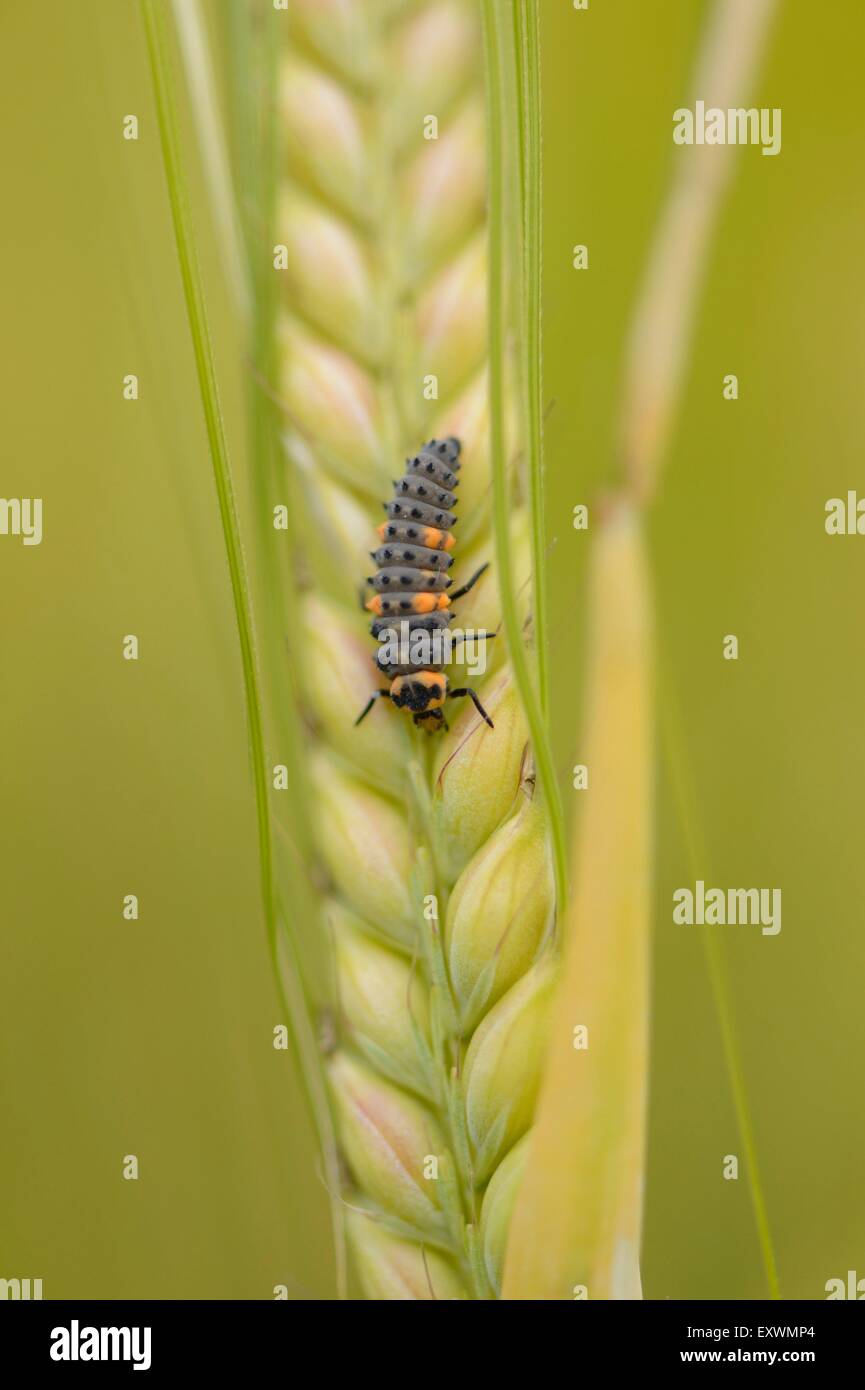 Seven-spot ladybird grub on barley Stock Photohttps://www.alamy.com/image-license-details/?v=1https://www.alamy.com/stock-photo-seven-spot-ladybird-grub-on-barley-85387628.html
Seven-spot ladybird grub on barley Stock Photohttps://www.alamy.com/image-license-details/?v=1https://www.alamy.com/stock-photo-seven-spot-ladybird-grub-on-barley-85387628.htmlRMEXWMP4–Seven-spot ladybird grub on barley
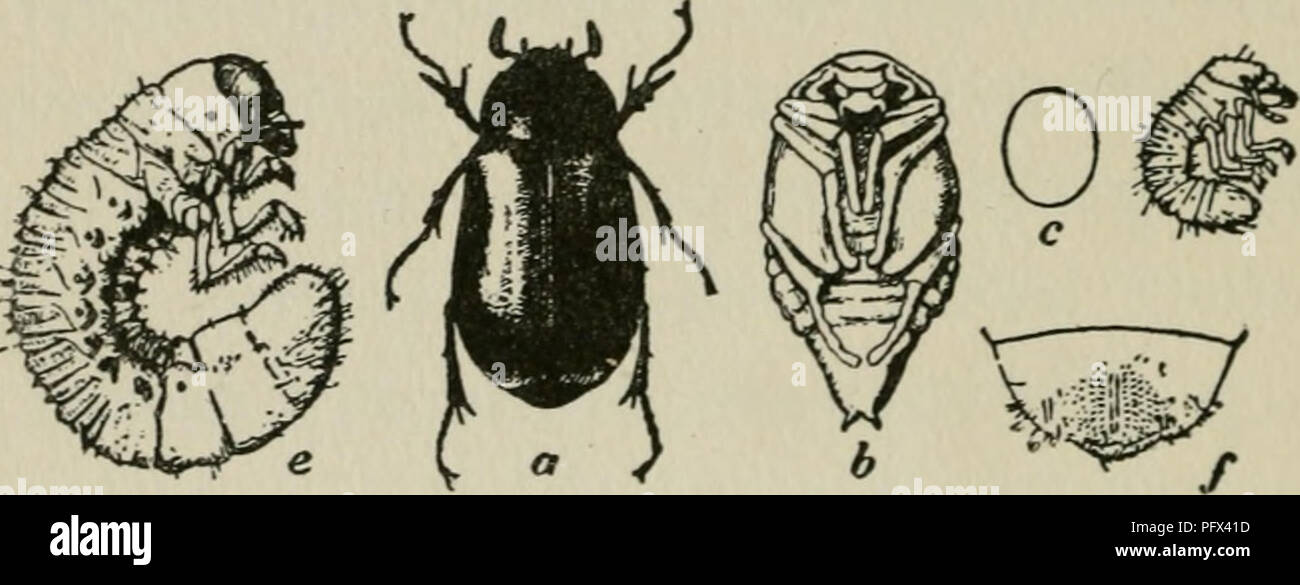 . The culture and diseases of the sweet pea. 174 DISEASES OF THE SWEET PEA Differing from cut worms, wireworms pass from tfiree to five years in the larvae stage; hence wireworms of different ages may be found in the same place feeding side by side. White Grubs. Lachno sterna sp. White grubs are the larvae of May beetles (fig. 40 ^ to /). They are injurious to a. FIG. 40. WHITE GRUB OR MAY BEETLE, O BEETLE. 6 PUPA. C FULL GROWN LARVA OR WHITE GRUB. (AFTER CHITTENDEN.) number of cultivated plants, the sweet pea being included. May beetles lay their eggs in sod, in corn fields, or in the garden. Stock Photohttps://www.alamy.com/image-license-details/?v=1https://www.alamy.com/the-culture-and-diseases-of-the-sweet-pea-174-diseases-of-the-sweet-pea-differing-from-cut-worms-wireworms-pass-from-tfiree-to-five-years-in-the-larvae-stage-hence-wireworms-of-different-ages-may-be-found-in-the-same-place-feeding-side-by-side-white-grubs-lachno-sterna-sp-white-grubs-are-the-larvae-of-may-beetles-fig-40-to-they-are-injurious-to-a-fig-40-white-grub-or-may-beetle-o-beetle-6-pupa-c-full-grown-larva-or-white-grub-after-chittenden-number-of-cultivated-plants-the-sweet-pea-being-included-may-beetles-lay-their-eggs-in-sod-in-corn-fields-or-in-the-garden-image216318185.html
. The culture and diseases of the sweet pea. 174 DISEASES OF THE SWEET PEA Differing from cut worms, wireworms pass from tfiree to five years in the larvae stage; hence wireworms of different ages may be found in the same place feeding side by side. White Grubs. Lachno sterna sp. White grubs are the larvae of May beetles (fig. 40 ^ to /). They are injurious to a. FIG. 40. WHITE GRUB OR MAY BEETLE, O BEETLE. 6 PUPA. C FULL GROWN LARVA OR WHITE GRUB. (AFTER CHITTENDEN.) number of cultivated plants, the sweet pea being included. May beetles lay their eggs in sod, in corn fields, or in the garden. Stock Photohttps://www.alamy.com/image-license-details/?v=1https://www.alamy.com/the-culture-and-diseases-of-the-sweet-pea-174-diseases-of-the-sweet-pea-differing-from-cut-worms-wireworms-pass-from-tfiree-to-five-years-in-the-larvae-stage-hence-wireworms-of-different-ages-may-be-found-in-the-same-place-feeding-side-by-side-white-grubs-lachno-sterna-sp-white-grubs-are-the-larvae-of-may-beetles-fig-40-to-they-are-injurious-to-a-fig-40-white-grub-or-may-beetle-o-beetle-6-pupa-c-full-grown-larva-or-white-grub-after-chittenden-number-of-cultivated-plants-the-sweet-pea-being-included-may-beetles-lay-their-eggs-in-sod-in-corn-fields-or-in-the-garden-image216318185.htmlRMPFX41D–. The culture and diseases of the sweet pea. 174 DISEASES OF THE SWEET PEA Differing from cut worms, wireworms pass from tfiree to five years in the larvae stage; hence wireworms of different ages may be found in the same place feeding side by side. White Grubs. Lachno sterna sp. White grubs are the larvae of May beetles (fig. 40 ^ to /). They are injurious to a. FIG. 40. WHITE GRUB OR MAY BEETLE, O BEETLE. 6 PUPA. C FULL GROWN LARVA OR WHITE GRUB. (AFTER CHITTENDEN.) number of cultivated plants, the sweet pea being included. May beetles lay their eggs in sod, in corn fields, or in the garden.
![. Elementary entomology . FIG. 254. The granary weevil (Calandra granaria]. (Enlarged) rt, beetle ; l>, larva; c, pupa; d, the adult rice weevil (Calandra otyza}. (After Chittenden, United States Department of Agriculture) sculptured. They attack corn, timothy, and other grasses, particu- larly the coarse swamp grasses and sedges. The fat white larvae Stock Photo . Elementary entomology . FIG. 254. The granary weevil (Calandra granaria]. (Enlarged) rt, beetle ; l>, larva; c, pupa; d, the adult rice weevil (Calandra otyza}. (After Chittenden, United States Department of Agriculture) sculptured. They attack corn, timothy, and other grasses, particu- larly the coarse swamp grasses and sedges. The fat white larvae Stock Photo](https://c8.alamy.com/comp/MA712T/elementary-entomology-fig-254-the-granary-weevil-calandra-granaria-enlarged-rt-beetle-lgt-larva-c-pupa-d-the-adult-rice-weevil-calandra-otyza-after-chittenden-united-states-department-of-agriculture-sculptured-they-attack-corn-timothy-and-other-grasses-particu-larly-the-coarse-swamp-grasses-and-sedges-the-fat-white-larvae-MA712T.jpg) . Elementary entomology . FIG. 254. The granary weevil (Calandra granaria]. (Enlarged) rt, beetle ; l>, larva; c, pupa; d, the adult rice weevil (Calandra otyza}. (After Chittenden, United States Department of Agriculture) sculptured. They attack corn, timothy, and other grasses, particu- larly the coarse swamp grasses and sedges. The fat white larvae Stock Photohttps://www.alamy.com/image-license-details/?v=1https://www.alamy.com/elementary-entomology-fig-254-the-granary-weevil-calandra-granaria-enlarged-rt-beetle-lgt-larva-c-pupa-d-the-adult-rice-weevil-calandra-otyza-after-chittenden-united-states-department-of-agriculture-sculptured-they-attack-corn-timothy-and-other-grasses-particu-larly-the-coarse-swamp-grasses-and-sedges-the-fat-white-larvae-image178404768.html
. Elementary entomology . FIG. 254. The granary weevil (Calandra granaria]. (Enlarged) rt, beetle ; l>, larva; c, pupa; d, the adult rice weevil (Calandra otyza}. (After Chittenden, United States Department of Agriculture) sculptured. They attack corn, timothy, and other grasses, particu- larly the coarse swamp grasses and sedges. The fat white larvae Stock Photohttps://www.alamy.com/image-license-details/?v=1https://www.alamy.com/elementary-entomology-fig-254-the-granary-weevil-calandra-granaria-enlarged-rt-beetle-lgt-larva-c-pupa-d-the-adult-rice-weevil-calandra-otyza-after-chittenden-united-states-department-of-agriculture-sculptured-they-attack-corn-timothy-and-other-grasses-particu-larly-the-coarse-swamp-grasses-and-sedges-the-fat-white-larvae-image178404768.htmlRMMA712T–. Elementary entomology . FIG. 254. The granary weevil (Calandra granaria]. (Enlarged) rt, beetle ; l>, larva; c, pupa; d, the adult rice weevil (Calandra otyza}. (After Chittenden, United States Department of Agriculture) sculptured. They attack corn, timothy, and other grasses, particu- larly the coarse swamp grasses and sedges. The fat white larvae
![Elementary entomology ([c1912]) Elementary entomology . elementaryentomo00sand Year: [c1912] FIG. 254. The granary weevil (Calandra granaria]. (Enlarged) rt, beetle ; l>, larva; c, pupa; d, the adult rice weevil (Calandra otyza}. (After Chittenden, United States Department of Agriculture) sculptured. They attack corn, timothy, and other grasses, particu- larly the coarse swamp grasses and sedges. The fat white larvae Stock Photo Elementary entomology ([c1912]) Elementary entomology . elementaryentomo00sand Year: [c1912] FIG. 254. The granary weevil (Calandra granaria]. (Enlarged) rt, beetle ; l>, larva; c, pupa; d, the adult rice weevil (Calandra otyza}. (After Chittenden, United States Department of Agriculture) sculptured. They attack corn, timothy, and other grasses, particu- larly the coarse swamp grasses and sedges. The fat white larvae Stock Photo](https://c8.alamy.com/comp/RYT6H3/elementary-entomology-c1912-elementary-entomology-elementaryentomo00sand-year-c1912-fig-254-the-granary-weevil-calandra-granaria-enlarged-rt-beetle-lgt-larva-c-pupa-d-the-adult-rice-weevil-calandra-otyza-after-chittenden-united-states-department-of-agriculture-sculptured-they-attack-corn-timothy-and-other-grasses-particu-larly-the-coarse-swamp-grasses-and-sedges-the-fat-white-larvae-RYT6H3.jpg) Elementary entomology ([c1912]) Elementary entomology . elementaryentomo00sand Year: [c1912] FIG. 254. The granary weevil (Calandra granaria]. (Enlarged) rt, beetle ; l>, larva; c, pupa; d, the adult rice weevil (Calandra otyza}. (After Chittenden, United States Department of Agriculture) sculptured. They attack corn, timothy, and other grasses, particu- larly the coarse swamp grasses and sedges. The fat white larvae Stock Photohttps://www.alamy.com/image-license-details/?v=1https://www.alamy.com/elementary-entomology-c1912-elementary-entomology-elementaryentomo00sand-year-c1912-fig-254-the-granary-weevil-calandra-granaria-enlarged-rt-beetle-lgt-larva-c-pupa-d-the-adult-rice-weevil-calandra-otyza-after-chittenden-united-states-department-of-agriculture-sculptured-they-attack-corn-timothy-and-other-grasses-particu-larly-the-coarse-swamp-grasses-and-sedges-the-fat-white-larvae-image240862527.html
Elementary entomology ([c1912]) Elementary entomology . elementaryentomo00sand Year: [c1912] FIG. 254. The granary weevil (Calandra granaria]. (Enlarged) rt, beetle ; l>, larva; c, pupa; d, the adult rice weevil (Calandra otyza}. (After Chittenden, United States Department of Agriculture) sculptured. They attack corn, timothy, and other grasses, particu- larly the coarse swamp grasses and sedges. The fat white larvae Stock Photohttps://www.alamy.com/image-license-details/?v=1https://www.alamy.com/elementary-entomology-c1912-elementary-entomology-elementaryentomo00sand-year-c1912-fig-254-the-granary-weevil-calandra-granaria-enlarged-rt-beetle-lgt-larva-c-pupa-d-the-adult-rice-weevil-calandra-otyza-after-chittenden-united-states-department-of-agriculture-sculptured-they-attack-corn-timothy-and-other-grasses-particu-larly-the-coarse-swamp-grasses-and-sedges-the-fat-white-larvae-image240862527.htmlRMRYT6H3–Elementary entomology ([c1912]) Elementary entomology . elementaryentomo00sand Year: [c1912] FIG. 254. The granary weevil (Calandra granaria]. (Enlarged) rt, beetle ; l>, larva; c, pupa; d, the adult rice weevil (Calandra otyza}. (After Chittenden, United States Department of Agriculture) sculptured. They attack corn, timothy, and other grasses, particu- larly the coarse swamp grasses and sedges. The fat white larvae
 Larva and damaged cereal plant by corn ground beetle (Zabrus tenebrioides) is a species of black ground beetle (Carabidae). A pest in soil Stock Photohttps://www.alamy.com/image-license-details/?v=1https://www.alamy.com/larva-and-damaged-cereal-plant-by-corn-ground-beetle-zabrus-tenebrioides-is-a-species-of-black-ground-beetle-carabidae-a-pest-in-soil-image451829611.html
Larva and damaged cereal plant by corn ground beetle (Zabrus tenebrioides) is a species of black ground beetle (Carabidae). A pest in soil Stock Photohttps://www.alamy.com/image-license-details/?v=1https://www.alamy.com/larva-and-damaged-cereal-plant-by-corn-ground-beetle-zabrus-tenebrioides-is-a-species-of-black-ground-beetle-carabidae-a-pest-in-soil-image451829611.htmlRF2H72H7R–Larva and damaged cereal plant by corn ground beetle (Zabrus tenebrioides) is a species of black ground beetle (Carabidae). A pest in soil
 Corn; growing, judging, breeding, feeding, marketing; for the farmer and student of agriculture, a text-book for agricultural colleges and high schools . FIG. C. FIG. D Charlotte M. King. Artist PLATE VIII. Corn Root Wokm, {Diabrotica lungicurnis). A, Beetle; 13, Iupa; C, Larva; U, Larva1 Corn Koot. i COMPARATIVE GROWTH. 249 Stock Photohttps://www.alamy.com/image-license-details/?v=1https://www.alamy.com/corn-growing-judging-breeding-feeding-marketing-for-the-farmer-and-student-of-agriculture-a-text-book-for-agricultural-colleges-and-high-schools-fig-c-fig-d-charlotte-m-king-artist-plate-viii-corn-root-wokm-diabrotica-lungicurnis-a-beetle-13-iupa-c-larva-u-larva1-corn-koot-i-comparative-growth-249-image343015082.html
Corn; growing, judging, breeding, feeding, marketing; for the farmer and student of agriculture, a text-book for agricultural colleges and high schools . FIG. C. FIG. D Charlotte M. King. Artist PLATE VIII. Corn Root Wokm, {Diabrotica lungicurnis). A, Beetle; 13, Iupa; C, Larva; U, Larva1 Corn Koot. i COMPARATIVE GROWTH. 249 Stock Photohttps://www.alamy.com/image-license-details/?v=1https://www.alamy.com/corn-growing-judging-breeding-feeding-marketing-for-the-farmer-and-student-of-agriculture-a-text-book-for-agricultural-colleges-and-high-schools-fig-c-fig-d-charlotte-m-king-artist-plate-viii-corn-root-wokm-diabrotica-lungicurnis-a-beetle-13-iupa-c-larva-u-larva1-corn-koot-i-comparative-growth-249-image343015082.htmlRM2AX1K6J–Corn; growing, judging, breeding, feeding, marketing; for the farmer and student of agriculture, a text-book for agricultural colleges and high schools . FIG. C. FIG. D Charlotte M. King. Artist PLATE VIII. Corn Root Wokm, {Diabrotica lungicurnis). A, Beetle; 13, Iupa; C, Larva; U, Larva1 Corn Koot. i COMPARATIVE GROWTH. 249
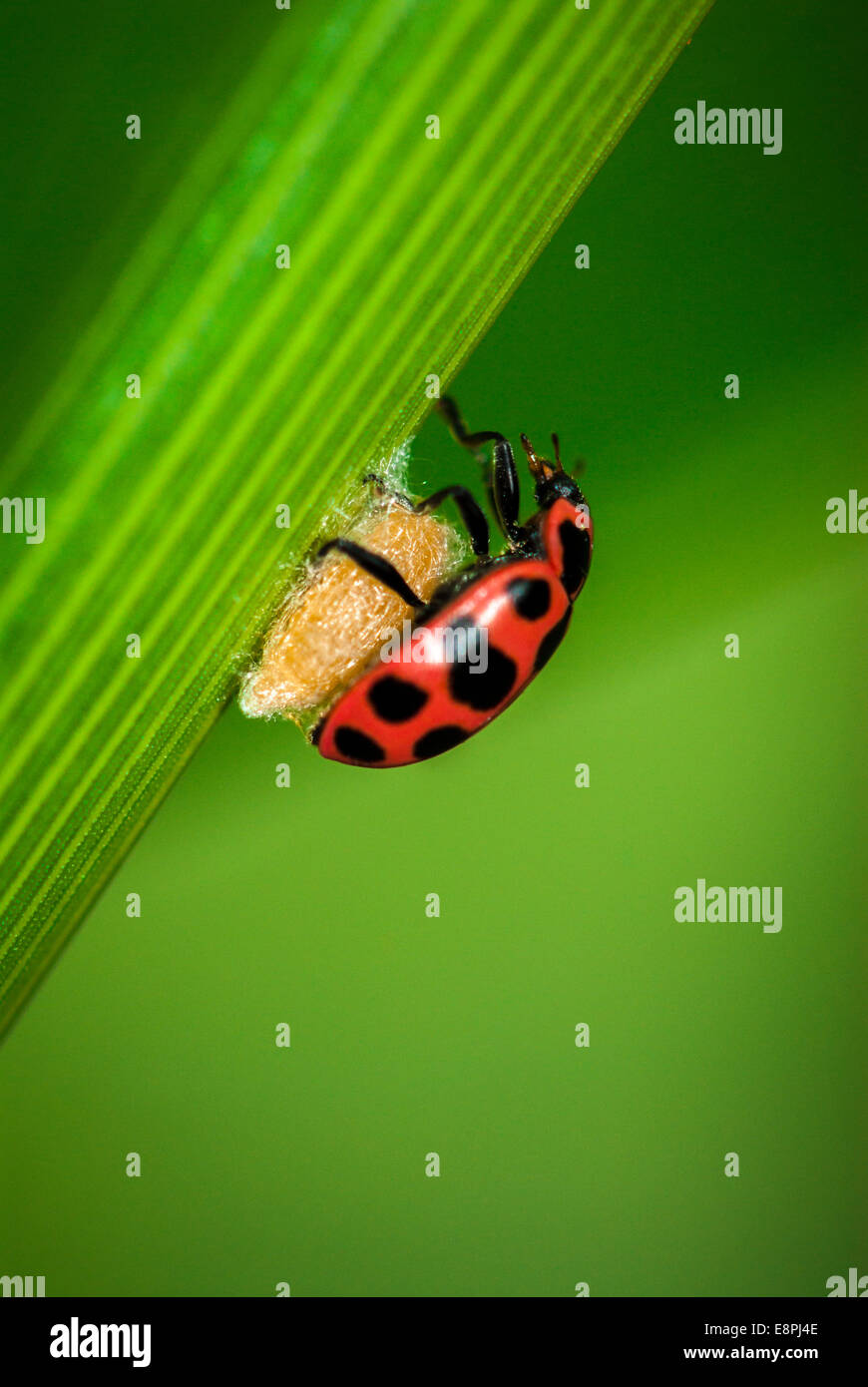 A ladybird (Coleomegilla maculata) on top of a parasitoid cocoon (Dinocampus coccinellae) as seen on a leaf in a cornfield. Stock Photohttps://www.alamy.com/image-license-details/?v=1https://www.alamy.com/stock-photo-a-ladybird-coleomegilla-maculata-on-top-of-a-parasitoid-cocoon-dinocampus-74255902.html
A ladybird (Coleomegilla maculata) on top of a parasitoid cocoon (Dinocampus coccinellae) as seen on a leaf in a cornfield. Stock Photohttps://www.alamy.com/image-license-details/?v=1https://www.alamy.com/stock-photo-a-ladybird-coleomegilla-maculata-on-top-of-a-parasitoid-cocoon-dinocampus-74255902.htmlRME8PJ4E–A ladybird (Coleomegilla maculata) on top of a parasitoid cocoon (Dinocampus coccinellae) as seen on a leaf in a cornfield.
 . The culture and diseases of the sweet pea. Sweet peas; Sweet peas. 174 DISEASES OF THE SWEET PEA Differing from cut worms, wireworms pass from three to five years in the larvae stage; hence wireworms of different ages may be found in the same place feeding side by side. White Grubs. Lachnosterna sp. White grubs are the larvae of May beetles (fig. 40 a to /). They are injurious to a. FIG. 40. WHITE GRUB OR MAY BEETLE, a BEETLE. b PUPA. C FULL GROWN LARVA OR WHITE GRUB. (AFTER CHITTENDEN.) number of cultivated plants, the sweet pea being included. May beetles lay their eggs in sod, in corn fie Stock Photohttps://www.alamy.com/image-license-details/?v=1https://www.alamy.com/the-culture-and-diseases-of-the-sweet-pea-sweet-peas-sweet-peas-174-diseases-of-the-sweet-pea-differing-from-cut-worms-wireworms-pass-from-three-to-five-years-in-the-larvae-stage-hence-wireworms-of-different-ages-may-be-found-in-the-same-place-feeding-side-by-side-white-grubs-lachnosterna-sp-white-grubs-are-the-larvae-of-may-beetles-fig-40-a-to-they-are-injurious-to-a-fig-40-white-grub-or-may-beetle-a-beetle-b-pupa-c-full-grown-larva-or-white-grub-after-chittenden-number-of-cultivated-plants-the-sweet-pea-being-included-may-beetles-lay-their-eggs-in-sod-in-corn-fie-image216318174.html
. The culture and diseases of the sweet pea. Sweet peas; Sweet peas. 174 DISEASES OF THE SWEET PEA Differing from cut worms, wireworms pass from three to five years in the larvae stage; hence wireworms of different ages may be found in the same place feeding side by side. White Grubs. Lachnosterna sp. White grubs are the larvae of May beetles (fig. 40 a to /). They are injurious to a. FIG. 40. WHITE GRUB OR MAY BEETLE, a BEETLE. b PUPA. C FULL GROWN LARVA OR WHITE GRUB. (AFTER CHITTENDEN.) number of cultivated plants, the sweet pea being included. May beetles lay their eggs in sod, in corn fie Stock Photohttps://www.alamy.com/image-license-details/?v=1https://www.alamy.com/the-culture-and-diseases-of-the-sweet-pea-sweet-peas-sweet-peas-174-diseases-of-the-sweet-pea-differing-from-cut-worms-wireworms-pass-from-three-to-five-years-in-the-larvae-stage-hence-wireworms-of-different-ages-may-be-found-in-the-same-place-feeding-side-by-side-white-grubs-lachnosterna-sp-white-grubs-are-the-larvae-of-may-beetles-fig-40-a-to-they-are-injurious-to-a-fig-40-white-grub-or-may-beetle-a-beetle-b-pupa-c-full-grown-larva-or-white-grub-after-chittenden-number-of-cultivated-plants-the-sweet-pea-being-included-may-beetles-lay-their-eggs-in-sod-in-corn-fie-image216318174.htmlRMPFX412–. The culture and diseases of the sweet pea. Sweet peas; Sweet peas. 174 DISEASES OF THE SWEET PEA Differing from cut worms, wireworms pass from three to five years in the larvae stage; hence wireworms of different ages may be found in the same place feeding side by side. White Grubs. Lachnosterna sp. White grubs are the larvae of May beetles (fig. 40 a to /). They are injurious to a. FIG. 40. WHITE GRUB OR MAY BEETLE, a BEETLE. b PUPA. C FULL GROWN LARVA OR WHITE GRUB. (AFTER CHITTENDEN.) number of cultivated plants, the sweet pea being included. May beetles lay their eggs in sod, in corn fie
 . Elementary entomology . Fig. 223. Striped cucumber-beetle Striped cucumber-beetle {Diahrotica vittatd) is about the same size, bright yellow with black stripes, and is one of the worst pests of young cucumber and melon vines. The larvae are long, slender whitish grubs which feed on the roots. The twelve-spotted Diabrotica is green with twelve black spots, with similar food habits in the adult stage, but in the South the larvae do serious injury to the roots of corn, while the larva of another pale green species, Stock Photohttps://www.alamy.com/image-license-details/?v=1https://www.alamy.com/elementary-entomology-fig-223-striped-cucumber-beetle-striped-cucumber-beetle-diahrotica-vittatd-is-about-the-same-size-bright-yellow-with-black-stripes-and-is-one-of-the-worst-pests-of-young-cucumber-and-melon-vines-the-larvae-are-long-slender-whitish-grubs-which-feed-on-the-roots-the-twelve-spotted-diabrotica-is-green-with-twelve-black-spots-with-similar-food-habits-in-the-adult-stage-but-in-the-south-the-larvae-do-serious-injury-to-the-roots-of-corn-while-the-larva-of-another-pale-green-species-image178412286.html
. Elementary entomology . Fig. 223. Striped cucumber-beetle Striped cucumber-beetle {Diahrotica vittatd) is about the same size, bright yellow with black stripes, and is one of the worst pests of young cucumber and melon vines. The larvae are long, slender whitish grubs which feed on the roots. The twelve-spotted Diabrotica is green with twelve black spots, with similar food habits in the adult stage, but in the South the larvae do serious injury to the roots of corn, while the larva of another pale green species, Stock Photohttps://www.alamy.com/image-license-details/?v=1https://www.alamy.com/elementary-entomology-fig-223-striped-cucumber-beetle-striped-cucumber-beetle-diahrotica-vittatd-is-about-the-same-size-bright-yellow-with-black-stripes-and-is-one-of-the-worst-pests-of-young-cucumber-and-melon-vines-the-larvae-are-long-slender-whitish-grubs-which-feed-on-the-roots-the-twelve-spotted-diabrotica-is-green-with-twelve-black-spots-with-similar-food-habits-in-the-adult-stage-but-in-the-south-the-larvae-do-serious-injury-to-the-roots-of-corn-while-the-larva-of-another-pale-green-species-image178412286.htmlRMMA7AKA–. Elementary entomology . Fig. 223. Striped cucumber-beetle Striped cucumber-beetle {Diahrotica vittatd) is about the same size, bright yellow with black stripes, and is one of the worst pests of young cucumber and melon vines. The larvae are long, slender whitish grubs which feed on the roots. The twelve-spotted Diabrotica is green with twelve black spots, with similar food habits in the adult stage, but in the South the larvae do serious injury to the roots of corn, while the larva of another pale green species,
![Elementary entomology ([c1912]) Elementary entomology . elementaryentomo00sand Year: [c1912] THE BEETLES 169 The bill-bugs (Calandridae) are from one fourth to one half of an inch long, black, brown, or dark gray, with hard elytra, ridged and FIG. 254. The granary weevil (Calandra granaria]. (Enlarged) rt, beetle ; l>, larva; c, pupa; d, the adult rice weevil (Calandra otyza}. (After Chittenden, United States Department of Agriculture) sculptured. They attack corn, timothy, and other grasses, particu- larly the coarse swamp grasses and sedges. The fat white larvae Stock Photo Elementary entomology ([c1912]) Elementary entomology . elementaryentomo00sand Year: [c1912] THE BEETLES 169 The bill-bugs (Calandridae) are from one fourth to one half of an inch long, black, brown, or dark gray, with hard elytra, ridged and FIG. 254. The granary weevil (Calandra granaria]. (Enlarged) rt, beetle ; l>, larva; c, pupa; d, the adult rice weevil (Calandra otyza}. (After Chittenden, United States Department of Agriculture) sculptured. They attack corn, timothy, and other grasses, particu- larly the coarse swamp grasses and sedges. The fat white larvae Stock Photo](https://c8.alamy.com/comp/RYT6H4/elementary-entomology-c1912-elementary-entomology-elementaryentomo00sand-year-c1912-the-beetles-169-the-bill-bugs-calandridae-are-from-one-fourth-to-one-half-of-an-inch-long-black-brown-or-dark-gray-with-hard-elytra-ridged-and-fig-254-the-granary-weevil-calandra-granaria-enlarged-rt-beetle-lgt-larva-c-pupa-d-the-adult-rice-weevil-calandra-otyza-after-chittenden-united-states-department-of-agriculture-sculptured-they-attack-corn-timothy-and-other-grasses-particu-larly-the-coarse-swamp-grasses-and-sedges-the-fat-white-larvae-RYT6H4.jpg) Elementary entomology ([c1912]) Elementary entomology . elementaryentomo00sand Year: [c1912] THE BEETLES 169 The bill-bugs (Calandridae) are from one fourth to one half of an inch long, black, brown, or dark gray, with hard elytra, ridged and FIG. 254. The granary weevil (Calandra granaria]. (Enlarged) rt, beetle ; l>, larva; c, pupa; d, the adult rice weevil (Calandra otyza}. (After Chittenden, United States Department of Agriculture) sculptured. They attack corn, timothy, and other grasses, particu- larly the coarse swamp grasses and sedges. The fat white larvae Stock Photohttps://www.alamy.com/image-license-details/?v=1https://www.alamy.com/elementary-entomology-c1912-elementary-entomology-elementaryentomo00sand-year-c1912-the-beetles-169-the-bill-bugs-calandridae-are-from-one-fourth-to-one-half-of-an-inch-long-black-brown-or-dark-gray-with-hard-elytra-ridged-and-fig-254-the-granary-weevil-calandra-granaria-enlarged-rt-beetle-lgt-larva-c-pupa-d-the-adult-rice-weevil-calandra-otyza-after-chittenden-united-states-department-of-agriculture-sculptured-they-attack-corn-timothy-and-other-grasses-particu-larly-the-coarse-swamp-grasses-and-sedges-the-fat-white-larvae-image240862528.html
Elementary entomology ([c1912]) Elementary entomology . elementaryentomo00sand Year: [c1912] THE BEETLES 169 The bill-bugs (Calandridae) are from one fourth to one half of an inch long, black, brown, or dark gray, with hard elytra, ridged and FIG. 254. The granary weevil (Calandra granaria]. (Enlarged) rt, beetle ; l>, larva; c, pupa; d, the adult rice weevil (Calandra otyza}. (After Chittenden, United States Department of Agriculture) sculptured. They attack corn, timothy, and other grasses, particu- larly the coarse swamp grasses and sedges. The fat white larvae Stock Photohttps://www.alamy.com/image-license-details/?v=1https://www.alamy.com/elementary-entomology-c1912-elementary-entomology-elementaryentomo00sand-year-c1912-the-beetles-169-the-bill-bugs-calandridae-are-from-one-fourth-to-one-half-of-an-inch-long-black-brown-or-dark-gray-with-hard-elytra-ridged-and-fig-254-the-granary-weevil-calandra-granaria-enlarged-rt-beetle-lgt-larva-c-pupa-d-the-adult-rice-weevil-calandra-otyza-after-chittenden-united-states-department-of-agriculture-sculptured-they-attack-corn-timothy-and-other-grasses-particu-larly-the-coarse-swamp-grasses-and-sedges-the-fat-white-larvae-image240862528.htmlRMRYT6H4–Elementary entomology ([c1912]) Elementary entomology . elementaryentomo00sand Year: [c1912] THE BEETLES 169 The bill-bugs (Calandridae) are from one fourth to one half of an inch long, black, brown, or dark gray, with hard elytra, ridged and FIG. 254. The granary weevil (Calandra granaria]. (Enlarged) rt, beetle ; l>, larva; c, pupa; d, the adult rice weevil (Calandra otyza}. (After Chittenden, United States Department of Agriculture) sculptured. They attack corn, timothy, and other grasses, particu- larly the coarse swamp grasses and sedges. The fat white larvae
 Larva and damaged cereal plant by corn ground beetle (Zabrus tenebrioides) - a pest in soil. It is a species of black ground beetle (Carabidae). Stock Photohttps://www.alamy.com/image-license-details/?v=1https://www.alamy.com/larva-and-damaged-cereal-plant-by-corn-ground-beetle-zabrus-tenebrioides-a-pest-in-soil-it-is-a-species-of-black-ground-beetle-carabidae-image451829641.html
Larva and damaged cereal plant by corn ground beetle (Zabrus tenebrioides) - a pest in soil. It is a species of black ground beetle (Carabidae). Stock Photohttps://www.alamy.com/image-license-details/?v=1https://www.alamy.com/larva-and-damaged-cereal-plant-by-corn-ground-beetle-zabrus-tenebrioides-a-pest-in-soil-it-is-a-species-of-black-ground-beetle-carabidae-image451829641.htmlRF2H72H8W–Larva and damaged cereal plant by corn ground beetle (Zabrus tenebrioides) - a pest in soil. It is a species of black ground beetle (Carabidae).
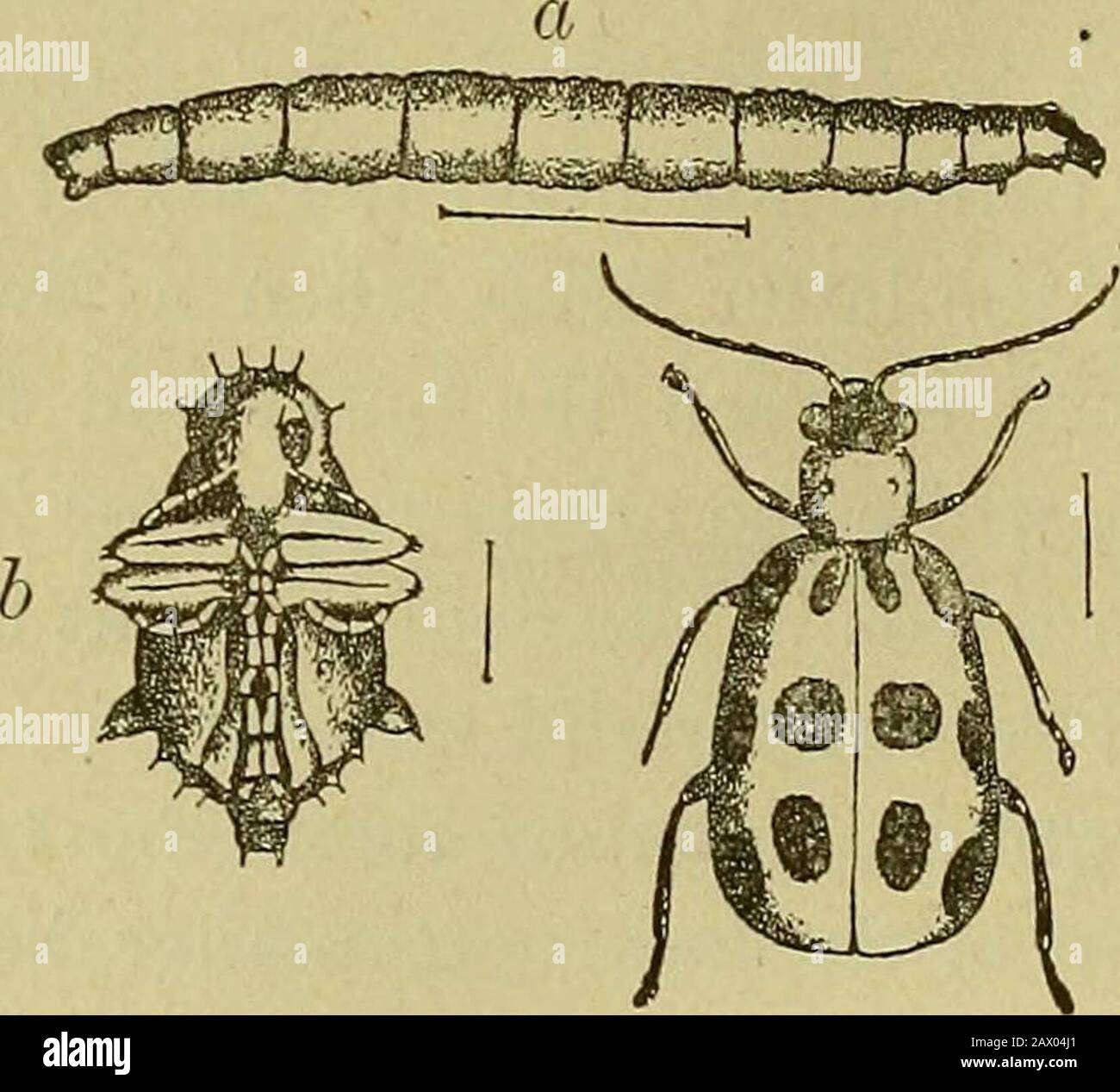 Insects and insecticidesA practical manual concerning noxious insects and the methods of preventing their injuries . is insect are representedat Fig. 112. The larva (a) is a slender, whitishworm, about half an inch long, resembling the West-ern Corn Root-worm, to which, in fact, it is closelyrelated. It feeds promiscuously upon the roots and base of the stalk ofcorn, pupating in thesoil about the roots,and emerging short-ly afterwards as a3rellow beetle with 12black spots upon theback (c). There aretwo broods each sea-son, eggs for the firstbrood being depos- Fig. 112. Southern Corn Root-worm: Stock Photohttps://www.alamy.com/image-license-details/?v=1https://www.alamy.com/insects-and-insecticidesa-practical-manual-concerning-noxious-insects-and-the-methods-of-preventing-their-injuries-is-insect-are-representedat-fig-112-the-larva-a-is-a-slender-whitishworm-about-half-an-inch-long-resembling-the-west-ern-corn-root-worm-to-which-in-fact-it-is-closelyrelated-it-feeds-promiscuously-upon-the-roots-and-base-of-the-stalk-ofcorn-pupating-in-thesoil-about-the-rootsand-emerging-short-ly-afterwards-as-a3rellow-beetle-with-12black-spots-upon-theback-c-there-aretwo-broods-each-sea-son-eggs-for-the-firstbrood-being-depos-fig-112-southern-corn-root-worm-image342981689.html
Insects and insecticidesA practical manual concerning noxious insects and the methods of preventing their injuries . is insect are representedat Fig. 112. The larva (a) is a slender, whitishworm, about half an inch long, resembling the West-ern Corn Root-worm, to which, in fact, it is closelyrelated. It feeds promiscuously upon the roots and base of the stalk ofcorn, pupating in thesoil about the roots,and emerging short-ly afterwards as a3rellow beetle with 12black spots upon theback (c). There aretwo broods each sea-son, eggs for the firstbrood being depos- Fig. 112. Southern Corn Root-worm: Stock Photohttps://www.alamy.com/image-license-details/?v=1https://www.alamy.com/insects-and-insecticidesa-practical-manual-concerning-noxious-insects-and-the-methods-of-preventing-their-injuries-is-insect-are-representedat-fig-112-the-larva-a-is-a-slender-whitishworm-about-half-an-inch-long-resembling-the-west-ern-corn-root-worm-to-which-in-fact-it-is-closelyrelated-it-feeds-promiscuously-upon-the-roots-and-base-of-the-stalk-ofcorn-pupating-in-thesoil-about-the-rootsand-emerging-short-ly-afterwards-as-a3rellow-beetle-with-12black-spots-upon-theback-c-there-aretwo-broods-each-sea-son-eggs-for-the-firstbrood-being-depos-fig-112-southern-corn-root-worm-image342981689.htmlRM2AX04J1–Insects and insecticidesA practical manual concerning noxious insects and the methods of preventing their injuries . is insect are representedat Fig. 112. The larva (a) is a slender, whitishworm, about half an inch long, resembling the West-ern Corn Root-worm, to which, in fact, it is closelyrelated. It feeds promiscuously upon the roots and base of the stalk ofcorn, pupating in thesoil about the roots,and emerging short-ly afterwards as a3rellow beetle with 12black spots upon theback (c). There aretwo broods each sea-son, eggs for the firstbrood being depos- Fig. 112. Southern Corn Root-worm:
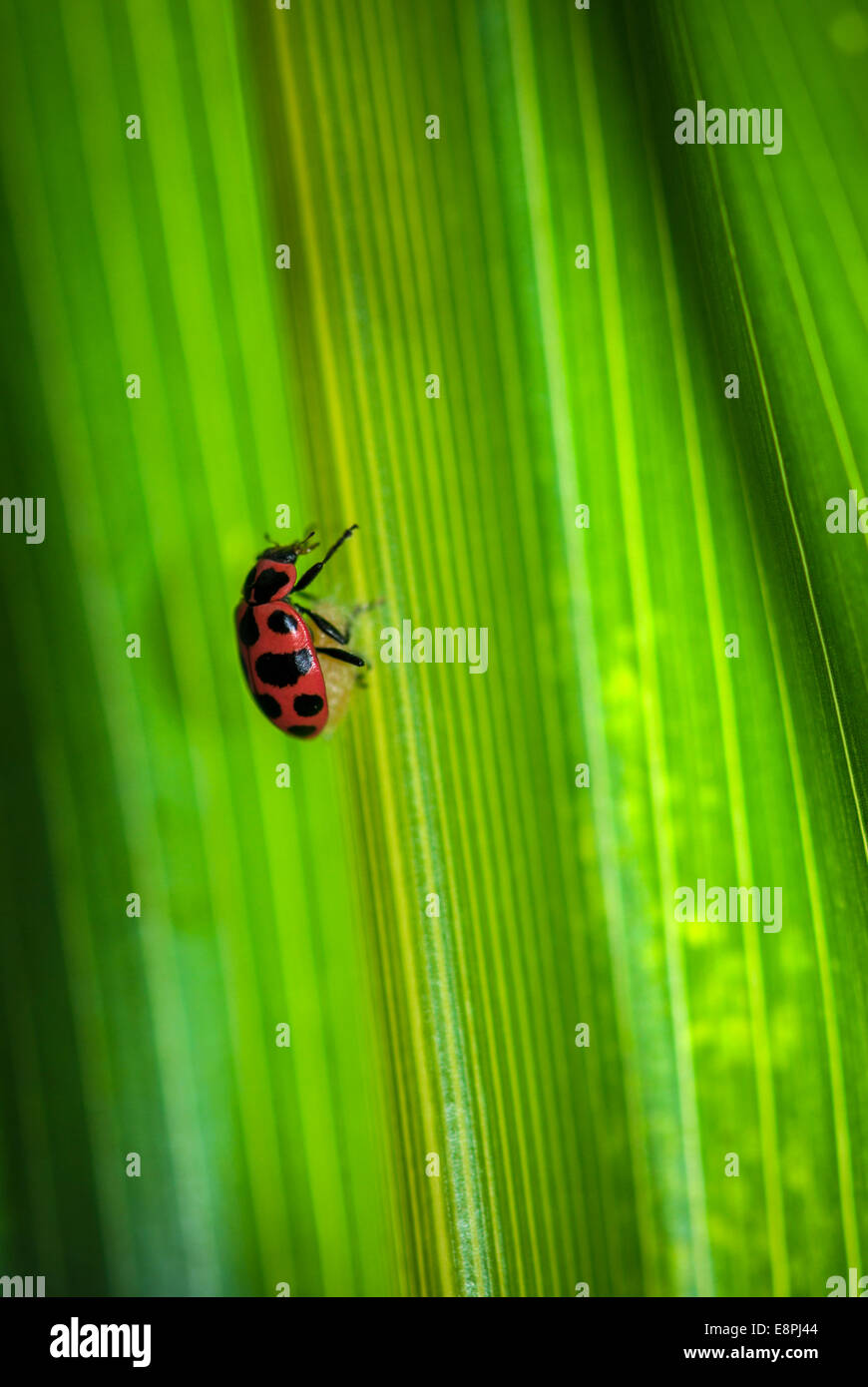 A ladybird (Coleomegilla maculata) on top of a parasitoid cocoon (Dinocampus coccinellae) as seen on a leaf in a cornfield. Stock Photohttps://www.alamy.com/image-license-details/?v=1https://www.alamy.com/stock-photo-a-ladybird-coleomegilla-maculata-on-top-of-a-parasitoid-cocoon-dinocampus-74255892.html
A ladybird (Coleomegilla maculata) on top of a parasitoid cocoon (Dinocampus coccinellae) as seen on a leaf in a cornfield. Stock Photohttps://www.alamy.com/image-license-details/?v=1https://www.alamy.com/stock-photo-a-ladybird-coleomegilla-maculata-on-top-of-a-parasitoid-cocoon-dinocampus-74255892.htmlRME8PJ44–A ladybird (Coleomegilla maculata) on top of a parasitoid cocoon (Dinocampus coccinellae) as seen on a leaf in a cornfield.
 . Economic entomology for the farmer.. . Fig. 207, Lema trilineata. Fig. 20S, a. a, larvae ; c. pupa ; d, eggs of Lema trilmeata. Fig. 209, Diabrotica 12-punctata: a, egg; b, larva; c, injury in corn-stalk; d, pupa; ^, beetle. Fig. 210, Diabrotica longicoryiis: a, adult; 5, pupa; c, larva; d, same in its case. Fig. 211, Diabrotica vittata. Fig. 212, larva of same. Fig. 213, its pupa. 216 Stock Photohttps://www.alamy.com/image-license-details/?v=1https://www.alamy.com/economic-entomology-for-the-farmer-fig-207-lema-trilineata-fig-20s-a-a-larvae-c-pupa-d-eggs-of-lema-trilmeata-fig-209-diabrotica-12-punctata-a-egg-b-larva-c-injury-in-corn-stalk-d-pupa-beetle-fig-210-diabrotica-longicoryiis-a-adult-5-pupa-c-larva-d-same-in-its-case-fig-211-diabrotica-vittata-fig-212-larva-of-same-fig-213-its-pupa-216-image178477642.html
. Economic entomology for the farmer.. . Fig. 207, Lema trilineata. Fig. 20S, a. a, larvae ; c. pupa ; d, eggs of Lema trilmeata. Fig. 209, Diabrotica 12-punctata: a, egg; b, larva; c, injury in corn-stalk; d, pupa; ^, beetle. Fig. 210, Diabrotica longicoryiis: a, adult; 5, pupa; c, larva; d, same in its case. Fig. 211, Diabrotica vittata. Fig. 212, larva of same. Fig. 213, its pupa. 216 Stock Photohttps://www.alamy.com/image-license-details/?v=1https://www.alamy.com/economic-entomology-for-the-farmer-fig-207-lema-trilineata-fig-20s-a-a-larvae-c-pupa-d-eggs-of-lema-trilmeata-fig-209-diabrotica-12-punctata-a-egg-b-larva-c-injury-in-corn-stalk-d-pupa-beetle-fig-210-diabrotica-longicoryiis-a-adult-5-pupa-c-larva-d-same-in-its-case-fig-211-diabrotica-vittata-fig-212-larva-of-same-fig-213-its-pupa-216-image178477642.htmlRMMAAA1E–. Economic entomology for the farmer.. . Fig. 207, Lema trilineata. Fig. 20S, a. a, larvae ; c. pupa ; d, eggs of Lema trilmeata. Fig. 209, Diabrotica 12-punctata: a, egg; b, larva; c, injury in corn-stalk; d, pupa; ^, beetle. Fig. 210, Diabrotica longicoryiis: a, adult; 5, pupa; c, larva; d, same in its case. Fig. 211, Diabrotica vittata. Fig. 212, larva of same. Fig. 213, its pupa. 216
 Elementary entomology (1912) Elementary entomology . elementaryento00sand Year: 1912 156 ELEMENTARY ENTOMOLOGY Fig. 223. Striped cucumber-beetle Striped cucumber-beetle {Diahrotica vittatd) is about the same size, bright yellow with black stripes, and is one of the worst pests of young cucumber and melon vines. The larvae are long, slender whitish grubs which feed on the roots. The twelve-spotted Diabrotica is green with twelve black spots, with similar food habits in the adult stage, but in the South the larvae do serious injury to the roots of corn, while the larva of another pale green Stock Photohttps://www.alamy.com/image-license-details/?v=1https://www.alamy.com/elementary-entomology-1912-elementary-entomology-elementaryento00sand-year-1912-156-elementary-entomology-fig-223-striped-cucumber-beetle-striped-cucumber-beetle-diahrotica-vittatd-is-about-the-same-size-bright-yellow-with-black-stripes-and-is-one-of-the-worst-pests-of-young-cucumber-and-melon-vines-the-larvae-are-long-slender-whitish-grubs-which-feed-on-the-roots-the-twelve-spotted-diabrotica-is-green-with-twelve-black-spots-with-similar-food-habits-in-the-adult-stage-but-in-the-south-the-larvae-do-serious-injury-to-the-roots-of-corn-while-the-larva-of-another-pale-green-image240861624.html
Elementary entomology (1912) Elementary entomology . elementaryento00sand Year: 1912 156 ELEMENTARY ENTOMOLOGY Fig. 223. Striped cucumber-beetle Striped cucumber-beetle {Diahrotica vittatd) is about the same size, bright yellow with black stripes, and is one of the worst pests of young cucumber and melon vines. The larvae are long, slender whitish grubs which feed on the roots. The twelve-spotted Diabrotica is green with twelve black spots, with similar food habits in the adult stage, but in the South the larvae do serious injury to the roots of corn, while the larva of another pale green Stock Photohttps://www.alamy.com/image-license-details/?v=1https://www.alamy.com/elementary-entomology-1912-elementary-entomology-elementaryento00sand-year-1912-156-elementary-entomology-fig-223-striped-cucumber-beetle-striped-cucumber-beetle-diahrotica-vittatd-is-about-the-same-size-bright-yellow-with-black-stripes-and-is-one-of-the-worst-pests-of-young-cucumber-and-melon-vines-the-larvae-are-long-slender-whitish-grubs-which-feed-on-the-roots-the-twelve-spotted-diabrotica-is-green-with-twelve-black-spots-with-similar-food-habits-in-the-adult-stage-but-in-the-south-the-larvae-do-serious-injury-to-the-roots-of-corn-while-the-larva-of-another-pale-green-image240861624.htmlRMRYT5CT–Elementary entomology (1912) Elementary entomology . elementaryento00sand Year: 1912 156 ELEMENTARY ENTOMOLOGY Fig. 223. Striped cucumber-beetle Striped cucumber-beetle {Diahrotica vittatd) is about the same size, bright yellow with black stripes, and is one of the worst pests of young cucumber and melon vines. The larvae are long, slender whitish grubs which feed on the roots. The twelve-spotted Diabrotica is green with twelve black spots, with similar food habits in the adult stage, but in the South the larvae do serious injury to the roots of corn, while the larva of another pale green
 Larva and damaged cereal plant by corn ground beetle (Zabrus tenebrioides) - a pest in soil. It is a species of black ground beetle (Carabidae). Stock Photohttps://www.alamy.com/image-license-details/?v=1https://www.alamy.com/larva-and-damaged-cereal-plant-by-corn-ground-beetle-zabrus-tenebrioides-a-pest-in-soil-it-is-a-species-of-black-ground-beetle-carabidae-image451829648.html
Larva and damaged cereal plant by corn ground beetle (Zabrus tenebrioides) - a pest in soil. It is a species of black ground beetle (Carabidae). Stock Photohttps://www.alamy.com/image-license-details/?v=1https://www.alamy.com/larva-and-damaged-cereal-plant-by-corn-ground-beetle-zabrus-tenebrioides-a-pest-in-soil-it-is-a-species-of-black-ground-beetle-carabidae-image451829648.htmlRF2H72H94–Larva and damaged cereal plant by corn ground beetle (Zabrus tenebrioides) - a pest in soil. It is a species of black ground beetle (Carabidae).
 Insects and insecticidesA practical manual concerning noxious insects and the methods of preventing their injuries . Fig. 115. Twenty-spotted Lady-beetle: a, larva; 6, pupa; e, beetle. represents the three later stages of one of the smallerspecies—the Twenty-spotted Lady-beetle (Psyllobora20-maculata). It is probable, also, that great num-bers of the aphides are destroyed by the harvest-spiders which abound upon corn plants during sum-mer. One of the commonest of these—the StripedHarvest-spider—is shown, natural size, at Plate VI.Remedies.—It seldom becomes necessary to re-sort to artificial r Stock Photohttps://www.alamy.com/image-license-details/?v=1https://www.alamy.com/insects-and-insecticidesa-practical-manual-concerning-noxious-insects-and-the-methods-of-preventing-their-injuries-fig-115-twenty-spotted-lady-beetle-a-larva-6-pupa-e-beetle-represents-the-three-later-stages-of-one-of-the-smallerspeciesthe-twenty-spotted-lady-beetle-psyllobora20-maculata-it-is-probable-also-that-great-num-bers-of-the-aphides-are-destroyed-by-the-harvest-spiders-which-abound-upon-corn-plants-during-sum-mer-one-of-the-commonest-of-thesethe-stripedharvest-spideris-shown-natural-size-at-plate-viremediesit-seldom-becomes-necessary-to-re-sort-to-artificial-r-image342980271.html
Insects and insecticidesA practical manual concerning noxious insects and the methods of preventing their injuries . Fig. 115. Twenty-spotted Lady-beetle: a, larva; 6, pupa; e, beetle. represents the three later stages of one of the smallerspecies—the Twenty-spotted Lady-beetle (Psyllobora20-maculata). It is probable, also, that great num-bers of the aphides are destroyed by the harvest-spiders which abound upon corn plants during sum-mer. One of the commonest of these—the StripedHarvest-spider—is shown, natural size, at Plate VI.Remedies.—It seldom becomes necessary to re-sort to artificial r Stock Photohttps://www.alamy.com/image-license-details/?v=1https://www.alamy.com/insects-and-insecticidesa-practical-manual-concerning-noxious-insects-and-the-methods-of-preventing-their-injuries-fig-115-twenty-spotted-lady-beetle-a-larva-6-pupa-e-beetle-represents-the-three-later-stages-of-one-of-the-smallerspeciesthe-twenty-spotted-lady-beetle-psyllobora20-maculata-it-is-probable-also-that-great-num-bers-of-the-aphides-are-destroyed-by-the-harvest-spiders-which-abound-upon-corn-plants-during-sum-mer-one-of-the-commonest-of-thesethe-stripedharvest-spideris-shown-natural-size-at-plate-viremediesit-seldom-becomes-necessary-to-re-sort-to-artificial-r-image342980271.htmlRM2AX02RB–Insects and insecticidesA practical manual concerning noxious insects and the methods of preventing their injuries . Fig. 115. Twenty-spotted Lady-beetle: a, larva; 6, pupa; e, beetle. represents the three later stages of one of the smallerspecies—the Twenty-spotted Lady-beetle (Psyllobora20-maculata). It is probable, also, that great num-bers of the aphides are destroyed by the harvest-spiders which abound upon corn plants during sum-mer. One of the commonest of these—the StripedHarvest-spider—is shown, natural size, at Plate VI.Remedies.—It seldom becomes necessary to re-sort to artificial r
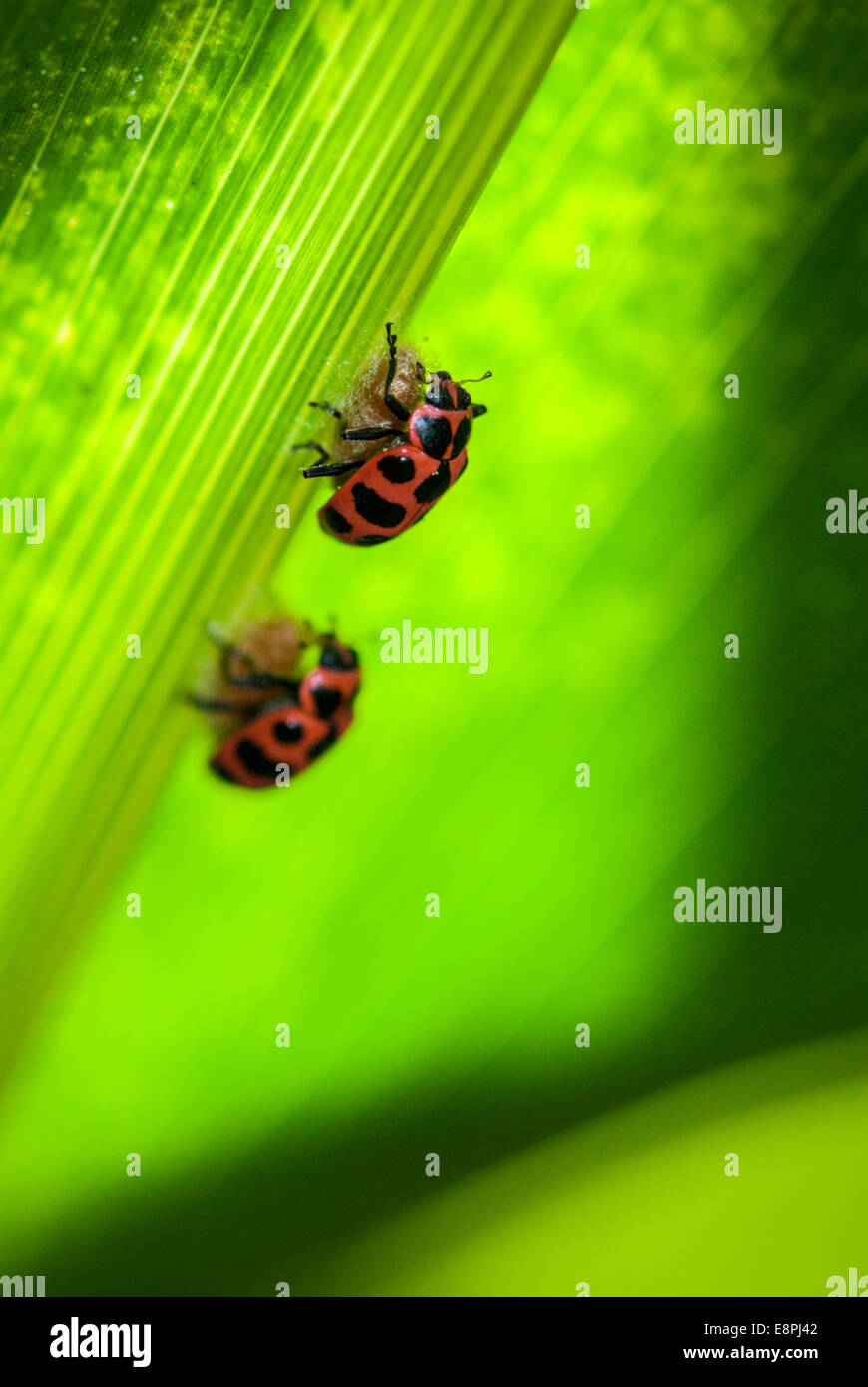 Two ladybirds (Coleomegilla maculata) on top of a parasitoid cocoon (Dinocampus coccinellae) as seen on a leaf in a cornfield. Stock Photohttps://www.alamy.com/image-license-details/?v=1https://www.alamy.com/stock-photo-two-ladybirds-coleomegilla-maculata-on-top-of-a-parasitoid-cocoon-74255890.html
Two ladybirds (Coleomegilla maculata) on top of a parasitoid cocoon (Dinocampus coccinellae) as seen on a leaf in a cornfield. Stock Photohttps://www.alamy.com/image-license-details/?v=1https://www.alamy.com/stock-photo-two-ladybirds-coleomegilla-maculata-on-top-of-a-parasitoid-cocoon-74255890.htmlRME8PJ42–Two ladybirds (Coleomegilla maculata) on top of a parasitoid cocoon (Dinocampus coccinellae) as seen on a leaf in a cornfield.
 . Economic entomology for the farmer and fruit-grower . Fig. 207, Lenta iri/iuea/a. F"ig. 208, a, a, larva ; c, pupa ; d, eggs of Lema tnlineaia. Fig. 209, Diabrotica 12-punctata: a, egg; b, larva; c, injury in corn-stalk; d, pupa; e, beetle. Fig. 210, Diabrotica loiigicornis: a, adult; b, pupa; c, larva; d, same in its case. Fig.-211, Diabrotica vittata. Fig. 212, larva of same. Fig. 213, its pupa. 2l6 Stock Photohttps://www.alamy.com/image-license-details/?v=1https://www.alamy.com/economic-entomology-for-the-farmer-and-fruit-grower-fig-207-lenta-iriiueaa-fquotig-208-a-a-larva-c-pupa-d-eggs-of-lema-tnlineaia-fig-209-diabrotica-12-punctata-a-egg-b-larva-c-injury-in-corn-stalk-d-pupa-e-beetle-fig-210-diabrotica-loiigicornis-a-adult-b-pupa-c-larva-d-same-in-its-case-fig-211-diabrotica-vittata-fig-212-larva-of-same-fig-213-its-pupa-2l6-image178477137.html
. Economic entomology for the farmer and fruit-grower . Fig. 207, Lenta iri/iuea/a. F"ig. 208, a, a, larva ; c, pupa ; d, eggs of Lema tnlineaia. Fig. 209, Diabrotica 12-punctata: a, egg; b, larva; c, injury in corn-stalk; d, pupa; e, beetle. Fig. 210, Diabrotica loiigicornis: a, adult; b, pupa; c, larva; d, same in its case. Fig.-211, Diabrotica vittata. Fig. 212, larva of same. Fig. 213, its pupa. 2l6 Stock Photohttps://www.alamy.com/image-license-details/?v=1https://www.alamy.com/economic-entomology-for-the-farmer-and-fruit-grower-fig-207-lenta-iriiueaa-fquotig-208-a-a-larva-c-pupa-d-eggs-of-lema-tnlineaia-fig-209-diabrotica-12-punctata-a-egg-b-larva-c-injury-in-corn-stalk-d-pupa-e-beetle-fig-210-diabrotica-loiigicornis-a-adult-b-pupa-c-larva-d-same-in-its-case-fig-211-diabrotica-vittata-fig-212-larva-of-same-fig-213-its-pupa-2l6-image178477137.htmlRMMAA9BD–. Economic entomology for the farmer and fruit-grower . Fig. 207, Lenta iri/iuea/a. F"ig. 208, a, a, larva ; c, pupa ; d, eggs of Lema tnlineaia. Fig. 209, Diabrotica 12-punctata: a, egg; b, larva; c, injury in corn-stalk; d, pupa; e, beetle. Fig. 210, Diabrotica loiigicornis: a, adult; b, pupa; c, larva; d, same in its case. Fig.-211, Diabrotica vittata. Fig. 212, larva of same. Fig. 213, its pupa. 2l6
![Elementary entomology ([c1912]) Elementary entomology elementaryentomo00sand Year: [c1912] THE BEETLES 169 The bill-bugs (Calandridae) are from one fourth to one half of an inch long, black, brown, or dark gray, with hard elytra, ridged and FIG. 254. The granary weevil (Calandra granaria]. (Enlarged) rt, beetle ; l>, larva; c, pupa; d, the adult rice weevil (Calandra otyza}. (After Chittenden, United States Department of Agriculture) sculptured. They attack corn, timothy, and other grasses, particu- larly the coarse swamp grasses and sedges. The fat white larvae Stock Photo Elementary entomology ([c1912]) Elementary entomology elementaryentomo00sand Year: [c1912] THE BEETLES 169 The bill-bugs (Calandridae) are from one fourth to one half of an inch long, black, brown, or dark gray, with hard elytra, ridged and FIG. 254. The granary weevil (Calandra granaria]. (Enlarged) rt, beetle ; l>, larva; c, pupa; d, the adult rice weevil (Calandra otyza}. (After Chittenden, United States Department of Agriculture) sculptured. They attack corn, timothy, and other grasses, particu- larly the coarse swamp grasses and sedges. The fat white larvae Stock Photo](https://c8.alamy.com/comp/RWR9XD/elementary-entomology-c1912-elementary-entomology-elementaryentomo00sand-year-c1912-the-beetles-169-the-bill-bugs-calandridae-are-from-one-fourth-to-one-half-of-an-inch-long-black-brown-or-dark-gray-with-hard-elytra-ridged-and-fig-254-the-granary-weevil-calandra-granaria-enlarged-rt-beetle-lgt-larva-c-pupa-d-the-adult-rice-weevil-calandra-otyza-after-chittenden-united-states-department-of-agriculture-sculptured-they-attack-corn-timothy-and-other-grasses-particu-larly-the-coarse-swamp-grasses-and-sedges-the-fat-white-larvae-RWR9XD.jpg) Elementary entomology ([c1912]) Elementary entomology elementaryentomo00sand Year: [c1912] THE BEETLES 169 The bill-bugs (Calandridae) are from one fourth to one half of an inch long, black, brown, or dark gray, with hard elytra, ridged and FIG. 254. The granary weevil (Calandra granaria]. (Enlarged) rt, beetle ; l>, larva; c, pupa; d, the adult rice weevil (Calandra otyza}. (After Chittenden, United States Department of Agriculture) sculptured. They attack corn, timothy, and other grasses, particu- larly the coarse swamp grasses and sedges. The fat white larvae Stock Photohttps://www.alamy.com/image-license-details/?v=1https://www.alamy.com/elementary-entomology-c1912-elementary-entomology-elementaryentomo00sand-year-c1912-the-beetles-169-the-bill-bugs-calandridae-are-from-one-fourth-to-one-half-of-an-inch-long-black-brown-or-dark-gray-with-hard-elytra-ridged-and-fig-254-the-granary-weevil-calandra-granaria-enlarged-rt-beetle-lgt-larva-c-pupa-d-the-adult-rice-weevil-calandra-otyza-after-chittenden-united-states-department-of-agriculture-sculptured-they-attack-corn-timothy-and-other-grasses-particu-larly-the-coarse-swamp-grasses-and-sedges-the-fat-white-larvae-image239613877.html
Elementary entomology ([c1912]) Elementary entomology elementaryentomo00sand Year: [c1912] THE BEETLES 169 The bill-bugs (Calandridae) are from one fourth to one half of an inch long, black, brown, or dark gray, with hard elytra, ridged and FIG. 254. The granary weevil (Calandra granaria]. (Enlarged) rt, beetle ; l>, larva; c, pupa; d, the adult rice weevil (Calandra otyza}. (After Chittenden, United States Department of Agriculture) sculptured. They attack corn, timothy, and other grasses, particu- larly the coarse swamp grasses and sedges. The fat white larvae Stock Photohttps://www.alamy.com/image-license-details/?v=1https://www.alamy.com/elementary-entomology-c1912-elementary-entomology-elementaryentomo00sand-year-c1912-the-beetles-169-the-bill-bugs-calandridae-are-from-one-fourth-to-one-half-of-an-inch-long-black-brown-or-dark-gray-with-hard-elytra-ridged-and-fig-254-the-granary-weevil-calandra-granaria-enlarged-rt-beetle-lgt-larva-c-pupa-d-the-adult-rice-weevil-calandra-otyza-after-chittenden-united-states-department-of-agriculture-sculptured-they-attack-corn-timothy-and-other-grasses-particu-larly-the-coarse-swamp-grasses-and-sedges-the-fat-white-larvae-image239613877.htmlRMRWR9XD–Elementary entomology ([c1912]) Elementary entomology elementaryentomo00sand Year: [c1912] THE BEETLES 169 The bill-bugs (Calandridae) are from one fourth to one half of an inch long, black, brown, or dark gray, with hard elytra, ridged and FIG. 254. The granary weevil (Calandra granaria]. (Enlarged) rt, beetle ; l>, larva; c, pupa; d, the adult rice weevil (Calandra otyza}. (After Chittenden, United States Department of Agriculture) sculptured. They attack corn, timothy, and other grasses, particu- larly the coarse swamp grasses and sedges. The fat white larvae
 Larva and damaged cereal plant by corn ground beetle (Zabrus tenebrioides) - a pest in soil. It is a species of black ground beetle (Carabidae). Stock Photohttps://www.alamy.com/image-license-details/?v=1https://www.alamy.com/larva-and-damaged-cereal-plant-by-corn-ground-beetle-zabrus-tenebrioides-a-pest-in-soil-it-is-a-species-of-black-ground-beetle-carabidae-image451829632.html
Larva and damaged cereal plant by corn ground beetle (Zabrus tenebrioides) - a pest in soil. It is a species of black ground beetle (Carabidae). Stock Photohttps://www.alamy.com/image-license-details/?v=1https://www.alamy.com/larva-and-damaged-cereal-plant-by-corn-ground-beetle-zabrus-tenebrioides-a-pest-in-soil-it-is-a-species-of-black-ground-beetle-carabidae-image451829632.htmlRF2H72H8G–Larva and damaged cereal plant by corn ground beetle (Zabrus tenebrioides) - a pest in soil. It is a species of black ground beetle (Carabidae).
 Insects and insecticidesA practical manual concerning noxious insects and the methods of preventing their injuries . Fig. 115. Twenty-spotted Lady-beetle: a, larva; 6, pupa; e, beetle. represents the three later stages of one of the smallerspecies—the Twenty-spotted Lady-beetle (Psyllobora20-maculata). It is probable, also, that great num-bers of the aphides are destroyed by the harvest-spiders which abound upon corn plants during sum-mer. One of the commonest of these—the StripedHarvest-spider—is shown, natural size, at Plate VI.Remedies.—It seldom becomes necessary to re-sort to artificial r Stock Photohttps://www.alamy.com/image-license-details/?v=1https://www.alamy.com/insects-and-insecticidesa-practical-manual-concerning-noxious-insects-and-the-methods-of-preventing-their-injuries-fig-115-twenty-spotted-lady-beetle-a-larva-6-pupa-e-beetle-represents-the-three-later-stages-of-one-of-the-smallerspeciesthe-twenty-spotted-lady-beetle-psyllobora20-maculata-it-is-probable-also-that-great-num-bers-of-the-aphides-are-destroyed-by-the-harvest-spiders-which-abound-upon-corn-plants-during-sum-mer-one-of-the-commonest-of-thesethe-stripedharvest-spideris-shown-natural-size-at-plate-viremediesit-seldom-becomes-necessary-to-re-sort-to-artificial-r-image342979827.html
Insects and insecticidesA practical manual concerning noxious insects and the methods of preventing their injuries . Fig. 115. Twenty-spotted Lady-beetle: a, larva; 6, pupa; e, beetle. represents the three later stages of one of the smallerspecies—the Twenty-spotted Lady-beetle (Psyllobora20-maculata). It is probable, also, that great num-bers of the aphides are destroyed by the harvest-spiders which abound upon corn plants during sum-mer. One of the commonest of these—the StripedHarvest-spider—is shown, natural size, at Plate VI.Remedies.—It seldom becomes necessary to re-sort to artificial r Stock Photohttps://www.alamy.com/image-license-details/?v=1https://www.alamy.com/insects-and-insecticidesa-practical-manual-concerning-noxious-insects-and-the-methods-of-preventing-their-injuries-fig-115-twenty-spotted-lady-beetle-a-larva-6-pupa-e-beetle-represents-the-three-later-stages-of-one-of-the-smallerspeciesthe-twenty-spotted-lady-beetle-psyllobora20-maculata-it-is-probable-also-that-great-num-bers-of-the-aphides-are-destroyed-by-the-harvest-spiders-which-abound-upon-corn-plants-during-sum-mer-one-of-the-commonest-of-thesethe-stripedharvest-spideris-shown-natural-size-at-plate-viremediesit-seldom-becomes-necessary-to-re-sort-to-artificial-r-image342979827.htmlRM2AX027F–Insects and insecticidesA practical manual concerning noxious insects and the methods of preventing their injuries . Fig. 115. Twenty-spotted Lady-beetle: a, larva; 6, pupa; e, beetle. represents the three later stages of one of the smallerspecies—the Twenty-spotted Lady-beetle (Psyllobora20-maculata). It is probable, also, that great num-bers of the aphides are destroyed by the harvest-spiders which abound upon corn plants during sum-mer. One of the commonest of these—the StripedHarvest-spider—is shown, natural size, at Plate VI.Remedies.—It seldom becomes necessary to re-sort to artificial r
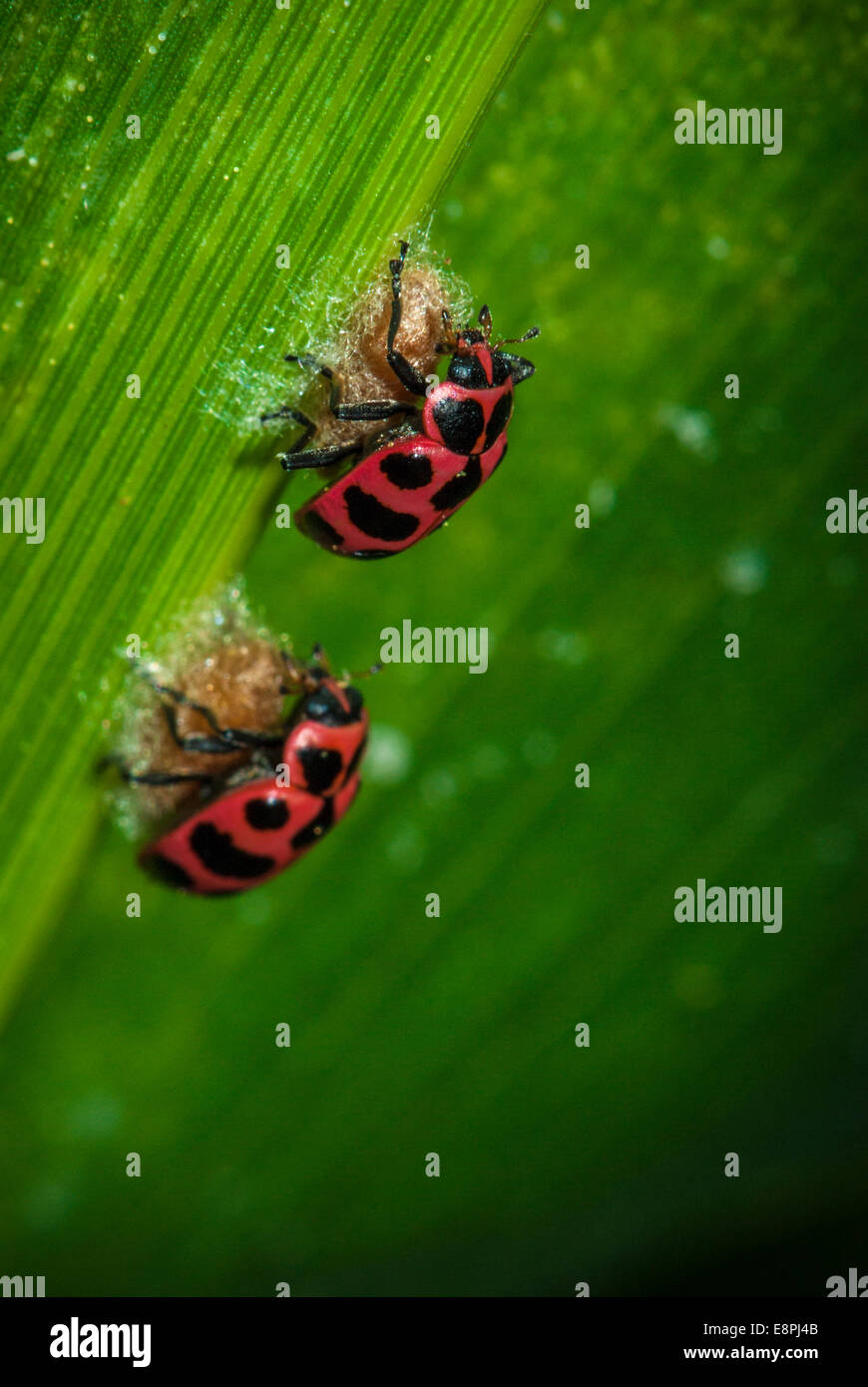 Two ladybirds (Coleomegilla maculata) on top of a parasitoid cocoon (Dinocampus coccinellae) as seen on a leaf in a cornfield. Stock Photohttps://www.alamy.com/image-license-details/?v=1https://www.alamy.com/stock-photo-two-ladybirds-coleomegilla-maculata-on-top-of-a-parasitoid-cocoon-74255899.html
Two ladybirds (Coleomegilla maculata) on top of a parasitoid cocoon (Dinocampus coccinellae) as seen on a leaf in a cornfield. Stock Photohttps://www.alamy.com/image-license-details/?v=1https://www.alamy.com/stock-photo-two-ladybirds-coleomegilla-maculata-on-top-of-a-parasitoid-cocoon-74255899.htmlRME8PJ4B–Two ladybirds (Coleomegilla maculata) on top of a parasitoid cocoon (Dinocampus coccinellae) as seen on a leaf in a cornfield.
 . Economic entomology for the farmer and the fruit grower, and for use as a text-book in agricultural schools and colleges; . Fig. 207, Lema trilinrata. Fig. 208, a, a, larvjt ; c, pupa ; (/, eggs of Lcma Ivilineata. Fig. 209, Diabrotica 13-punctata: a, egg; d, larva; c, injury in corn-stalk; d, pupa; <", beetle. Fig. 210, Diabrotica longicomis: a, adult; b, pupa; c, larva ; d, same in its case. F^. Ill, Diabrotica vittata. Fig. 212, larva of same. Fig. 213, its pupa. 216 Stock Photohttps://www.alamy.com/image-license-details/?v=1https://www.alamy.com/economic-entomology-for-the-farmer-and-the-fruit-grower-and-for-use-as-a-text-book-in-agricultural-schools-and-colleges-fig-207-lema-trilinrata-fig-208-a-a-larvjt-c-pupa-eggs-of-lcma-ivilineata-fig-209-diabrotica-13-punctata-a-egg-d-larva-c-injury-in-corn-stalk-d-pupa-ltquot-beetle-fig-210-diabrotica-longicomis-a-adult-b-pupa-c-larva-d-same-in-its-case-f-ill-diabrotica-vittata-fig-212-larva-of-same-fig-213-its-pupa-216-image178478169.html
. Economic entomology for the farmer and the fruit grower, and for use as a text-book in agricultural schools and colleges; . Fig. 207, Lema trilinrata. Fig. 208, a, a, larvjt ; c, pupa ; (/, eggs of Lcma Ivilineata. Fig. 209, Diabrotica 13-punctata: a, egg; d, larva; c, injury in corn-stalk; d, pupa; <", beetle. Fig. 210, Diabrotica longicomis: a, adult; b, pupa; c, larva ; d, same in its case. F^. Ill, Diabrotica vittata. Fig. 212, larva of same. Fig. 213, its pupa. 216 Stock Photohttps://www.alamy.com/image-license-details/?v=1https://www.alamy.com/economic-entomology-for-the-farmer-and-the-fruit-grower-and-for-use-as-a-text-book-in-agricultural-schools-and-colleges-fig-207-lema-trilinrata-fig-208-a-a-larvjt-c-pupa-eggs-of-lcma-ivilineata-fig-209-diabrotica-13-punctata-a-egg-d-larva-c-injury-in-corn-stalk-d-pupa-ltquot-beetle-fig-210-diabrotica-longicomis-a-adult-b-pupa-c-larva-d-same-in-its-case-f-ill-diabrotica-vittata-fig-212-larva-of-same-fig-213-its-pupa-216-image178478169.htmlRMMAAAM9–. Economic entomology for the farmer and the fruit grower, and for use as a text-book in agricultural schools and colleges; . Fig. 207, Lema trilinrata. Fig. 208, a, a, larvjt ; c, pupa ; (/, eggs of Lcma Ivilineata. Fig. 209, Diabrotica 13-punctata: a, egg; d, larva; c, injury in corn-stalk; d, pupa; <", beetle. Fig. 210, Diabrotica longicomis: a, adult; b, pupa; c, larva ; d, same in its case. F^. Ill, Diabrotica vittata. Fig. 212, larva of same. Fig. 213, its pupa. 216
![Elementary entomology ([c1912]) Elementary entomology elementaryentomo00sand Year: [c1912] striped cucumber-beetle (Diabrotica vittatd] is about the same size, bright yellow with black stripes, and is one of the worst pests of young cucumber and melon vines. The larvae are long, slender whitish grubs which feed on the roots. The twelve-spotted Diabrotica is green with twelve black spots, with similar food habits in the adult stage, but in the )tnpec $outn tjie iarvae do serious injury to the roots of cucumber-beetle J J corn, while the larva of another pale green species, known as the west- e Stock Photo Elementary entomology ([c1912]) Elementary entomology elementaryentomo00sand Year: [c1912] striped cucumber-beetle (Diabrotica vittatd] is about the same size, bright yellow with black stripes, and is one of the worst pests of young cucumber and melon vines. The larvae are long, slender whitish grubs which feed on the roots. The twelve-spotted Diabrotica is green with twelve black spots, with similar food habits in the adult stage, but in the )tnpec $outn tjie iarvae do serious injury to the roots of cucumber-beetle J J corn, while the larva of another pale green species, known as the west- e Stock Photo](https://c8.alamy.com/comp/RWPPWW/elementary-entomology-c1912-elementary-entomology-elementaryentomo00sand-year-c1912-striped-cucumber-beetle-diabrotica-vittatd-is-about-the-same-size-bright-yellow-with-black-stripes-and-is-one-of-the-worst-pests-of-young-cucumber-and-melon-vines-the-larvae-are-long-slender-whitish-grubs-which-feed-on-the-roots-the-twelve-spotted-diabrotica-is-green-with-twelve-black-spots-with-similar-food-habits-in-the-adult-stage-but-in-the-tnpec-outn-tjie-iarvae-do-serious-injury-to-the-roots-of-cucumber-beetle-j-j-corn-while-the-larva-of-another-pale-green-species-known-as-the-west-e-RWPPWW.jpg) Elementary entomology ([c1912]) Elementary entomology elementaryentomo00sand Year: [c1912] striped cucumber-beetle (Diabrotica vittatd] is about the same size, bright yellow with black stripes, and is one of the worst pests of young cucumber and melon vines. The larvae are long, slender whitish grubs which feed on the roots. The twelve-spotted Diabrotica is green with twelve black spots, with similar food habits in the adult stage, but in the )tnpec $outn tjie iarvae do serious injury to the roots of cucumber-beetle J J corn, while the larva of another pale green species, known as the west- e Stock Photohttps://www.alamy.com/image-license-details/?v=1https://www.alamy.com/elementary-entomology-c1912-elementary-entomology-elementaryentomo00sand-year-c1912-striped-cucumber-beetle-diabrotica-vittatd-is-about-the-same-size-bright-yellow-with-black-stripes-and-is-one-of-the-worst-pests-of-young-cucumber-and-melon-vines-the-larvae-are-long-slender-whitish-grubs-which-feed-on-the-roots-the-twelve-spotted-diabrotica-is-green-with-twelve-black-spots-with-similar-food-habits-in-the-adult-stage-but-in-the-tnpec-outn-tjie-iarvae-do-serious-injury-to-the-roots-of-cucumber-beetle-j-j-corn-while-the-larva-of-another-pale-green-species-known-as-the-west-e-image239602101.html
Elementary entomology ([c1912]) Elementary entomology elementaryentomo00sand Year: [c1912] striped cucumber-beetle (Diabrotica vittatd] is about the same size, bright yellow with black stripes, and is one of the worst pests of young cucumber and melon vines. The larvae are long, slender whitish grubs which feed on the roots. The twelve-spotted Diabrotica is green with twelve black spots, with similar food habits in the adult stage, but in the )tnpec $outn tjie iarvae do serious injury to the roots of cucumber-beetle J J corn, while the larva of another pale green species, known as the west- e Stock Photohttps://www.alamy.com/image-license-details/?v=1https://www.alamy.com/elementary-entomology-c1912-elementary-entomology-elementaryentomo00sand-year-c1912-striped-cucumber-beetle-diabrotica-vittatd-is-about-the-same-size-bright-yellow-with-black-stripes-and-is-one-of-the-worst-pests-of-young-cucumber-and-melon-vines-the-larvae-are-long-slender-whitish-grubs-which-feed-on-the-roots-the-twelve-spotted-diabrotica-is-green-with-twelve-black-spots-with-similar-food-habits-in-the-adult-stage-but-in-the-tnpec-outn-tjie-iarvae-do-serious-injury-to-the-roots-of-cucumber-beetle-j-j-corn-while-the-larva-of-another-pale-green-species-known-as-the-west-e-image239602101.htmlRMRWPPWW–Elementary entomology ([c1912]) Elementary entomology elementaryentomo00sand Year: [c1912] striped cucumber-beetle (Diabrotica vittatd] is about the same size, bright yellow with black stripes, and is one of the worst pests of young cucumber and melon vines. The larvae are long, slender whitish grubs which feed on the roots. The twelve-spotted Diabrotica is green with twelve black spots, with similar food habits in the adult stage, but in the )tnpec $outn tjie iarvae do serious injury to the roots of cucumber-beetle J J corn, while the larva of another pale green species, known as the west- e
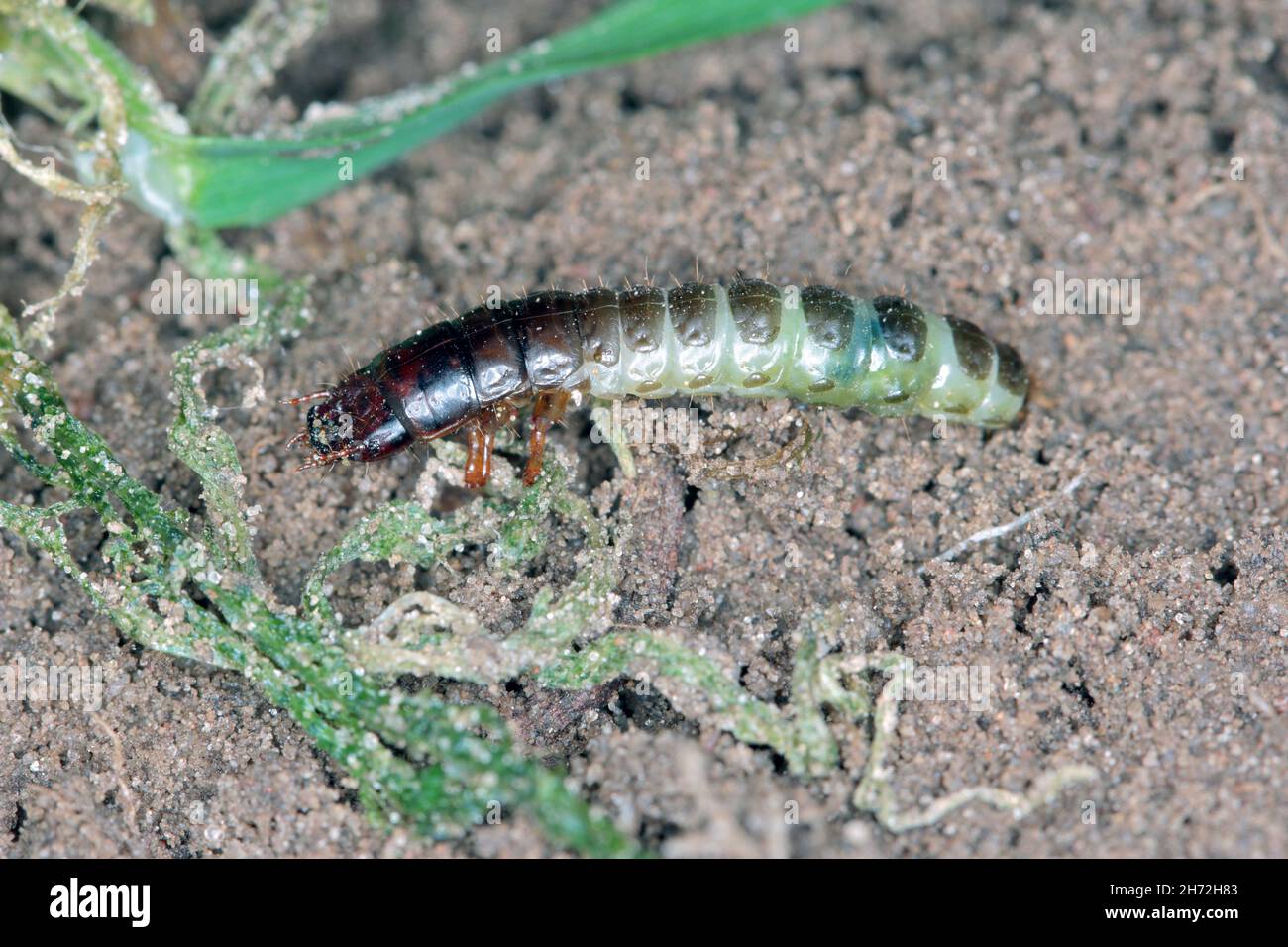 Larva and damaged cereal plant by corn ground beetle (Zabrus tenebrioides) - a pest in soil. It is a species of black ground beetle (Carabidae). Stock Photohttps://www.alamy.com/image-license-details/?v=1https://www.alamy.com/larva-and-damaged-cereal-plant-by-corn-ground-beetle-zabrus-tenebrioides-a-pest-in-soil-it-is-a-species-of-black-ground-beetle-carabidae-image451829619.html
Larva and damaged cereal plant by corn ground beetle (Zabrus tenebrioides) - a pest in soil. It is a species of black ground beetle (Carabidae). Stock Photohttps://www.alamy.com/image-license-details/?v=1https://www.alamy.com/larva-and-damaged-cereal-plant-by-corn-ground-beetle-zabrus-tenebrioides-a-pest-in-soil-it-is-a-species-of-black-ground-beetle-carabidae-image451829619.htmlRF2H72H83–Larva and damaged cereal plant by corn ground beetle (Zabrus tenebrioides) - a pest in soil. It is a species of black ground beetle (Carabidae).
![A preliminary introduction to the study of entomologyTogether with a chapter on remedies, or methods that can be used in fighting injurious insects; insect enemies of the apple tree and its fruit, and the insect enemies of small grains . Fig. 51.-—Melan-osis comviunis.Nat. size andenlarged. Fig. 58.—The commonSnapping-beetle [Melan-otus communis): a, larva;b, beetle. [Original.] Melanotus communis Gyll. The insect which is figured herewith (Figs. 57 and a, the larva, b, the beetle) is even more common than either of the pre-ceding; but instead of working so much in corn fields is moreof a gras Stock Photo A preliminary introduction to the study of entomologyTogether with a chapter on remedies, or methods that can be used in fighting injurious insects; insect enemies of the apple tree and its fruit, and the insect enemies of small grains . Fig. 51.-—Melan-osis comviunis.Nat. size andenlarged. Fig. 58.—The commonSnapping-beetle [Melan-otus communis): a, larva;b, beetle. [Original.] Melanotus communis Gyll. The insect which is figured herewith (Figs. 57 and a, the larva, b, the beetle) is even more common than either of the pre-ceding; but instead of working so much in corn fields is moreof a gras Stock Photo](https://c8.alamy.com/comp/2AN5D0A/a-preliminary-introduction-to-the-study-of-entomologytogether-with-a-chapter-on-remedies-or-methods-that-can-be-used-in-fighting-injurious-insects-insect-enemies-of-the-apple-tree-and-its-fruit-and-the-insect-enemies-of-small-grains-fig-51-melan-osis-comviunisnat-size-andenlarged-fig-58the-commonsnapping-beetle-melan-otus-communis-a-larvab-beetle-original-melanotus-communis-gyll-the-insect-which-is-figured-herewith-figs-57-and-a-the-larva-b-the-beetle-is-even-more-common-than-either-of-the-pre-ceding-but-instead-of-working-so-much-in-corn-fields-is-moreof-a-gras-2AN5D0A.jpg) A preliminary introduction to the study of entomologyTogether with a chapter on remedies, or methods that can be used in fighting injurious insects; insect enemies of the apple tree and its fruit, and the insect enemies of small grains . Fig. 51.-—Melan-osis comviunis.Nat. size andenlarged. Fig. 58.—The commonSnapping-beetle [Melan-otus communis): a, larva;b, beetle. [Original.] Melanotus communis Gyll. The insect which is figured herewith (Figs. 57 and a, the larva, b, the beetle) is even more common than either of the pre-ceding; but instead of working so much in corn fields is moreof a gras Stock Photohttps://www.alamy.com/image-license-details/?v=1https://www.alamy.com/a-preliminary-introduction-to-the-study-of-entomologytogether-with-a-chapter-on-remedies-or-methods-that-can-be-used-in-fighting-injurious-insects-insect-enemies-of-the-apple-tree-and-its-fruit-and-the-insect-enemies-of-small-grains-fig-51-melan-osis-comviunisnat-size-andenlarged-fig-58the-commonsnapping-beetle-melan-otus-communis-a-larvab-beetle-original-melanotus-communis-gyll-the-insect-which-is-figured-herewith-figs-57-and-a-the-larva-b-the-beetle-is-even-more-common-than-either-of-the-pre-ceding-but-instead-of-working-so-much-in-corn-fields-is-moreof-a-gras-image340024730.html
A preliminary introduction to the study of entomologyTogether with a chapter on remedies, or methods that can be used in fighting injurious insects; insect enemies of the apple tree and its fruit, and the insect enemies of small grains . Fig. 51.-—Melan-osis comviunis.Nat. size andenlarged. Fig. 58.—The commonSnapping-beetle [Melan-otus communis): a, larva;b, beetle. [Original.] Melanotus communis Gyll. The insect which is figured herewith (Figs. 57 and a, the larva, b, the beetle) is even more common than either of the pre-ceding; but instead of working so much in corn fields is moreof a gras Stock Photohttps://www.alamy.com/image-license-details/?v=1https://www.alamy.com/a-preliminary-introduction-to-the-study-of-entomologytogether-with-a-chapter-on-remedies-or-methods-that-can-be-used-in-fighting-injurious-insects-insect-enemies-of-the-apple-tree-and-its-fruit-and-the-insect-enemies-of-small-grains-fig-51-melan-osis-comviunisnat-size-andenlarged-fig-58the-commonsnapping-beetle-melan-otus-communis-a-larvab-beetle-original-melanotus-communis-gyll-the-insect-which-is-figured-herewith-figs-57-and-a-the-larva-b-the-beetle-is-even-more-common-than-either-of-the-pre-ceding-but-instead-of-working-so-much-in-corn-fields-is-moreof-a-gras-image340024730.htmlRM2AN5D0A–A preliminary introduction to the study of entomologyTogether with a chapter on remedies, or methods that can be used in fighting injurious insects; insect enemies of the apple tree and its fruit, and the insect enemies of small grains . Fig. 51.-—Melan-osis comviunis.Nat. size andenlarged. Fig. 58.—The commonSnapping-beetle [Melan-otus communis): a, larva;b, beetle. [Original.] Melanotus communis Gyll. The insect which is figured herewith (Figs. 57 and a, the larva, b, the beetle) is even more common than either of the pre-ceding; but instead of working so much in corn fields is moreof a gras
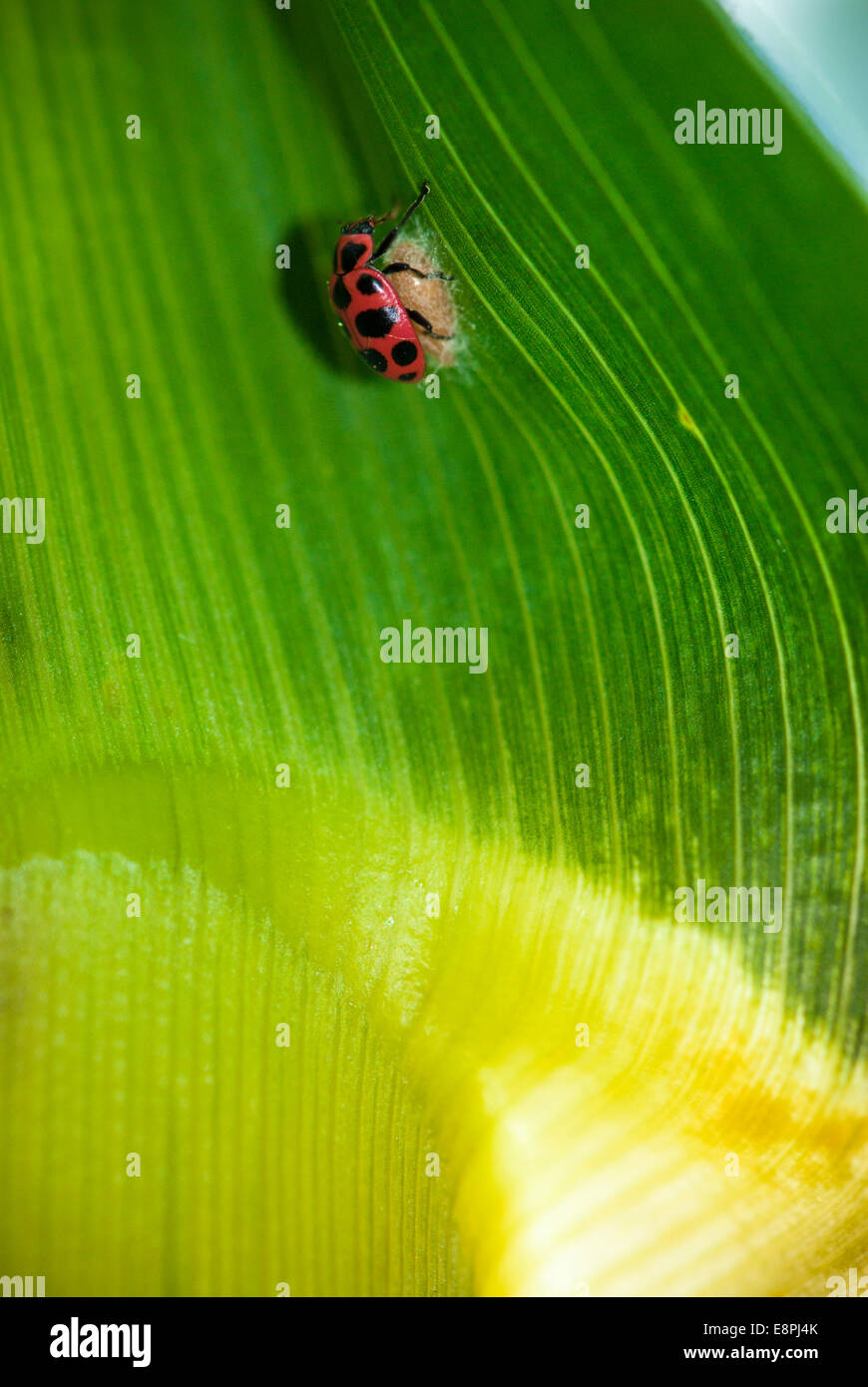 A ladybird (Coleomegilla maculata) on top of a parasitoid cocoon (Dinocampus coccinellae) as seen on a leaf in a cornfield. Stock Photohttps://www.alamy.com/image-license-details/?v=1https://www.alamy.com/stock-photo-a-ladybird-coleomegilla-maculata-on-top-of-a-parasitoid-cocoon-dinocampus-74255907.html
A ladybird (Coleomegilla maculata) on top of a parasitoid cocoon (Dinocampus coccinellae) as seen on a leaf in a cornfield. Stock Photohttps://www.alamy.com/image-license-details/?v=1https://www.alamy.com/stock-photo-a-ladybird-coleomegilla-maculata-on-top-of-a-parasitoid-cocoon-dinocampus-74255907.htmlRME8PJ4K–A ladybird (Coleomegilla maculata) on top of a parasitoid cocoon (Dinocampus coccinellae) as seen on a leaf in a cornfield.
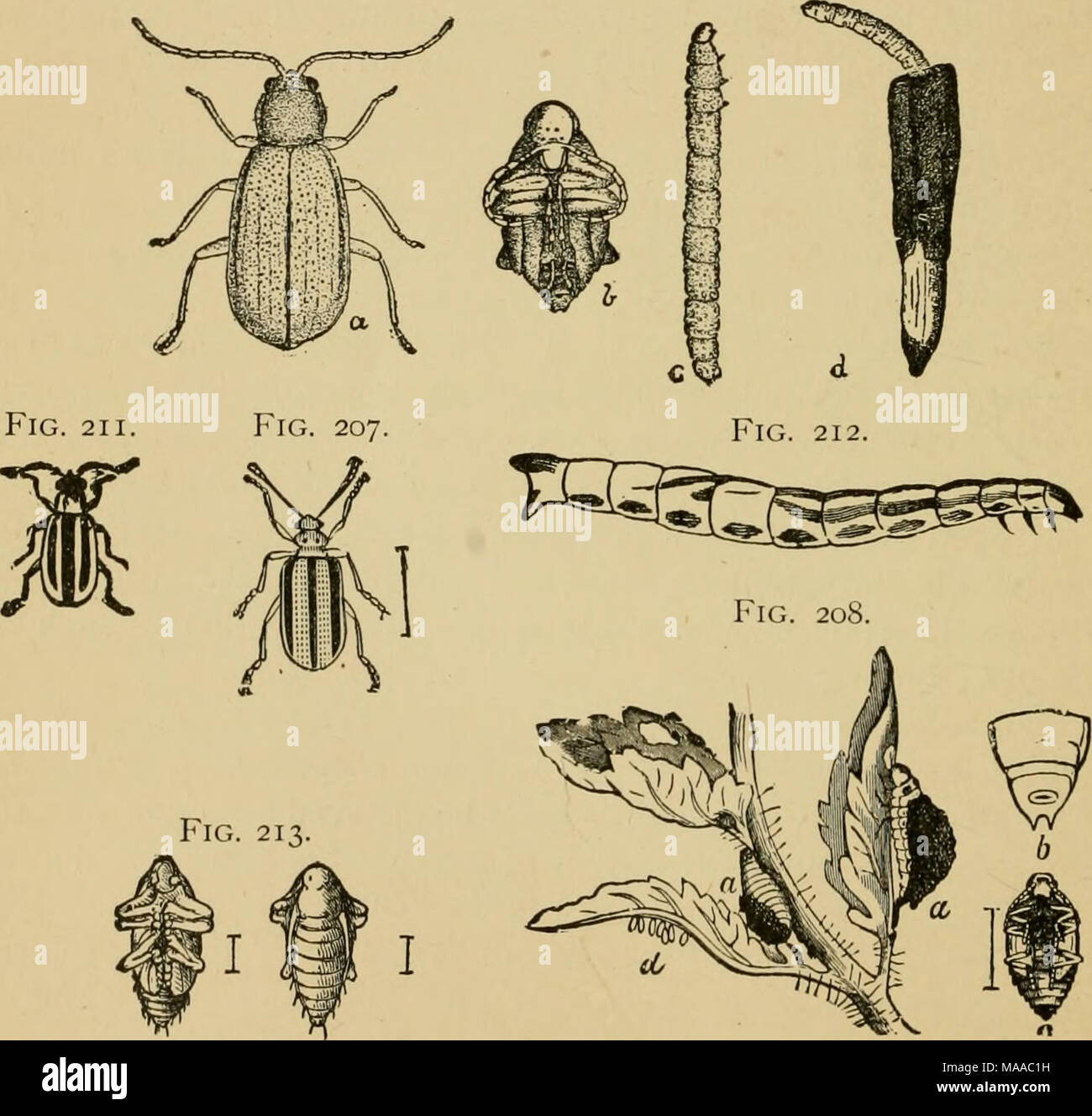 . Economic entomology for the farmer and the fruit grower, and for use as a text-book in agricultural schools and colleges; . Fig. 207, Lenia Irilineata. Fig. 208, a, a, larva; ; c, pupa ; d, eggs of Lema IriUneata. Fig. 209, Diabroiica 12-punctata: a, egg; b, larva; c, injury in corn-stalk; d, pupa; e, beetle. Fig. 210, Diabrotica longicornis: a, adult; b, pupa ; c, larva ; d, same in its case. ¥g.-211, Diabroiica vitlata. Fig. 212, larva of same. Fig. 213, its pupa. 216 Stock Photohttps://www.alamy.com/image-license-details/?v=1https://www.alamy.com/economic-entomology-for-the-farmer-and-the-fruit-grower-and-for-use-as-a-text-book-in-agricultural-schools-and-colleges-fig-207-lenia-irilineata-fig-208-a-a-larva-c-pupa-d-eggs-of-lema-iriuneata-fig-209-diabroiica-12-punctata-a-egg-b-larva-c-injury-in-corn-stalk-d-pupa-e-beetle-fig-210-diabrotica-longicornis-a-adult-b-pupa-c-larva-d-same-in-its-case-g-211-diabroiica-vitlata-fig-212-larva-of-same-fig-213-its-pupa-216-image178479213.html
. Economic entomology for the farmer and the fruit grower, and for use as a text-book in agricultural schools and colleges; . Fig. 207, Lenia Irilineata. Fig. 208, a, a, larva; ; c, pupa ; d, eggs of Lema IriUneata. Fig. 209, Diabroiica 12-punctata: a, egg; b, larva; c, injury in corn-stalk; d, pupa; e, beetle. Fig. 210, Diabrotica longicornis: a, adult; b, pupa ; c, larva ; d, same in its case. ¥g.-211, Diabroiica vitlata. Fig. 212, larva of same. Fig. 213, its pupa. 216 Stock Photohttps://www.alamy.com/image-license-details/?v=1https://www.alamy.com/economic-entomology-for-the-farmer-and-the-fruit-grower-and-for-use-as-a-text-book-in-agricultural-schools-and-colleges-fig-207-lenia-irilineata-fig-208-a-a-larva-c-pupa-d-eggs-of-lema-iriuneata-fig-209-diabroiica-12-punctata-a-egg-b-larva-c-injury-in-corn-stalk-d-pupa-e-beetle-fig-210-diabrotica-longicornis-a-adult-b-pupa-c-larva-d-same-in-its-case-g-211-diabroiica-vitlata-fig-212-larva-of-same-fig-213-its-pupa-216-image178479213.htmlRMMAAC1H–. Economic entomology for the farmer and the fruit grower, and for use as a text-book in agricultural schools and colleges; . Fig. 207, Lenia Irilineata. Fig. 208, a, a, larva; ; c, pupa ; d, eggs of Lema IriUneata. Fig. 209, Diabroiica 12-punctata: a, egg; b, larva; c, injury in corn-stalk; d, pupa; e, beetle. Fig. 210, Diabrotica longicornis: a, adult; b, pupa ; c, larva ; d, same in its case. ¥g.-211, Diabroiica vitlata. Fig. 212, larva of same. Fig. 213, its pupa. 216
 Economic entomology for the farmer and the fruit grower, and for use as a text-book in agricultural schools and colleges; . economicentomolo00smit Year: 1906 Fig. 210. Fig. 207, Lema trilinrata. Fig. 208, a, a, larvjt ; c, pupa ; (/, eggs of Lcma Ivilineata. Fig. 209, Diabrotica 13-punctata: a, egg; d, larva; c, injury in corn-stalk; d, pupa; <', beetle. Fig. 210, Diabrotica longicomis: a, adult; b, pupa; c, larva ; d, same in its case. F^. Ill, Diabrotica vittata. Fig. 212, larva of same. Fig. 213, its pupa. 216 Stock Photohttps://www.alamy.com/image-license-details/?v=1https://www.alamy.com/economic-entomology-for-the-farmer-and-the-fruit-grower-and-for-use-as-a-text-book-in-agricultural-schools-and-colleges-economicentomolo00smit-year-1906-fig-210-fig-207-lema-trilinrata-fig-208-a-a-larvjt-c-pupa-eggs-of-lcma-ivilineata-fig-209-diabrotica-13-punctata-a-egg-d-larva-c-injury-in-corn-stalk-d-pupa-lt-beetle-fig-210-diabrotica-longicomis-a-adult-b-pupa-c-larva-d-same-in-its-case-f-ill-diabrotica-vittata-fig-212-larva-of-same-fig-213-its-pupa-216-image241024658.html
Economic entomology for the farmer and the fruit grower, and for use as a text-book in agricultural schools and colleges; . economicentomolo00smit Year: 1906 Fig. 210. Fig. 207, Lema trilinrata. Fig. 208, a, a, larvjt ; c, pupa ; (/, eggs of Lcma Ivilineata. Fig. 209, Diabrotica 13-punctata: a, egg; d, larva; c, injury in corn-stalk; d, pupa; <', beetle. Fig. 210, Diabrotica longicomis: a, adult; b, pupa; c, larva ; d, same in its case. F^. Ill, Diabrotica vittata. Fig. 212, larva of same. Fig. 213, its pupa. 216 Stock Photohttps://www.alamy.com/image-license-details/?v=1https://www.alamy.com/economic-entomology-for-the-farmer-and-the-fruit-grower-and-for-use-as-a-text-book-in-agricultural-schools-and-colleges-economicentomolo00smit-year-1906-fig-210-fig-207-lema-trilinrata-fig-208-a-a-larvjt-c-pupa-eggs-of-lcma-ivilineata-fig-209-diabrotica-13-punctata-a-egg-d-larva-c-injury-in-corn-stalk-d-pupa-lt-beetle-fig-210-diabrotica-longicomis-a-adult-b-pupa-c-larva-d-same-in-its-case-f-ill-diabrotica-vittata-fig-212-larva-of-same-fig-213-its-pupa-216-image241024658.htmlRMT03HBE–Economic entomology for the farmer and the fruit grower, and for use as a text-book in agricultural schools and colleges; . economicentomolo00smit Year: 1906 Fig. 210. Fig. 207, Lema trilinrata. Fig. 208, a, a, larvjt ; c, pupa ; (/, eggs of Lcma Ivilineata. Fig. 209, Diabrotica 13-punctata: a, egg; d, larva; c, injury in corn-stalk; d, pupa; <', beetle. Fig. 210, Diabrotica longicomis: a, adult; b, pupa; c, larva ; d, same in its case. F^. Ill, Diabrotica vittata. Fig. 212, larva of same. Fig. 213, its pupa. 216
 Larva and damaged cereal plant by corn ground beetle (Zabrus tenebrioides) is a species of black ground beetle (Carabidae). A pest in soil Stock Photohttps://www.alamy.com/image-license-details/?v=1https://www.alamy.com/larva-and-damaged-cereal-plant-by-corn-ground-beetle-zabrus-tenebrioides-is-a-species-of-black-ground-beetle-carabidae-a-pest-in-soil-image451829514.html
Larva and damaged cereal plant by corn ground beetle (Zabrus tenebrioides) is a species of black ground beetle (Carabidae). A pest in soil Stock Photohttps://www.alamy.com/image-license-details/?v=1https://www.alamy.com/larva-and-damaged-cereal-plant-by-corn-ground-beetle-zabrus-tenebrioides-is-a-species-of-black-ground-beetle-carabidae-a-pest-in-soil-image451829514.htmlRF2H72H4A–Larva and damaged cereal plant by corn ground beetle (Zabrus tenebrioides) is a species of black ground beetle (Carabidae). A pest in soil
 . Some common insects and insects of Nebraska corn fields and potato patches... Eqg of NorthernCorn-Root Wor/n. Northerii Corn Root Worm, Adult Beetle The northern corn-root worm is about as large around as a commonneedle and varies in length from one-half to three-fifths of an inch. It iswhite thruout with the exception of its head, a spot on the last segment,end the top of the first segment, which are of a light brown color. The beetle lays the eggs that produce the larvae in the cornfield aboutone inch beneath the suiface of the ground, where they remain thruottthe winter. In June the larva Stock Photohttps://www.alamy.com/image-license-details/?v=1https://www.alamy.com/some-common-insects-and-insects-of-nebraska-corn-fields-and-potato-patches-eqg-of-northerncorn-root-worn-northerii-corn-root-worm-adult-beetle-the-northern-corn-root-worm-is-about-as-large-around-as-a-commonneedle-and-varies-in-length-from-one-half-to-three-fifths-of-an-inch-it-iswhite-thruout-with-the-exception-of-its-head-a-spot-on-the-last-segmentend-the-top-of-the-first-segment-which-are-of-a-light-brown-color-the-beetle-lays-the-eggs-that-produce-the-larvae-in-the-cornfield-aboutone-inch-beneath-the-suiface-of-the-ground-where-they-remain-thruottthe-winter-in-june-the-larva-image336908729.html
. Some common insects and insects of Nebraska corn fields and potato patches... Eqg of NorthernCorn-Root Wor/n. Northerii Corn Root Worm, Adult Beetle The northern corn-root worm is about as large around as a commonneedle and varies in length from one-half to three-fifths of an inch. It iswhite thruout with the exception of its head, a spot on the last segment,end the top of the first segment, which are of a light brown color. The beetle lays the eggs that produce the larvae in the cornfield aboutone inch beneath the suiface of the ground, where they remain thruottthe winter. In June the larva Stock Photohttps://www.alamy.com/image-license-details/?v=1https://www.alamy.com/some-common-insects-and-insects-of-nebraska-corn-fields-and-potato-patches-eqg-of-northerncorn-root-worn-northerii-corn-root-worm-adult-beetle-the-northern-corn-root-worm-is-about-as-large-around-as-a-commonneedle-and-varies-in-length-from-one-half-to-three-fifths-of-an-inch-it-iswhite-thruout-with-the-exception-of-its-head-a-spot-on-the-last-segmentend-the-top-of-the-first-segment-which-are-of-a-light-brown-color-the-beetle-lays-the-eggs-that-produce-the-larvae-in-the-cornfield-aboutone-inch-beneath-the-suiface-of-the-ground-where-they-remain-thruottthe-winter-in-june-the-larva-image336908729.htmlRM2AG3EEH–. Some common insects and insects of Nebraska corn fields and potato patches... Eqg of NorthernCorn-Root Wor/n. Northerii Corn Root Worm, Adult Beetle The northern corn-root worm is about as large around as a commonneedle and varies in length from one-half to three-fifths of an inch. It iswhite thruout with the exception of its head, a spot on the last segment,end the top of the first segment, which are of a light brown color. The beetle lays the eggs that produce the larvae in the cornfield aboutone inch beneath the suiface of the ground, where they remain thruottthe winter. In June the larva
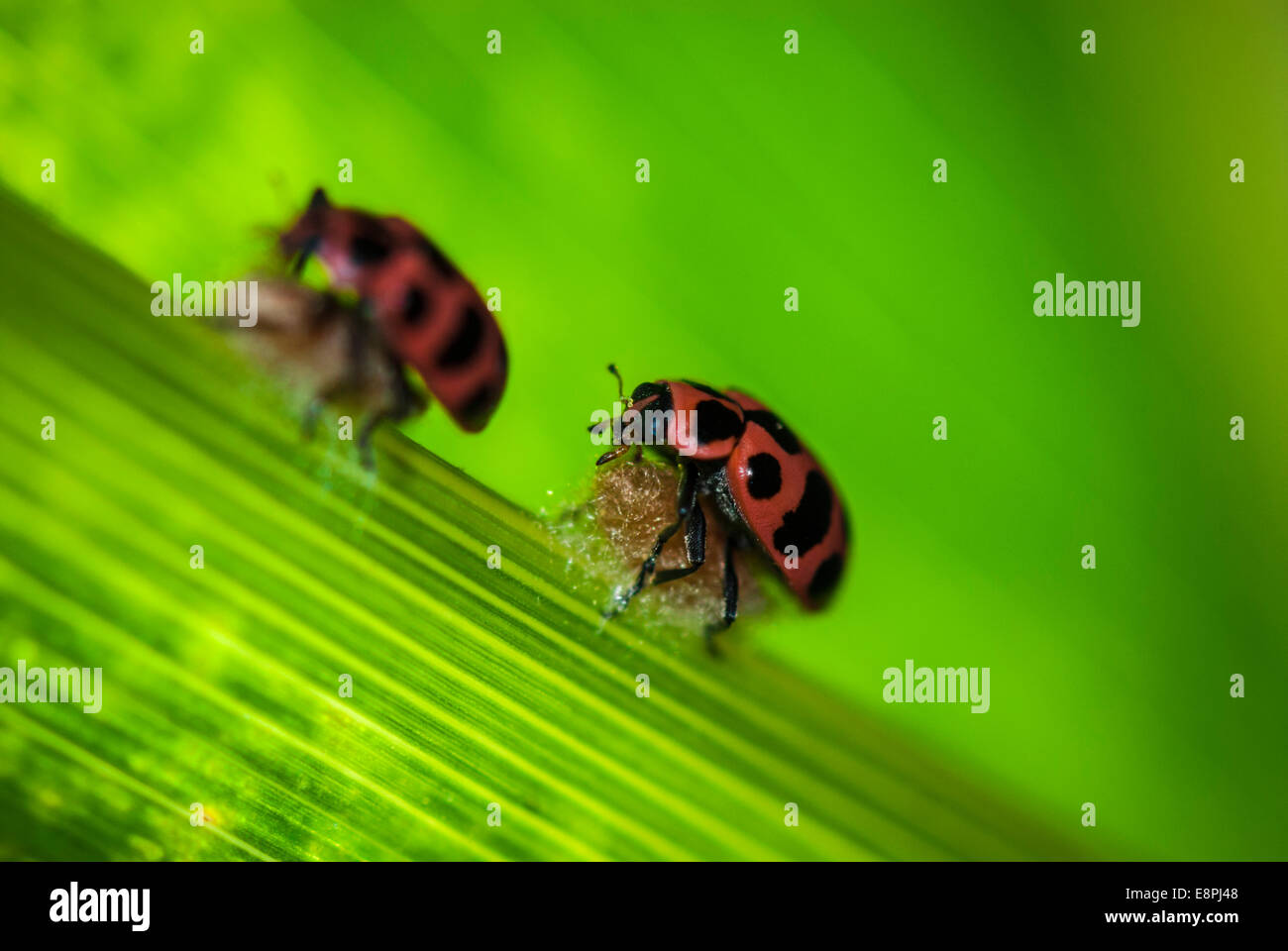 Two ladybirds (Coleomegilla maculata) on top of a parasitoid cocoon (Dinocampus coccinellae) as seen on a leaf in a cornfield. Stock Photohttps://www.alamy.com/image-license-details/?v=1https://www.alamy.com/stock-photo-two-ladybirds-coleomegilla-maculata-on-top-of-a-parasitoid-cocoon-74255896.html
Two ladybirds (Coleomegilla maculata) on top of a parasitoid cocoon (Dinocampus coccinellae) as seen on a leaf in a cornfield. Stock Photohttps://www.alamy.com/image-license-details/?v=1https://www.alamy.com/stock-photo-two-ladybirds-coleomegilla-maculata-on-top-of-a-parasitoid-cocoon-74255896.htmlRME8PJ48–Two ladybirds (Coleomegilla maculata) on top of a parasitoid cocoon (Dinocampus coccinellae) as seen on a leaf in a cornfield.
![. Economic entomology for the farmer and fruit-grower [microform] : and for use as a text-book in agricultural schools and colleges . Fig. 207, Le7na trilineata. Fig. 208, a, a, larvae ; c, pupa; d, eggs of Lema trilineata. Fig. 209, Diabrotica i2-pU7ictata: a, egg; b, larva; c, injury in corn-stalk; d, pupa; e, beetle. Fig. 210, Diabrotica longicornis: a, adult; b, pupa; c, larva ; rf, same in its case. Fig. 211, Diabrotica vittata. Fig. 212, larva of same. Fig. 213, its pupa. 216 Stock Photo . Economic entomology for the farmer and fruit-grower [microform] : and for use as a text-book in agricultural schools and colleges . Fig. 207, Le7na trilineata. Fig. 208, a, a, larvae ; c, pupa; d, eggs of Lema trilineata. Fig. 209, Diabrotica i2-pU7ictata: a, egg; b, larva; c, injury in corn-stalk; d, pupa; e, beetle. Fig. 210, Diabrotica longicornis: a, adult; b, pupa; c, larva ; rf, same in its case. Fig. 211, Diabrotica vittata. Fig. 212, larva of same. Fig. 213, its pupa. 216 Stock Photo](https://c8.alamy.com/comp/MAABBG/economic-entomology-for-the-farmer-and-fruit-grower-microform-and-for-use-as-a-text-book-in-agricultural-schools-and-colleges-fig-207-le7na-trilineata-fig-208-a-a-larvae-c-pupa-d-eggs-of-lema-trilineata-fig-209-diabrotica-i2-pu7ictata-a-egg-b-larva-c-injury-in-corn-stalk-d-pupa-e-beetle-fig-210-diabrotica-longicornis-a-adult-b-pupa-c-larva-rf-same-in-its-case-fig-211-diabrotica-vittata-fig-212-larva-of-same-fig-213-its-pupa-216-MAABBG.jpg) . Economic entomology for the farmer and fruit-grower [microform] : and for use as a text-book in agricultural schools and colleges . Fig. 207, Le7na trilineata. Fig. 208, a, a, larvae ; c, pupa; d, eggs of Lema trilineata. Fig. 209, Diabrotica i2-pU7ictata: a, egg; b, larva; c, injury in corn-stalk; d, pupa; e, beetle. Fig. 210, Diabrotica longicornis: a, adult; b, pupa; c, larva ; rf, same in its case. Fig. 211, Diabrotica vittata. Fig. 212, larva of same. Fig. 213, its pupa. 216 Stock Photohttps://www.alamy.com/image-license-details/?v=1https://www.alamy.com/economic-entomology-for-the-farmer-and-fruit-grower-microform-and-for-use-as-a-text-book-in-agricultural-schools-and-colleges-fig-207-le7na-trilineata-fig-208-a-a-larvae-c-pupa-d-eggs-of-lema-trilineata-fig-209-diabrotica-i2-pu7ictata-a-egg-b-larva-c-injury-in-corn-stalk-d-pupa-e-beetle-fig-210-diabrotica-longicornis-a-adult-b-pupa-c-larva-rf-same-in-its-case-fig-211-diabrotica-vittata-fig-212-larva-of-same-fig-213-its-pupa-216-image178478708.html
. Economic entomology for the farmer and fruit-grower [microform] : and for use as a text-book in agricultural schools and colleges . Fig. 207, Le7na trilineata. Fig. 208, a, a, larvae ; c, pupa; d, eggs of Lema trilineata. Fig. 209, Diabrotica i2-pU7ictata: a, egg; b, larva; c, injury in corn-stalk; d, pupa; e, beetle. Fig. 210, Diabrotica longicornis: a, adult; b, pupa; c, larva ; rf, same in its case. Fig. 211, Diabrotica vittata. Fig. 212, larva of same. Fig. 213, its pupa. 216 Stock Photohttps://www.alamy.com/image-license-details/?v=1https://www.alamy.com/economic-entomology-for-the-farmer-and-fruit-grower-microform-and-for-use-as-a-text-book-in-agricultural-schools-and-colleges-fig-207-le7na-trilineata-fig-208-a-a-larvae-c-pupa-d-eggs-of-lema-trilineata-fig-209-diabrotica-i2-pu7ictata-a-egg-b-larva-c-injury-in-corn-stalk-d-pupa-e-beetle-fig-210-diabrotica-longicornis-a-adult-b-pupa-c-larva-rf-same-in-its-case-fig-211-diabrotica-vittata-fig-212-larva-of-same-fig-213-its-pupa-216-image178478708.htmlRMMAABBG–. Economic entomology for the farmer and fruit-grower [microform] : and for use as a text-book in agricultural schools and colleges . Fig. 207, Le7na trilineata. Fig. 208, a, a, larvae ; c, pupa; d, eggs of Lema trilineata. Fig. 209, Diabrotica i2-pU7ictata: a, egg; b, larva; c, injury in corn-stalk; d, pupa; e, beetle. Fig. 210, Diabrotica longicornis: a, adult; b, pupa; c, larva ; rf, same in its case. Fig. 211, Diabrotica vittata. Fig. 212, larva of same. Fig. 213, its pupa. 216
 Economic entomology for the farmer and the fruit grower, and for use as a text-book in agricultural schools and colleges; . economicentomol00smit Year: 1906 Fig. 210. Fig. 207, Lenia Irilineata. Fig. 208, a, a, larva; ; c, pupa ; d, eggs of Lema IriUneata. Fig. 209, Diabroiica 12-punctata: a, egg; b, larva; c, injury in corn-stalk; d, pupa; e, beetle. Fig. 210, Diabrotica longicornis: a, adult; b, pupa ; c, larva ; d, same in its case. ¥g.-211, Diabroiica vitlata. Fig. 212, larva of same. Fig. 213, its pupa. 216 Stock Photohttps://www.alamy.com/image-license-details/?v=1https://www.alamy.com/economic-entomology-for-the-farmer-and-the-fruit-grower-and-for-use-as-a-text-book-in-agricultural-schools-and-colleges-economicentomol00smit-year-1906-fig-210-fig-207-lenia-irilineata-fig-208-a-a-larva-c-pupa-d-eggs-of-lema-iriuneata-fig-209-diabroiica-12-punctata-a-egg-b-larva-c-injury-in-corn-stalk-d-pupa-e-beetle-fig-210-diabrotica-longicornis-a-adult-b-pupa-c-larva-d-same-in-its-case-g-211-diabroiica-vitlata-fig-212-larva-of-same-fig-213-its-pupa-216-image241024478.html
Economic entomology for the farmer and the fruit grower, and for use as a text-book in agricultural schools and colleges; . economicentomol00smit Year: 1906 Fig. 210. Fig. 207, Lenia Irilineata. Fig. 208, a, a, larva; ; c, pupa ; d, eggs of Lema IriUneata. Fig. 209, Diabroiica 12-punctata: a, egg; b, larva; c, injury in corn-stalk; d, pupa; e, beetle. Fig. 210, Diabrotica longicornis: a, adult; b, pupa ; c, larva ; d, same in its case. ¥g.-211, Diabroiica vitlata. Fig. 212, larva of same. Fig. 213, its pupa. 216 Stock Photohttps://www.alamy.com/image-license-details/?v=1https://www.alamy.com/economic-entomology-for-the-farmer-and-the-fruit-grower-and-for-use-as-a-text-book-in-agricultural-schools-and-colleges-economicentomol00smit-year-1906-fig-210-fig-207-lenia-irilineata-fig-208-a-a-larva-c-pupa-d-eggs-of-lema-iriuneata-fig-209-diabroiica-12-punctata-a-egg-b-larva-c-injury-in-corn-stalk-d-pupa-e-beetle-fig-210-diabrotica-longicornis-a-adult-b-pupa-c-larva-d-same-in-its-case-g-211-diabroiica-vitlata-fig-212-larva-of-same-fig-213-its-pupa-216-image241024478.htmlRMT03H52–Economic entomology for the farmer and the fruit grower, and for use as a text-book in agricultural schools and colleges; . economicentomol00smit Year: 1906 Fig. 210. Fig. 207, Lenia Irilineata. Fig. 208, a, a, larva; ; c, pupa ; d, eggs of Lema IriUneata. Fig. 209, Diabroiica 12-punctata: a, egg; b, larva; c, injury in corn-stalk; d, pupa; e, beetle. Fig. 210, Diabrotica longicornis: a, adult; b, pupa ; c, larva ; d, same in its case. ¥g.-211, Diabroiica vitlata. Fig. 212, larva of same. Fig. 213, its pupa. 216
 Larva and damaged cereal plant by corn ground beetle (Zabrus tenebrioides) is a species of black ground beetle (Carabidae). A pest in soil Stock Photohttps://www.alamy.com/image-license-details/?v=1https://www.alamy.com/larva-and-damaged-cereal-plant-by-corn-ground-beetle-zabrus-tenebrioides-is-a-species-of-black-ground-beetle-carabidae-a-pest-in-soil-image451829509.html
Larva and damaged cereal plant by corn ground beetle (Zabrus tenebrioides) is a species of black ground beetle (Carabidae). A pest in soil Stock Photohttps://www.alamy.com/image-license-details/?v=1https://www.alamy.com/larva-and-damaged-cereal-plant-by-corn-ground-beetle-zabrus-tenebrioides-is-a-species-of-black-ground-beetle-carabidae-a-pest-in-soil-image451829509.htmlRF2H72H45–Larva and damaged cereal plant by corn ground beetle (Zabrus tenebrioides) is a species of black ground beetle (Carabidae). A pest in soil
 Corn; growing, judging, breeding, feeding, marketing; for the farmer and student of agriculture, a text-book for agricultural colleges and high schools . e Grub; the beetle, egg, larva ;ind pupa;enlarged two and one-half diameters. WEB WORMS. 239 earth and begins to pupate. The pupa is leathery brown in appear-ance. A grayish or brown moth appears toward the hitter part of thesummer. Prevention and Remedy. As the cut worm is most destructive to corn following grass, early plowing is one of the best methods of preventing its activities. Poison can be used to good effect by mixing caVbe . ? ^ us Stock Photohttps://www.alamy.com/image-license-details/?v=1https://www.alamy.com/corn-growing-judging-breeding-feeding-marketing-for-the-farmer-and-student-of-agriculture-a-text-book-for-agricultural-colleges-and-high-schools-e-grub-the-beetle-egg-larva-ind-pupaenlarged-two-and-one-half-diameters-web-worms-239-earth-and-begins-to-pupate-the-pupa-is-leathery-brown-in-appear-ance-a-grayish-or-brown-moth-appears-toward-the-hitter-part-of-thesummer-prevention-and-remedy-as-the-cut-worm-is-most-destructive-to-corn-following-grass-early-plowing-is-one-of-the-best-methods-of-preventing-its-activities-poison-can-be-used-to-good-effect-by-mixing-cavbe-us-image343019524.html
Corn; growing, judging, breeding, feeding, marketing; for the farmer and student of agriculture, a text-book for agricultural colleges and high schools . e Grub; the beetle, egg, larva ;ind pupa;enlarged two and one-half diameters. WEB WORMS. 239 earth and begins to pupate. The pupa is leathery brown in appear-ance. A grayish or brown moth appears toward the hitter part of thesummer. Prevention and Remedy. As the cut worm is most destructive to corn following grass, early plowing is one of the best methods of preventing its activities. Poison can be used to good effect by mixing caVbe . ? ^ us Stock Photohttps://www.alamy.com/image-license-details/?v=1https://www.alamy.com/corn-growing-judging-breeding-feeding-marketing-for-the-farmer-and-student-of-agriculture-a-text-book-for-agricultural-colleges-and-high-schools-e-grub-the-beetle-egg-larva-ind-pupaenlarged-two-and-one-half-diameters-web-worms-239-earth-and-begins-to-pupate-the-pupa-is-leathery-brown-in-appear-ance-a-grayish-or-brown-moth-appears-toward-the-hitter-part-of-thesummer-prevention-and-remedy-as-the-cut-worm-is-most-destructive-to-corn-following-grass-early-plowing-is-one-of-the-best-methods-of-preventing-its-activities-poison-can-be-used-to-good-effect-by-mixing-cavbe-us-image343019524.htmlRM2AX1TW8–Corn; growing, judging, breeding, feeding, marketing; for the farmer and student of agriculture, a text-book for agricultural colleges and high schools . e Grub; the beetle, egg, larva ;ind pupa;enlarged two and one-half diameters. WEB WORMS. 239 earth and begins to pupate. The pupa is leathery brown in appear-ance. A grayish or brown moth appears toward the hitter part of thesummer. Prevention and Remedy. As the cut worm is most destructive to corn following grass, early plowing is one of the best methods of preventing its activities. Poison can be used to good effect by mixing caVbe . ? ^ us
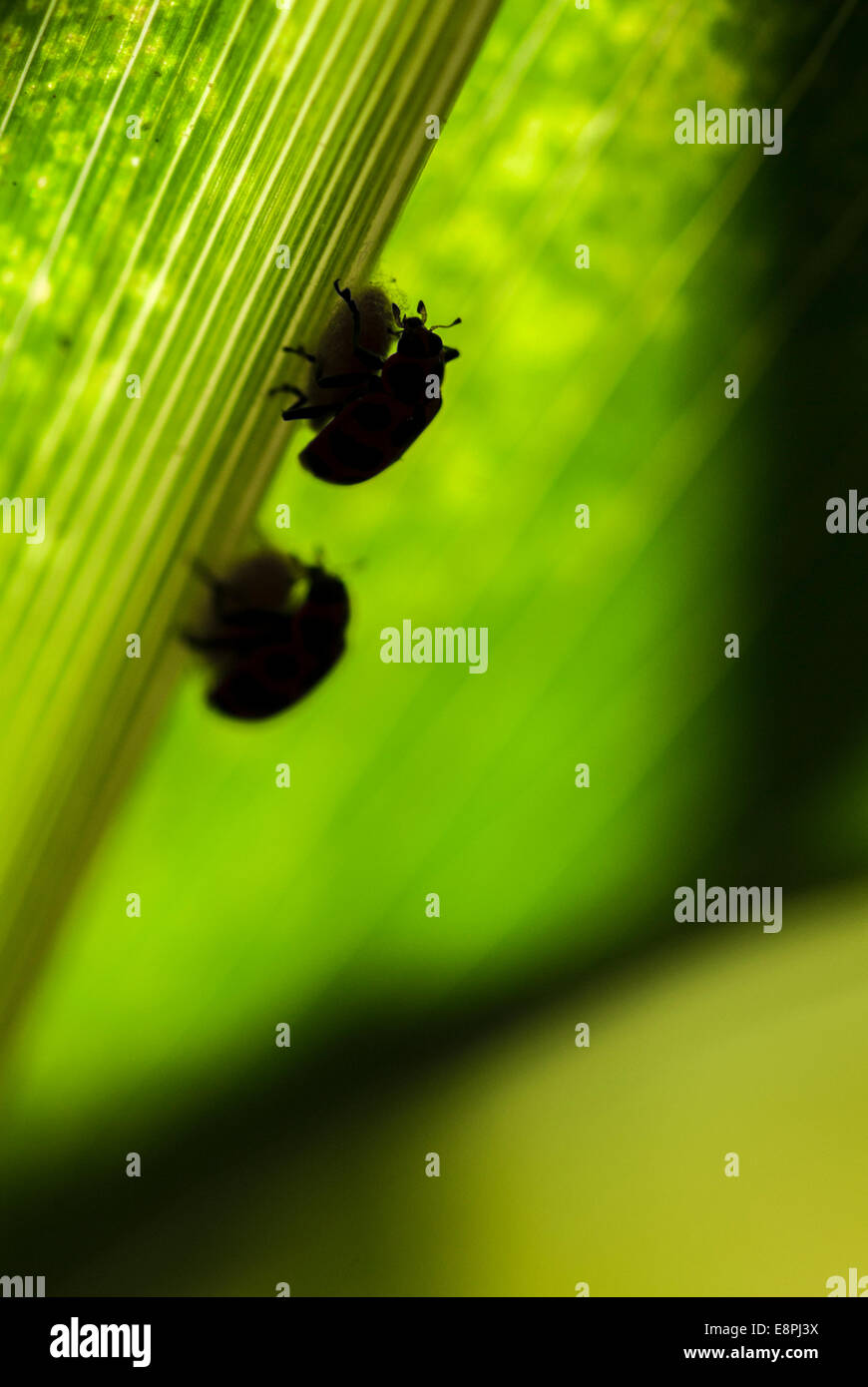 Two ladybirds (Coleomegilla maculata) on top of a parasitoid cocoon (Dinocampus coccinellae) as seen on a leaf in a cornfield. Stock Photohttps://www.alamy.com/image-license-details/?v=1https://www.alamy.com/stock-photo-two-ladybirds-coleomegilla-maculata-on-top-of-a-parasitoid-cocoon-74255886.html
Two ladybirds (Coleomegilla maculata) on top of a parasitoid cocoon (Dinocampus coccinellae) as seen on a leaf in a cornfield. Stock Photohttps://www.alamy.com/image-license-details/?v=1https://www.alamy.com/stock-photo-two-ladybirds-coleomegilla-maculata-on-top-of-a-parasitoid-cocoon-74255886.htmlRME8PJ3X–Two ladybirds (Coleomegilla maculata) on top of a parasitoid cocoon (Dinocampus coccinellae) as seen on a leaf in a cornfield.
 . Elementary entomology . Striped cucumber-beetle {Diabrotica vittatd) is about the same size, bright yellow with black stripes, and is one of the worst pests of young cucumber and melon vines. The larvae are long, slender whitish grubs which feed on the roots. The twelve-spotted Diabrotica is green with twelve black spots, with similar food habits in the adult stage, but in the South the larvae do serious injury to the roots of corn, while the larva of another pale green species, known as the west- ern corn rootworm, is one of the worst pests of corn in the northern Miss- issippi Valley. A la Stock Photohttps://www.alamy.com/image-license-details/?v=1https://www.alamy.com/elementary-entomology-striped-cucumber-beetle-diabrotica-vittatd-is-about-the-same-size-bright-yellow-with-black-stripes-and-is-one-of-the-worst-pests-of-young-cucumber-and-melon-vines-the-larvae-are-long-slender-whitish-grubs-which-feed-on-the-roots-the-twelve-spotted-diabrotica-is-green-with-twelve-black-spots-with-similar-food-habits-in-the-adult-stage-but-in-the-south-the-larvae-do-serious-injury-to-the-roots-of-corn-while-the-larva-of-another-pale-green-species-known-as-the-west-ern-corn-rootworm-is-one-of-the-worst-pests-of-corn-in-the-northern-miss-issippi-valley-a-la-image178394522.html
. Elementary entomology . Striped cucumber-beetle {Diabrotica vittatd) is about the same size, bright yellow with black stripes, and is one of the worst pests of young cucumber and melon vines. The larvae are long, slender whitish grubs which feed on the roots. The twelve-spotted Diabrotica is green with twelve black spots, with similar food habits in the adult stage, but in the South the larvae do serious injury to the roots of corn, while the larva of another pale green species, known as the west- ern corn rootworm, is one of the worst pests of corn in the northern Miss- issippi Valley. A la Stock Photohttps://www.alamy.com/image-license-details/?v=1https://www.alamy.com/elementary-entomology-striped-cucumber-beetle-diabrotica-vittatd-is-about-the-same-size-bright-yellow-with-black-stripes-and-is-one-of-the-worst-pests-of-young-cucumber-and-melon-vines-the-larvae-are-long-slender-whitish-grubs-which-feed-on-the-roots-the-twelve-spotted-diabrotica-is-green-with-twelve-black-spots-with-similar-food-habits-in-the-adult-stage-but-in-the-south-the-larvae-do-serious-injury-to-the-roots-of-corn-while-the-larva-of-another-pale-green-species-known-as-the-west-ern-corn-rootworm-is-one-of-the-worst-pests-of-corn-in-the-northern-miss-issippi-valley-a-la-image178394522.htmlRMMA6G0X–. Elementary entomology . Striped cucumber-beetle {Diabrotica vittatd) is about the same size, bright yellow with black stripes, and is one of the worst pests of young cucumber and melon vines. The larvae are long, slender whitish grubs which feed on the roots. The twelve-spotted Diabrotica is green with twelve black spots, with similar food habits in the adult stage, but in the South the larvae do serious injury to the roots of corn, while the larva of another pale green species, known as the west- ern corn rootworm, is one of the worst pests of corn in the northern Miss- issippi Valley. A la
![Economic entomology for the farmer and fruit-grower [microform] : and for use as a text-book in agricultural schools and colleges . economicentomolo00insmit Year: 1896 Fig. 210. Fig. 207, Le7na trilineata. Fig. 208, a, a, larvae ; c, pupa; d, eggs of Lema trilineata. Fig. 209, Diabrotica i2-pU7ictata: a, egg; b, larva; c, injury in corn-stalk; d, pupa; e, beetle. Fig. 210, Diabrotica longicornis: a, adult; b, pupa; c, larva ; rf, same in its case. Fig. 211, Diabrotica vittata. Fig. 212, larva of same. Fig. 213, its pupa. 216 Stock Photo Economic entomology for the farmer and fruit-grower [microform] : and for use as a text-book in agricultural schools and colleges . economicentomolo00insmit Year: 1896 Fig. 210. Fig. 207, Le7na trilineata. Fig. 208, a, a, larvae ; c, pupa; d, eggs of Lema trilineata. Fig. 209, Diabrotica i2-pU7ictata: a, egg; b, larva; c, injury in corn-stalk; d, pupa; e, beetle. Fig. 210, Diabrotica longicornis: a, adult; b, pupa; c, larva ; rf, same in its case. Fig. 211, Diabrotica vittata. Fig. 212, larva of same. Fig. 213, its pupa. 216 Stock Photo](https://c8.alamy.com/comp/T03H54/economic-entomology-for-the-farmer-and-fruit-grower-microform-and-for-use-as-a-text-book-in-agricultural-schools-and-colleges-economicentomolo00insmit-year-1896-fig-210-fig-207-le7na-trilineata-fig-208-a-a-larvae-c-pupa-d-eggs-of-lema-trilineata-fig-209-diabrotica-i2-pu7ictata-a-egg-b-larva-c-injury-in-corn-stalk-d-pupa-e-beetle-fig-210-diabrotica-longicornis-a-adult-b-pupa-c-larva-rf-same-in-its-case-fig-211-diabrotica-vittata-fig-212-larva-of-same-fig-213-its-pupa-216-T03H54.jpg) Economic entomology for the farmer and fruit-grower [microform] : and for use as a text-book in agricultural schools and colleges . economicentomolo00insmit Year: 1896 Fig. 210. Fig. 207, Le7na trilineata. Fig. 208, a, a, larvae ; c, pupa; d, eggs of Lema trilineata. Fig. 209, Diabrotica i2-pU7ictata: a, egg; b, larva; c, injury in corn-stalk; d, pupa; e, beetle. Fig. 210, Diabrotica longicornis: a, adult; b, pupa; c, larva ; rf, same in its case. Fig. 211, Diabrotica vittata. Fig. 212, larva of same. Fig. 213, its pupa. 216 Stock Photohttps://www.alamy.com/image-license-details/?v=1https://www.alamy.com/economic-entomology-for-the-farmer-and-fruit-grower-microform-and-for-use-as-a-text-book-in-agricultural-schools-and-colleges-economicentomolo00insmit-year-1896-fig-210-fig-207-le7na-trilineata-fig-208-a-a-larvae-c-pupa-d-eggs-of-lema-trilineata-fig-209-diabrotica-i2-pu7ictata-a-egg-b-larva-c-injury-in-corn-stalk-d-pupa-e-beetle-fig-210-diabrotica-longicornis-a-adult-b-pupa-c-larva-rf-same-in-its-case-fig-211-diabrotica-vittata-fig-212-larva-of-same-fig-213-its-pupa-216-image241024480.html
Economic entomology for the farmer and fruit-grower [microform] : and for use as a text-book in agricultural schools and colleges . economicentomolo00insmit Year: 1896 Fig. 210. Fig. 207, Le7na trilineata. Fig. 208, a, a, larvae ; c, pupa; d, eggs of Lema trilineata. Fig. 209, Diabrotica i2-pU7ictata: a, egg; b, larva; c, injury in corn-stalk; d, pupa; e, beetle. Fig. 210, Diabrotica longicornis: a, adult; b, pupa; c, larva ; rf, same in its case. Fig. 211, Diabrotica vittata. Fig. 212, larva of same. Fig. 213, its pupa. 216 Stock Photohttps://www.alamy.com/image-license-details/?v=1https://www.alamy.com/economic-entomology-for-the-farmer-and-fruit-grower-microform-and-for-use-as-a-text-book-in-agricultural-schools-and-colleges-economicentomolo00insmit-year-1896-fig-210-fig-207-le7na-trilineata-fig-208-a-a-larvae-c-pupa-d-eggs-of-lema-trilineata-fig-209-diabrotica-i2-pu7ictata-a-egg-b-larva-c-injury-in-corn-stalk-d-pupa-e-beetle-fig-210-diabrotica-longicornis-a-adult-b-pupa-c-larva-rf-same-in-its-case-fig-211-diabrotica-vittata-fig-212-larva-of-same-fig-213-its-pupa-216-image241024480.htmlRMT03H54–Economic entomology for the farmer and fruit-grower [microform] : and for use as a text-book in agricultural schools and colleges . economicentomolo00insmit Year: 1896 Fig. 210. Fig. 207, Le7na trilineata. Fig. 208, a, a, larvae ; c, pupa; d, eggs of Lema trilineata. Fig. 209, Diabrotica i2-pU7ictata: a, egg; b, larva; c, injury in corn-stalk; d, pupa; e, beetle. Fig. 210, Diabrotica longicornis: a, adult; b, pupa; c, larva ; rf, same in its case. Fig. 211, Diabrotica vittata. Fig. 212, larva of same. Fig. 213, its pupa. 216
 Larva and damaged cereal plant by corn ground beetle (Zabrus tenebrioides) is a species of black ground beetle (Carabidae). A pest in soil Stock Photohttps://www.alamy.com/image-license-details/?v=1https://www.alamy.com/larva-and-damaged-cereal-plant-by-corn-ground-beetle-zabrus-tenebrioides-is-a-species-of-black-ground-beetle-carabidae-a-pest-in-soil-image451829527.html
Larva and damaged cereal plant by corn ground beetle (Zabrus tenebrioides) is a species of black ground beetle (Carabidae). A pest in soil Stock Photohttps://www.alamy.com/image-license-details/?v=1https://www.alamy.com/larva-and-damaged-cereal-plant-by-corn-ground-beetle-zabrus-tenebrioides-is-a-species-of-black-ground-beetle-carabidae-a-pest-in-soil-image451829527.htmlRF2H72H4R–Larva and damaged cereal plant by corn ground beetle (Zabrus tenebrioides) is a species of black ground beetle (Carabidae). A pest in soil
 Losses to corn, what to look for and where to find it . NORTHERN CORN ROOT WORM.1. Larva; 2. Beetle; 3, 4, 5, and 6. Corn roots eaten by the worm. Shortly after midsummer the root worm becomes full-fledged, pupates, and emerges as a grass-green beetle. Thisbeetle feeds on the silk at the top of the ear, and when thisdries works its way down inside the husk and feeds upon thecorn itself. Before the beetles die they leave the corn andlay their eggs in the ground. The eggs hatch in the spring,and the life cycle is thus completed. 23 The beetles of the southern root worm are larger thanthose of th Stock Photohttps://www.alamy.com/image-license-details/?v=1https://www.alamy.com/losses-to-corn-what-to-look-for-and-where-to-find-it-northern-corn-root-worm1-larva-2-beetle-3-4-5-and-6-corn-roots-eaten-by-the-worm-shortly-after-midsummer-the-root-worm-becomes-full-fledged-pupates-and-emerges-as-a-grass-green-beetle-thisbeetle-feeds-on-the-silk-at-the-top-of-the-ear-and-when-thisdries-works-its-way-down-inside-the-husk-and-feeds-upon-thecorn-itself-before-the-beetles-die-they-leave-the-corn-andlay-their-eggs-in-the-ground-the-eggs-hatch-in-the-springand-the-life-cycle-is-thus-completed-23-the-beetles-of-the-southern-root-worm-are-larger-thanthose-of-th-image340037660.html
Losses to corn, what to look for and where to find it . NORTHERN CORN ROOT WORM.1. Larva; 2. Beetle; 3, 4, 5, and 6. Corn roots eaten by the worm. Shortly after midsummer the root worm becomes full-fledged, pupates, and emerges as a grass-green beetle. Thisbeetle feeds on the silk at the top of the ear, and when thisdries works its way down inside the husk and feeds upon thecorn itself. Before the beetles die they leave the corn andlay their eggs in the ground. The eggs hatch in the spring,and the life cycle is thus completed. 23 The beetles of the southern root worm are larger thanthose of th Stock Photohttps://www.alamy.com/image-license-details/?v=1https://www.alamy.com/losses-to-corn-what-to-look-for-and-where-to-find-it-northern-corn-root-worm1-larva-2-beetle-3-4-5-and-6-corn-roots-eaten-by-the-worm-shortly-after-midsummer-the-root-worm-becomes-full-fledged-pupates-and-emerges-as-a-grass-green-beetle-thisbeetle-feeds-on-the-silk-at-the-top-of-the-ear-and-when-thisdries-works-its-way-down-inside-the-husk-and-feeds-upon-thecorn-itself-before-the-beetles-die-they-leave-the-corn-andlay-their-eggs-in-the-ground-the-eggs-hatch-in-the-springand-the-life-cycle-is-thus-completed-23-the-beetles-of-the-southern-root-worm-are-larger-thanthose-of-th-image340037660.htmlRM2AN61E4–Losses to corn, what to look for and where to find it . NORTHERN CORN ROOT WORM.1. Larva; 2. Beetle; 3, 4, 5, and 6. Corn roots eaten by the worm. Shortly after midsummer the root worm becomes full-fledged, pupates, and emerges as a grass-green beetle. Thisbeetle feeds on the silk at the top of the ear, and when thisdries works its way down inside the husk and feeds upon thecorn itself. Before the beetles die they leave the corn andlay their eggs in the ground. The eggs hatch in the spring,and the life cycle is thus completed. 23 The beetles of the southern root worm are larger thanthose of th
![. Elementary entomology . striped cucumber-beetle (Diabrotica vittatd] is about the same size, bright yellow with black stripes, and is one of the worst pests of young cucumber and melon vines. The larvae are long, slender whitish grubs which feed on the roots. The twelve-spotted Diabrotica is green with twelve black spots, with similar food habits in the adult stage, but in the )tnpec $outn tjie iarvae do serious injury to the roots of cucumber-beetle J J corn, while the larva of another pale green species, known as the west- ern corn rootworm, is one of the worst pests of corn in the norther Stock Photo . Elementary entomology . striped cucumber-beetle (Diabrotica vittatd] is about the same size, bright yellow with black stripes, and is one of the worst pests of young cucumber and melon vines. The larvae are long, slender whitish grubs which feed on the roots. The twelve-spotted Diabrotica is green with twelve black spots, with similar food habits in the adult stage, but in the )tnpec $outn tjie iarvae do serious injury to the roots of cucumber-beetle J J corn, while the larva of another pale green species, known as the west- ern corn rootworm, is one of the worst pests of corn in the norther Stock Photo](https://c8.alamy.com/comp/MA714G/elementary-entomology-striped-cucumber-beetle-diabrotica-vittatd-is-about-the-same-size-bright-yellow-with-black-stripes-and-is-one-of-the-worst-pests-of-young-cucumber-and-melon-vines-the-larvae-are-long-slender-whitish-grubs-which-feed-on-the-roots-the-twelve-spotted-diabrotica-is-green-with-twelve-black-spots-with-similar-food-habits-in-the-adult-stage-but-in-the-tnpec-outn-tjie-iarvae-do-serious-injury-to-the-roots-of-cucumber-beetle-j-j-corn-while-the-larva-of-another-pale-green-species-known-as-the-west-ern-corn-rootworm-is-one-of-the-worst-pests-of-corn-in-the-norther-MA714G.jpg) . Elementary entomology . striped cucumber-beetle (Diabrotica vittatd] is about the same size, bright yellow with black stripes, and is one of the worst pests of young cucumber and melon vines. The larvae are long, slender whitish grubs which feed on the roots. The twelve-spotted Diabrotica is green with twelve black spots, with similar food habits in the adult stage, but in the )tnpec $outn tjie iarvae do serious injury to the roots of cucumber-beetle J J corn, while the larva of another pale green species, known as the west- ern corn rootworm, is one of the worst pests of corn in the norther Stock Photohttps://www.alamy.com/image-license-details/?v=1https://www.alamy.com/elementary-entomology-striped-cucumber-beetle-diabrotica-vittatd-is-about-the-same-size-bright-yellow-with-black-stripes-and-is-one-of-the-worst-pests-of-young-cucumber-and-melon-vines-the-larvae-are-long-slender-whitish-grubs-which-feed-on-the-roots-the-twelve-spotted-diabrotica-is-green-with-twelve-black-spots-with-similar-food-habits-in-the-adult-stage-but-in-the-tnpec-outn-tjie-iarvae-do-serious-injury-to-the-roots-of-cucumber-beetle-j-j-corn-while-the-larva-of-another-pale-green-species-known-as-the-west-ern-corn-rootworm-is-one-of-the-worst-pests-of-corn-in-the-norther-image178404816.html
. Elementary entomology . striped cucumber-beetle (Diabrotica vittatd] is about the same size, bright yellow with black stripes, and is one of the worst pests of young cucumber and melon vines. The larvae are long, slender whitish grubs which feed on the roots. The twelve-spotted Diabrotica is green with twelve black spots, with similar food habits in the adult stage, but in the )tnpec $outn tjie iarvae do serious injury to the roots of cucumber-beetle J J corn, while the larva of another pale green species, known as the west- ern corn rootworm, is one of the worst pests of corn in the norther Stock Photohttps://www.alamy.com/image-license-details/?v=1https://www.alamy.com/elementary-entomology-striped-cucumber-beetle-diabrotica-vittatd-is-about-the-same-size-bright-yellow-with-black-stripes-and-is-one-of-the-worst-pests-of-young-cucumber-and-melon-vines-the-larvae-are-long-slender-whitish-grubs-which-feed-on-the-roots-the-twelve-spotted-diabrotica-is-green-with-twelve-black-spots-with-similar-food-habits-in-the-adult-stage-but-in-the-tnpec-outn-tjie-iarvae-do-serious-injury-to-the-roots-of-cucumber-beetle-j-j-corn-while-the-larva-of-another-pale-green-species-known-as-the-west-ern-corn-rootworm-is-one-of-the-worst-pests-of-corn-in-the-norther-image178404816.htmlRMMA714G–. Elementary entomology . striped cucumber-beetle (Diabrotica vittatd] is about the same size, bright yellow with black stripes, and is one of the worst pests of young cucumber and melon vines. The larvae are long, slender whitish grubs which feed on the roots. The twelve-spotted Diabrotica is green with twelve black spots, with similar food habits in the adult stage, but in the )tnpec $outn tjie iarvae do serious injury to the roots of cucumber-beetle J J corn, while the larva of another pale green species, known as the west- ern corn rootworm, is one of the worst pests of corn in the norther
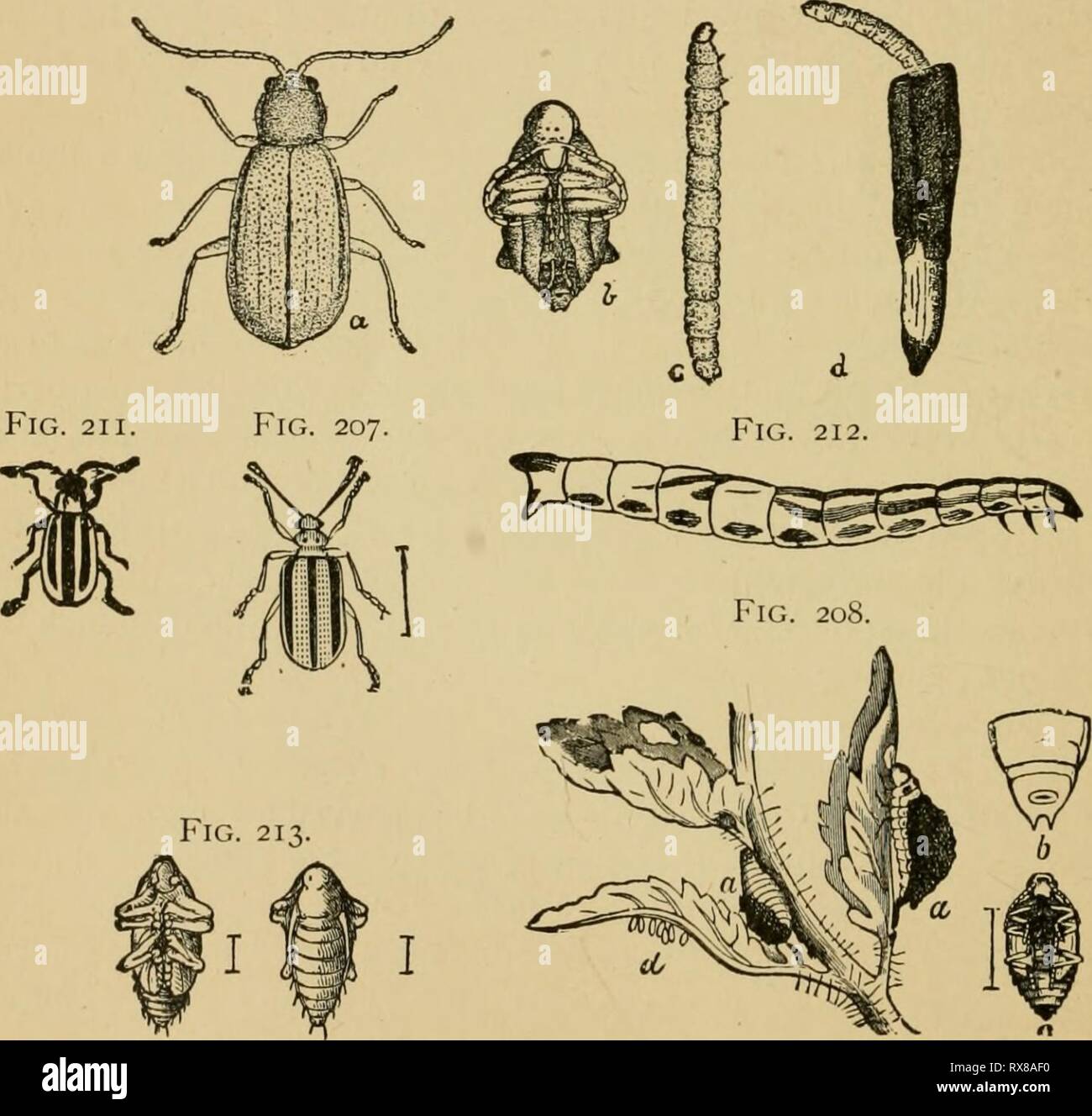 Economic entomology for the farmer Economic entomology for the farmer and the fruit grower, and for use as a text-book in agricultural schools and colleges; economicentomol00smit Year: 1906 Fig. 210. Fig. 207, Lenia Irilineata. Fig. 208, a, a, larva; ; c, pupa ; d, eggs of Lema IriUneata. Fig. 209, Diabroiica 12-punctata: a, egg; b, larva; c, injury in corn-stalk; d, pupa; e, beetle. Fig. 210, Diabrotica longicornis: a, adult; b, pupa ; c, larva ; d, same in its case. ¥g.-211, Diabroiica vitlata. Fig. 212, larva of same. Fig. 213, its pupa. 216 Stock Photohttps://www.alamy.com/image-license-details/?v=1https://www.alamy.com/economic-entomology-for-the-farmer-economic-entomology-for-the-farmer-and-the-fruit-grower-and-for-use-as-a-text-book-in-agricultural-schools-and-colleges-economicentomol00smit-year-1906-fig-210-fig-207-lenia-irilineata-fig-208-a-a-larva-c-pupa-d-eggs-of-lema-iriuneata-fig-209-diabroiica-12-punctata-a-egg-b-larva-c-injury-in-corn-stalk-d-pupa-e-beetle-fig-210-diabrotica-longicornis-a-adult-b-pupa-c-larva-d-same-in-its-case-g-211-diabroiica-vitlata-fig-212-larva-of-same-fig-213-its-pupa-216-image239899716.html
Economic entomology for the farmer Economic entomology for the farmer and the fruit grower, and for use as a text-book in agricultural schools and colleges; economicentomol00smit Year: 1906 Fig. 210. Fig. 207, Lenia Irilineata. Fig. 208, a, a, larva; ; c, pupa ; d, eggs of Lema IriUneata. Fig. 209, Diabroiica 12-punctata: a, egg; b, larva; c, injury in corn-stalk; d, pupa; e, beetle. Fig. 210, Diabrotica longicornis: a, adult; b, pupa ; c, larva ; d, same in its case. ¥g.-211, Diabroiica vitlata. Fig. 212, larva of same. Fig. 213, its pupa. 216 Stock Photohttps://www.alamy.com/image-license-details/?v=1https://www.alamy.com/economic-entomology-for-the-farmer-economic-entomology-for-the-farmer-and-the-fruit-grower-and-for-use-as-a-text-book-in-agricultural-schools-and-colleges-economicentomol00smit-year-1906-fig-210-fig-207-lenia-irilineata-fig-208-a-a-larva-c-pupa-d-eggs-of-lema-iriuneata-fig-209-diabroiica-12-punctata-a-egg-b-larva-c-injury-in-corn-stalk-d-pupa-e-beetle-fig-210-diabrotica-longicornis-a-adult-b-pupa-c-larva-d-same-in-its-case-g-211-diabroiica-vitlata-fig-212-larva-of-same-fig-213-its-pupa-216-image239899716.htmlRMRX8AF0–Economic entomology for the farmer Economic entomology for the farmer and the fruit grower, and for use as a text-book in agricultural schools and colleges; economicentomol00smit Year: 1906 Fig. 210. Fig. 207, Lenia Irilineata. Fig. 208, a, a, larva; ; c, pupa ; d, eggs of Lema IriUneata. Fig. 209, Diabroiica 12-punctata: a, egg; b, larva; c, injury in corn-stalk; d, pupa; e, beetle. Fig. 210, Diabrotica longicornis: a, adult; b, pupa ; c, larva ; d, same in its case. ¥g.-211, Diabroiica vitlata. Fig. 212, larva of same. Fig. 213, its pupa. 216
 Larva and damaged cereal plant by corn ground beetle (Zabrus tenebrioides) is a species of black ground beetle (Carabidae). A pest in soil Stock Photohttps://www.alamy.com/image-license-details/?v=1https://www.alamy.com/larva-and-damaged-cereal-plant-by-corn-ground-beetle-zabrus-tenebrioides-is-a-species-of-black-ground-beetle-carabidae-a-pest-in-soil-image451829548.html
Larva and damaged cereal plant by corn ground beetle (Zabrus tenebrioides) is a species of black ground beetle (Carabidae). A pest in soil Stock Photohttps://www.alamy.com/image-license-details/?v=1https://www.alamy.com/larva-and-damaged-cereal-plant-by-corn-ground-beetle-zabrus-tenebrioides-is-a-species-of-black-ground-beetle-carabidae-a-pest-in-soil-image451829548.htmlRF2H72H5G–Larva and damaged cereal plant by corn ground beetle (Zabrus tenebrioides) is a species of black ground beetle (Carabidae). A pest in soil
 Successful farming : a ready reference on all phases of agriculture for farmers of the United States and Canada . ??*fflfc!** - •» Green Bug, or Spring Grain Aphis (Toxoplera graminum).1 Wheat plant showing winged and wingless viviparous females with theiryoung clustered on leaves, and a few parasitized individuals on lower leaves.About natural size. Bur. Ent. Bull 110. (975) 976 SUCCESSFUL FARMING. Southern Corn Root Worm(Diabrotica duodecimpunctata).A—Beetle. B—Egg. C—Larva. segment of larva.stalk. F—Pupa. is reduced. D—AnalE—Work of larva at base of cornAll much enlarged except E, which two Stock Photohttps://www.alamy.com/image-license-details/?v=1https://www.alamy.com/successful-farming-a-ready-reference-on-all-phases-of-agriculture-for-farmers-of-the-united-states-and-canada-fflfc!-green-bug-or-spring-grain-aphis-toxoplera-graminum1-wheat-plant-showing-winged-and-wingless-viviparous-females-with-theiryoung-clustered-on-leaves-and-a-few-parasitized-individuals-on-lower-leavesabout-natural-size-bur-ent-bull-110-975-976-successful-farming-southern-corn-root-wormdiabrotica-duodecimpunctataabeetle-begg-clarva-segment-of-larvastalk-fpupa-is-reduced-danalework-of-larva-at-base-of-cornall-much-enlarged-except-e-which-two-image342956661.html
Successful farming : a ready reference on all phases of agriculture for farmers of the United States and Canada . ??*fflfc!** - •» Green Bug, or Spring Grain Aphis (Toxoplera graminum).1 Wheat plant showing winged and wingless viviparous females with theiryoung clustered on leaves, and a few parasitized individuals on lower leaves.About natural size. Bur. Ent. Bull 110. (975) 976 SUCCESSFUL FARMING. Southern Corn Root Worm(Diabrotica duodecimpunctata).A—Beetle. B—Egg. C—Larva. segment of larva.stalk. F—Pupa. is reduced. D—AnalE—Work of larva at base of cornAll much enlarged except E, which two Stock Photohttps://www.alamy.com/image-license-details/?v=1https://www.alamy.com/successful-farming-a-ready-reference-on-all-phases-of-agriculture-for-farmers-of-the-united-states-and-canada-fflfc!-green-bug-or-spring-grain-aphis-toxoplera-graminum1-wheat-plant-showing-winged-and-wingless-viviparous-females-with-theiryoung-clustered-on-leaves-and-a-few-parasitized-individuals-on-lower-leavesabout-natural-size-bur-ent-bull-110-975-976-successful-farming-southern-corn-root-wormdiabrotica-duodecimpunctataabeetle-begg-clarva-segment-of-larvastalk-fpupa-is-reduced-danalework-of-larva-at-base-of-cornall-much-enlarged-except-e-which-two-image342956661.htmlRM2AWY0M5–Successful farming : a ready reference on all phases of agriculture for farmers of the United States and Canada . ??*fflfc!** - •» Green Bug, or Spring Grain Aphis (Toxoplera graminum).1 Wheat plant showing winged and wingless viviparous females with theiryoung clustered on leaves, and a few parasitized individuals on lower leaves.About natural size. Bur. Ent. Bull 110. (975) 976 SUCCESSFUL FARMING. Southern Corn Root Worm(Diabrotica duodecimpunctata).A—Beetle. B—Egg. C—Larva. segment of larva.stalk. F—Pupa. is reduced. D—AnalE—Work of larva at base of cornAll much enlarged except E, which two
 Larva and damaged cereal plant by corn ground beetle (Zabrus tenebrioides) is a species of black ground beetle (Carabidae). A pest in soil Stock Photohttps://www.alamy.com/image-license-details/?v=1https://www.alamy.com/larva-and-damaged-cereal-plant-by-corn-ground-beetle-zabrus-tenebrioides-is-a-species-of-black-ground-beetle-carabidae-a-pest-in-soil-image451829504.html
Larva and damaged cereal plant by corn ground beetle (Zabrus tenebrioides) is a species of black ground beetle (Carabidae). A pest in soil Stock Photohttps://www.alamy.com/image-license-details/?v=1https://www.alamy.com/larva-and-damaged-cereal-plant-by-corn-ground-beetle-zabrus-tenebrioides-is-a-species-of-black-ground-beetle-carabidae-a-pest-in-soil-image451829504.htmlRF2H72H40–Larva and damaged cereal plant by corn ground beetle (Zabrus tenebrioides) is a species of black ground beetle (Carabidae). A pest in soil
 Losses to corn, what to look for and where to find it . THE CORN ROOT WORM.Showing the worm at work in corn root. (Enlarged.). NORTHERN CORN ROOT WORM.1. Larva; 2. Beetle; 3, 4, 5, and 6. Corn roots eaten by the worm. Shortly after midsummer the root worm becomes full-fledged, pupates, and emerges as a grass-green beetle. Thisbeetle feeds on the silk at the top of the ear, and when thisdries works its way down inside the husk and feeds upon thecorn itself. Before the beetles die they leave the corn andlay their eggs in the ground. The eggs hatch in the spring,and the life cycle is thus complet Stock Photohttps://www.alamy.com/image-license-details/?v=1https://www.alamy.com/losses-to-corn-what-to-look-for-and-where-to-find-it-the-corn-root-wormshowing-the-worm-at-work-in-corn-root-enlarged-northern-corn-root-worm1-larva-2-beetle-3-4-5-and-6-corn-roots-eaten-by-the-worm-shortly-after-midsummer-the-root-worm-becomes-full-fledged-pupates-and-emerges-as-a-grass-green-beetle-thisbeetle-feeds-on-the-silk-at-the-top-of-the-ear-and-when-thisdries-works-its-way-down-inside-the-husk-and-feeds-upon-thecorn-itself-before-the-beetles-die-they-leave-the-corn-andlay-their-eggs-in-the-ground-the-eggs-hatch-in-the-springand-the-life-cycle-is-thus-complet-image340037855.html
Losses to corn, what to look for and where to find it . THE CORN ROOT WORM.Showing the worm at work in corn root. (Enlarged.). NORTHERN CORN ROOT WORM.1. Larva; 2. Beetle; 3, 4, 5, and 6. Corn roots eaten by the worm. Shortly after midsummer the root worm becomes full-fledged, pupates, and emerges as a grass-green beetle. Thisbeetle feeds on the silk at the top of the ear, and when thisdries works its way down inside the husk and feeds upon thecorn itself. Before the beetles die they leave the corn andlay their eggs in the ground. The eggs hatch in the spring,and the life cycle is thus complet Stock Photohttps://www.alamy.com/image-license-details/?v=1https://www.alamy.com/losses-to-corn-what-to-look-for-and-where-to-find-it-the-corn-root-wormshowing-the-worm-at-work-in-corn-root-enlarged-northern-corn-root-worm1-larva-2-beetle-3-4-5-and-6-corn-roots-eaten-by-the-worm-shortly-after-midsummer-the-root-worm-becomes-full-fledged-pupates-and-emerges-as-a-grass-green-beetle-thisbeetle-feeds-on-the-silk-at-the-top-of-the-ear-and-when-thisdries-works-its-way-down-inside-the-husk-and-feeds-upon-thecorn-itself-before-the-beetles-die-they-leave-the-corn-andlay-their-eggs-in-the-ground-the-eggs-hatch-in-the-springand-the-life-cycle-is-thus-complet-image340037855.htmlRM2AN61N3–Losses to corn, what to look for and where to find it . THE CORN ROOT WORM.Showing the worm at work in corn root. (Enlarged.). NORTHERN CORN ROOT WORM.1. Larva; 2. Beetle; 3, 4, 5, and 6. Corn roots eaten by the worm. Shortly after midsummer the root worm becomes full-fledged, pupates, and emerges as a grass-green beetle. Thisbeetle feeds on the silk at the top of the ear, and when thisdries works its way down inside the husk and feeds upon thecorn itself. Before the beetles die they leave the corn andlay their eggs in the ground. The eggs hatch in the spring,and the life cycle is thus complet
 Larva and damaged cereal plant by corn ground beetle (Zabrus tenebrioides) is a species of black ground beetle (Carabidae). A pest in soil Stock Photohttps://www.alamy.com/image-license-details/?v=1https://www.alamy.com/larva-and-damaged-cereal-plant-by-corn-ground-beetle-zabrus-tenebrioides-is-a-species-of-black-ground-beetle-carabidae-a-pest-in-soil-image451829543.html
Larva and damaged cereal plant by corn ground beetle (Zabrus tenebrioides) is a species of black ground beetle (Carabidae). A pest in soil Stock Photohttps://www.alamy.com/image-license-details/?v=1https://www.alamy.com/larva-and-damaged-cereal-plant-by-corn-ground-beetle-zabrus-tenebrioides-is-a-species-of-black-ground-beetle-carabidae-a-pest-in-soil-image451829543.htmlRF2H72H5B–Larva and damaged cereal plant by corn ground beetle (Zabrus tenebrioides) is a species of black ground beetle (Carabidae). A pest in soil
 Corn secrets . z Fig. 12 Fig. 12. Different Stages in the Growth of the Corn-root Worm.—(a)shows larva or worm enlarged nine times; (2) shows actual size. This is about 38 CORN SECRETS as it looks during the last part of June and the first part of July when it isthree-fourths grown and doing the greatest damage by eating back and forthjust under the outer covering of the root, and frequently eating through thecenter of the root. (6) full-grown worm which has crawled out of the root intothe earth and is ready to pupate, i. e., change into a beetle, (c) thickened upand in the first stages of pup Stock Photohttps://www.alamy.com/image-license-details/?v=1https://www.alamy.com/corn-secrets-z-fig-12-fig-12-different-stages-in-the-growth-of-the-corn-root-wormashows-larva-or-worm-enlarged-nine-times-2-shows-actual-size-this-is-about-38-corn-secrets-as-it-looks-during-the-last-part-of-june-and-the-first-part-of-july-when-it-isthree-fourths-grown-and-doing-the-greatest-damage-by-eating-back-and-forthjust-under-the-outer-covering-of-the-root-and-frequently-eating-through-thecenter-of-the-root-6-full-grown-worm-which-has-crawled-out-of-the-root-intothe-earth-and-is-ready-to-pupate-i-e-change-into-a-beetle-c-thickened-upand-in-the-first-stages-of-pup-image340225226.html
Corn secrets . z Fig. 12 Fig. 12. Different Stages in the Growth of the Corn-root Worm.—(a)shows larva or worm enlarged nine times; (2) shows actual size. This is about 38 CORN SECRETS as it looks during the last part of June and the first part of July when it isthree-fourths grown and doing the greatest damage by eating back and forthjust under the outer covering of the root, and frequently eating through thecenter of the root. (6) full-grown worm which has crawled out of the root intothe earth and is ready to pupate, i. e., change into a beetle, (c) thickened upand in the first stages of pup Stock Photohttps://www.alamy.com/image-license-details/?v=1https://www.alamy.com/corn-secrets-z-fig-12-fig-12-different-stages-in-the-growth-of-the-corn-root-wormashows-larva-or-worm-enlarged-nine-times-2-shows-actual-size-this-is-about-38-corn-secrets-as-it-looks-during-the-last-part-of-june-and-the-first-part-of-july-when-it-isthree-fourths-grown-and-doing-the-greatest-damage-by-eating-back-and-forthjust-under-the-outer-covering-of-the-root-and-frequently-eating-through-thecenter-of-the-root-6-full-grown-worm-which-has-crawled-out-of-the-root-intothe-earth-and-is-ready-to-pupate-i-e-change-into-a-beetle-c-thickened-upand-in-the-first-stages-of-pup-image340225226.htmlRM2ANEGMX–Corn secrets . z Fig. 12 Fig. 12. Different Stages in the Growth of the Corn-root Worm.—(a)shows larva or worm enlarged nine times; (2) shows actual size. This is about 38 CORN SECRETS as it looks during the last part of June and the first part of July when it isthree-fourths grown and doing the greatest damage by eating back and forthjust under the outer covering of the root, and frequently eating through thecenter of the root. (6) full-grown worm which has crawled out of the root intothe earth and is ready to pupate, i. e., change into a beetle, (c) thickened upand in the first stages of pup
 Larva and damaged cereal plant by corn ground beetle (Zabrus tenebrioides) - a pest in soil. It is a species of black ground beetle (Carabidae). Stock Photohttps://www.alamy.com/image-license-details/?v=1https://www.alamy.com/larva-and-damaged-cereal-plant-by-corn-ground-beetle-zabrus-tenebrioides-a-pest-in-soil-it-is-a-species-of-black-ground-beetle-carabidae-image451829710.html
Larva and damaged cereal plant by corn ground beetle (Zabrus tenebrioides) - a pest in soil. It is a species of black ground beetle (Carabidae). Stock Photohttps://www.alamy.com/image-license-details/?v=1https://www.alamy.com/larva-and-damaged-cereal-plant-by-corn-ground-beetle-zabrus-tenebrioides-a-pest-in-soil-it-is-a-species-of-black-ground-beetle-carabidae-image451829710.htmlRF2H72HBA–Larva and damaged cereal plant by corn ground beetle (Zabrus tenebrioides) - a pest in soil. It is a species of black ground beetle (Carabidae).
 Corn; growing, judging, breeding, feeding, marketing; for the farmer and student of agriculture, a text-book for agricultural colleges and high schools . FIG. D Charlotte M. King. Artist PLATE VIII. Corn Root Wokm, {Diabrotica lungicurnis). A, Beetle; 13, Iupa; C, Larva; U, Larva1 Corn Koot. i COMPARATIVE GROWTH. 249. 250 CORN. forth an ear. Due to the lack of support necessarily brought aboutthrough the injury to the root system, the plants are very easily top-pled over, and are found lying in all directions, especially after a hardrain. Should there be a brisk breeze whole fields are often l Stock Photohttps://www.alamy.com/image-license-details/?v=1https://www.alamy.com/corn-growing-judging-breeding-feeding-marketing-for-the-farmer-and-student-of-agriculture-a-text-book-for-agricultural-colleges-and-high-schools-fig-d-charlotte-m-king-artist-plate-viii-corn-root-wokm-diabrotica-lungicurnis-a-beetle-13-iupa-c-larva-u-larva1-corn-koot-i-comparative-growth-249-250-corn-forth-an-ear-due-to-the-lack-of-support-necessarily-brought-aboutthrough-the-injury-to-the-root-system-the-plants-are-very-easily-top-pled-over-and-are-found-lying-in-all-directions-especially-after-a-hardrain-should-there-be-a-brisk-breeze-whole-fields-are-often-l-image343014045.html
Corn; growing, judging, breeding, feeding, marketing; for the farmer and student of agriculture, a text-book for agricultural colleges and high schools . FIG. D Charlotte M. King. Artist PLATE VIII. Corn Root Wokm, {Diabrotica lungicurnis). A, Beetle; 13, Iupa; C, Larva; U, Larva1 Corn Koot. i COMPARATIVE GROWTH. 249. 250 CORN. forth an ear. Due to the lack of support necessarily brought aboutthrough the injury to the root system, the plants are very easily top-pled over, and are found lying in all directions, especially after a hardrain. Should there be a brisk breeze whole fields are often l Stock Photohttps://www.alamy.com/image-license-details/?v=1https://www.alamy.com/corn-growing-judging-breeding-feeding-marketing-for-the-farmer-and-student-of-agriculture-a-text-book-for-agricultural-colleges-and-high-schools-fig-d-charlotte-m-king-artist-plate-viii-corn-root-wokm-diabrotica-lungicurnis-a-beetle-13-iupa-c-larva-u-larva1-corn-koot-i-comparative-growth-249-250-corn-forth-an-ear-due-to-the-lack-of-support-necessarily-brought-aboutthrough-the-injury-to-the-root-system-the-plants-are-very-easily-top-pled-over-and-are-found-lying-in-all-directions-especially-after-a-hardrain-should-there-be-a-brisk-breeze-whole-fields-are-often-l-image343014045.htmlRM2AX1HWH–Corn; growing, judging, breeding, feeding, marketing; for the farmer and student of agriculture, a text-book for agricultural colleges and high schools . FIG. D Charlotte M. King. Artist PLATE VIII. Corn Root Wokm, {Diabrotica lungicurnis). A, Beetle; 13, Iupa; C, Larva; U, Larva1 Corn Koot. i COMPARATIVE GROWTH. 249. 250 CORN. forth an ear. Due to the lack of support necessarily brought aboutthrough the injury to the root system, the plants are very easily top-pled over, and are found lying in all directions, especially after a hardrain. Should there be a brisk breeze whole fields are often l
 Larva and damaged cereal plant by corn ground beetle (Zabrus tenebrioides) - a pest in soil. It is a species of black ground beetle (Carabidae). Stock Photohttps://www.alamy.com/image-license-details/?v=1https://www.alamy.com/larva-and-damaged-cereal-plant-by-corn-ground-beetle-zabrus-tenebrioides-a-pest-in-soil-it-is-a-species-of-black-ground-beetle-carabidae-image451829264.html
Larva and damaged cereal plant by corn ground beetle (Zabrus tenebrioides) - a pest in soil. It is a species of black ground beetle (Carabidae). Stock Photohttps://www.alamy.com/image-license-details/?v=1https://www.alamy.com/larva-and-damaged-cereal-plant-by-corn-ground-beetle-zabrus-tenebrioides-a-pest-in-soil-it-is-a-species-of-black-ground-beetle-carabidae-image451829264.htmlRF2H72GRC–Larva and damaged cereal plant by corn ground beetle (Zabrus tenebrioides) - a pest in soil. It is a species of black ground beetle (Carabidae).
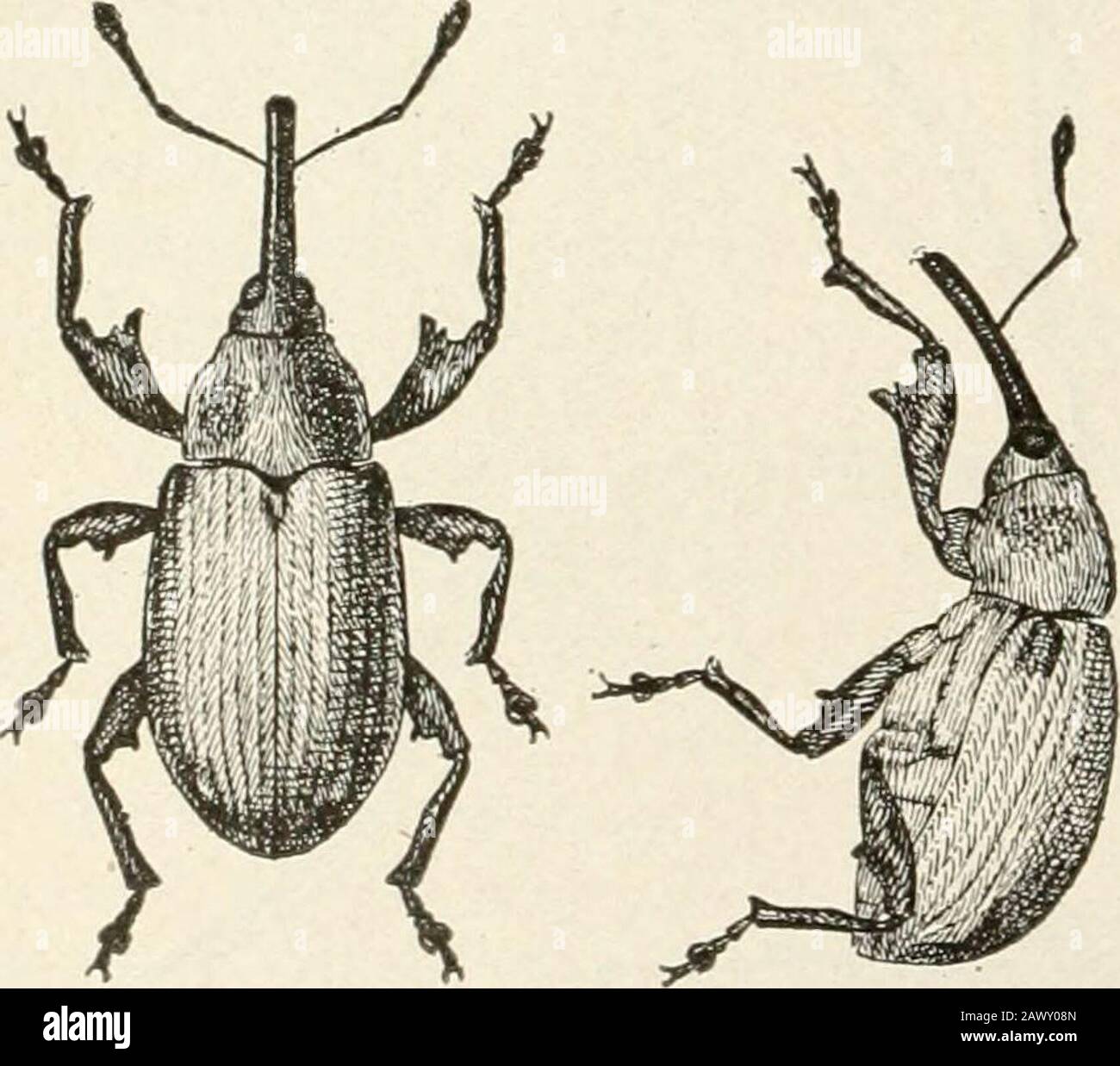 Successful farming : a ready reference on all phases of agriculture for farmers of the United States and Canada . Southern Corn Root Worm(Diabrotica duodecimpunctata).A—Beetle. B—Egg. C—Larva. segment of larva.stalk. F—Pupa. is reduced. D—AnalE—Work of larva at base of cornAll much enlarged except E, which two weeks after usual timevent most of usual injury. U. S. Dept. Agri. Cir. 51, Office ofSecretary; Farm. Bull. 640. vented by late plantingand by the destruction ofvolunteer wheat and catsin the fall. Bur. Ent. Bull. 110. The Hessian Fly (Mayetiola destructor,Say.).—This small two-winged fl Stock Photohttps://www.alamy.com/image-license-details/?v=1https://www.alamy.com/successful-farming-a-ready-reference-on-all-phases-of-agriculture-for-farmers-of-the-united-states-and-canada-southern-corn-root-wormdiabrotica-duodecimpunctataabeetle-begg-clarva-segment-of-larvastalk-fpupa-is-reduced-danalework-of-larva-at-base-of-cornall-much-enlarged-except-e-which-two-weeks-after-usual-timevent-most-of-usual-injury-u-s-dept-agri-cir-51-office-ofsecretary-farm-bull-640-vented-by-late-plantingand-by-the-destruction-ofvolunteer-wheat-and-catsin-the-fall-bur-ent-bull-110-the-hessian-fly-mayetiola-destructorsaythis-small-two-winged-fl-image342956341.html
Successful farming : a ready reference on all phases of agriculture for farmers of the United States and Canada . Southern Corn Root Worm(Diabrotica duodecimpunctata).A—Beetle. B—Egg. C—Larva. segment of larva.stalk. F—Pupa. is reduced. D—AnalE—Work of larva at base of cornAll much enlarged except E, which two weeks after usual timevent most of usual injury. U. S. Dept. Agri. Cir. 51, Office ofSecretary; Farm. Bull. 640. vented by late plantingand by the destruction ofvolunteer wheat and catsin the fall. Bur. Ent. Bull. 110. The Hessian Fly (Mayetiola destructor,Say.).—This small two-winged fl Stock Photohttps://www.alamy.com/image-license-details/?v=1https://www.alamy.com/successful-farming-a-ready-reference-on-all-phases-of-agriculture-for-farmers-of-the-united-states-and-canada-southern-corn-root-wormdiabrotica-duodecimpunctataabeetle-begg-clarva-segment-of-larvastalk-fpupa-is-reduced-danalework-of-larva-at-base-of-cornall-much-enlarged-except-e-which-two-weeks-after-usual-timevent-most-of-usual-injury-u-s-dept-agri-cir-51-office-ofsecretary-farm-bull-640-vented-by-late-plantingand-by-the-destruction-ofvolunteer-wheat-and-catsin-the-fall-bur-ent-bull-110-the-hessian-fly-mayetiola-destructorsaythis-small-two-winged-fl-image342956341.htmlRM2AWY08N–Successful farming : a ready reference on all phases of agriculture for farmers of the United States and Canada . Southern Corn Root Worm(Diabrotica duodecimpunctata).A—Beetle. B—Egg. C—Larva. segment of larva.stalk. F—Pupa. is reduced. D—AnalE—Work of larva at base of cornAll much enlarged except E, which two weeks after usual timevent most of usual injury. U. S. Dept. Agri. Cir. 51, Office ofSecretary; Farm. Bull. 640. vented by late plantingand by the destruction ofvolunteer wheat and catsin the fall. Bur. Ent. Bull. 110. The Hessian Fly (Mayetiola destructor,Say.).—This small two-winged fl
 Larva and damaged cereal plant by corn ground beetle (Zabrus tenebrioides) is a species of black ground beetle (Carabidae). A pest in soil Stock Photohttps://www.alamy.com/image-license-details/?v=1https://www.alamy.com/larva-and-damaged-cereal-plant-by-corn-ground-beetle-zabrus-tenebrioides-is-a-species-of-black-ground-beetle-carabidae-a-pest-in-soil-image451829552.html
Larva and damaged cereal plant by corn ground beetle (Zabrus tenebrioides) is a species of black ground beetle (Carabidae). A pest in soil Stock Photohttps://www.alamy.com/image-license-details/?v=1https://www.alamy.com/larva-and-damaged-cereal-plant-by-corn-ground-beetle-zabrus-tenebrioides-is-a-species-of-black-ground-beetle-carabidae-a-pest-in-soil-image451829552.htmlRF2H72H5M–Larva and damaged cereal plant by corn ground beetle (Zabrus tenebrioides) is a species of black ground beetle (Carabidae). A pest in soil
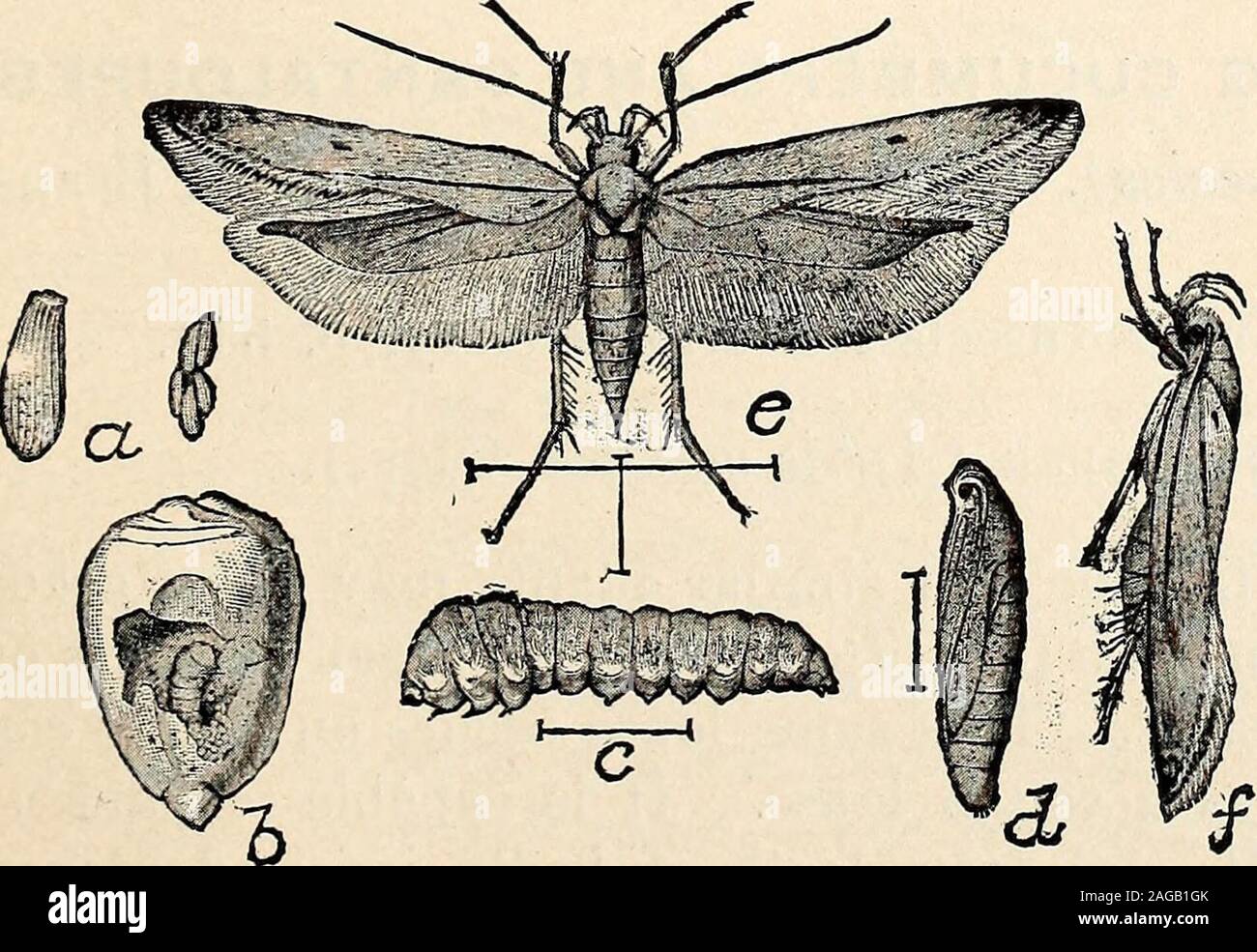 . Annual report of the North Carolina Agricultural Experiment Station. Fig. 23.—Corn Weevils : Calandra granaria ; a, beetle ;6, larva; c, pupa. C. oryzai, d, beetle. All enlarged, (Chit-tenden, Farmers Bui. 45, U. S. Dept. of Agr.) tectmg. a, e£ Fig. 24.—Angoumois Grain Mothtc, larva; d, pupa; e, f, moths—all enlargedFarmers Bui. 45, U. S. Dept of Agr.) &, larva at work ; ( Chittenden 40 N. C. AGRICULTURAL EXPERIMENT STATION. phid for about one hundred bushels of grain. The grain moth iskilled more easily than the true weevils, and for the latter it may benecessary to considerably increase th Stock Photohttps://www.alamy.com/image-license-details/?v=1https://www.alamy.com/annual-report-of-the-north-carolina-agricultural-experiment-station-fig-23corn-weevils-calandra-granaria-a-beetle-6-larva-c-pupa-c-oryzai-d-beetle-all-enlarged-chit-tenden-farmers-bui-45-u-s-dept-of-agr-tectmg-a-e-fig-24angoumois-grain-mothtc-larva-d-pupa-e-f-mothsall-enlargedfarmers-bui-45-u-s-dept-of-agr-larva-at-work-chittenden-40-n-c-agricultural-experiment-station-phid-for-about-one-hundred-bushels-of-grain-the-grain-moth-iskilled-more-easily-than-the-true-weevils-and-for-the-latter-it-may-benecessary-to-considerably-increase-th-image337074211.html
. Annual report of the North Carolina Agricultural Experiment Station. Fig. 23.—Corn Weevils : Calandra granaria ; a, beetle ;6, larva; c, pupa. C. oryzai, d, beetle. All enlarged, (Chit-tenden, Farmers Bui. 45, U. S. Dept. of Agr.) tectmg. a, e£ Fig. 24.—Angoumois Grain Mothtc, larva; d, pupa; e, f, moths—all enlargedFarmers Bui. 45, U. S. Dept of Agr.) &, larva at work ; ( Chittenden 40 N. C. AGRICULTURAL EXPERIMENT STATION. phid for about one hundred bushels of grain. The grain moth iskilled more easily than the true weevils, and for the latter it may benecessary to considerably increase th Stock Photohttps://www.alamy.com/image-license-details/?v=1https://www.alamy.com/annual-report-of-the-north-carolina-agricultural-experiment-station-fig-23corn-weevils-calandra-granaria-a-beetle-6-larva-c-pupa-c-oryzai-d-beetle-all-enlarged-chit-tenden-farmers-bui-45-u-s-dept-of-agr-tectmg-a-e-fig-24angoumois-grain-mothtc-larva-d-pupa-e-f-mothsall-enlargedfarmers-bui-45-u-s-dept-of-agr-larva-at-work-chittenden-40-n-c-agricultural-experiment-station-phid-for-about-one-hundred-bushels-of-grain-the-grain-moth-iskilled-more-easily-than-the-true-weevils-and-for-the-latter-it-may-benecessary-to-considerably-increase-th-image337074211.htmlRM2AGB1GK–. Annual report of the North Carolina Agricultural Experiment Station. Fig. 23.—Corn Weevils : Calandra granaria ; a, beetle ;6, larva; c, pupa. C. oryzai, d, beetle. All enlarged, (Chit-tenden, Farmers Bui. 45, U. S. Dept. of Agr.) tectmg. a, e£ Fig. 24.—Angoumois Grain Mothtc, larva; d, pupa; e, f, moths—all enlargedFarmers Bui. 45, U. S. Dept of Agr.) &, larva at work ; ( Chittenden 40 N. C. AGRICULTURAL EXPERIMENT STATION. phid for about one hundred bushels of grain. The grain moth iskilled more easily than the true weevils, and for the latter it may benecessary to considerably increase th
 Larva and damaged cereal plant by corn ground beetle (Zabrus tenebrioides) - a pest in soil. It is a species of black ground beetle (Carabidae). Stock Photohttps://www.alamy.com/image-license-details/?v=1https://www.alamy.com/larva-and-damaged-cereal-plant-by-corn-ground-beetle-zabrus-tenebrioides-a-pest-in-soil-it-is-a-species-of-black-ground-beetle-carabidae-image451829323.html
Larva and damaged cereal plant by corn ground beetle (Zabrus tenebrioides) - a pest in soil. It is a species of black ground beetle (Carabidae). Stock Photohttps://www.alamy.com/image-license-details/?v=1https://www.alamy.com/larva-and-damaged-cereal-plant-by-corn-ground-beetle-zabrus-tenebrioides-a-pest-in-soil-it-is-a-species-of-black-ground-beetle-carabidae-image451829323.htmlRF2H72GWF–Larva and damaged cereal plant by corn ground beetle (Zabrus tenebrioides) - a pest in soil. It is a species of black ground beetle (Carabidae).
 Farm crops, their cultivation and management, a non-technical manual for the cultivation, management and improvement of farm crops . Western Corn Root Worm (Diabrotica longicorni.s).- 1—Adult, or beetle; a, claw of hind leg; much enlai-ged. 2—Larva,or worm, much enlarged. 3—Egg, highly magnified.. Wheat Joint W^orm (Isoso77ia tritici).- 1—Adult of the joint worm much enlarged. 2—Oneeffect of the joint worm in wheat straw. iDept. Bull. 8. « Bur. Ent. Cir. 66. (261) 262 SUCCESSFUL FARMING three weeks later than* usual or after most of the first brood eggs havebeen deposited. Dept. Bull. No. 5. T Stock Photohttps://www.alamy.com/image-license-details/?v=1https://www.alamy.com/farm-crops-their-cultivation-and-management-a-non-technical-manual-for-the-cultivation-management-and-improvement-of-farm-crops-western-corn-root-worm-diabrotica-longicornis-1adult-or-beetle-a-claw-of-hind-leg-much-enlai-ged-2larvaor-worm-much-enlarged-3egg-highly-magnified-wheat-joint-worm-isoso77ia-tritici-1adult-of-the-joint-worm-much-enlarged-2oneeffect-of-the-joint-worm-in-wheat-straw-idept-bull-8-bur-ent-cir-66-261-262-successful-farming-three-weeks-later-than-usual-or-after-most-of-the-first-brood-eggs-havebeen-deposited-dept-bull-no-5-t-image343036072.html
Farm crops, their cultivation and management, a non-technical manual for the cultivation, management and improvement of farm crops . Western Corn Root Worm (Diabrotica longicorni.s).- 1—Adult, or beetle; a, claw of hind leg; much enlai-ged. 2—Larva,or worm, much enlarged. 3—Egg, highly magnified.. Wheat Joint W^orm (Isoso77ia tritici).- 1—Adult of the joint worm much enlarged. 2—Oneeffect of the joint worm in wheat straw. iDept. Bull. 8. « Bur. Ent. Cir. 66. (261) 262 SUCCESSFUL FARMING three weeks later than* usual or after most of the first brood eggs havebeen deposited. Dept. Bull. No. 5. T Stock Photohttps://www.alamy.com/image-license-details/?v=1https://www.alamy.com/farm-crops-their-cultivation-and-management-a-non-technical-manual-for-the-cultivation-management-and-improvement-of-farm-crops-western-corn-root-worm-diabrotica-longicornis-1adult-or-beetle-a-claw-of-hind-leg-much-enlai-ged-2larvaor-worm-much-enlarged-3egg-highly-magnified-wheat-joint-worm-isoso77ia-tritici-1adult-of-the-joint-worm-much-enlarged-2oneeffect-of-the-joint-worm-in-wheat-straw-idept-bull-8-bur-ent-cir-66-261-262-successful-farming-three-weeks-later-than-usual-or-after-most-of-the-first-brood-eggs-havebeen-deposited-dept-bull-no-5-t-image343036072.htmlRM2AX2J08–Farm crops, their cultivation and management, a non-technical manual for the cultivation, management and improvement of farm crops . Western Corn Root Worm (Diabrotica longicorni.s).- 1—Adult, or beetle; a, claw of hind leg; much enlai-ged. 2—Larva,or worm, much enlarged. 3—Egg, highly magnified.. Wheat Joint W^orm (Isoso77ia tritici).- 1—Adult of the joint worm much enlarged. 2—Oneeffect of the joint worm in wheat straw. iDept. Bull. 8. « Bur. Ent. Cir. 66. (261) 262 SUCCESSFUL FARMING three weeks later than* usual or after most of the first brood eggs havebeen deposited. Dept. Bull. No. 5. T
 Larva and damaged cereal plant by corn ground beetle (Zabrus tenebrioides) - a pest in soil. It is a species of black ground beetle (Carabidae). Stock Photohttps://www.alamy.com/image-license-details/?v=1https://www.alamy.com/larva-and-damaged-cereal-plant-by-corn-ground-beetle-zabrus-tenebrioides-a-pest-in-soil-it-is-a-species-of-black-ground-beetle-carabidae-image451829249.html
Larva and damaged cereal plant by corn ground beetle (Zabrus tenebrioides) - a pest in soil. It is a species of black ground beetle (Carabidae). Stock Photohttps://www.alamy.com/image-license-details/?v=1https://www.alamy.com/larva-and-damaged-cereal-plant-by-corn-ground-beetle-zabrus-tenebrioides-a-pest-in-soil-it-is-a-species-of-black-ground-beetle-carabidae-image451829249.htmlRF2H72GPW–Larva and damaged cereal plant by corn ground beetle (Zabrus tenebrioides) - a pest in soil. It is a species of black ground beetle (Carabidae).
 Economic entomology for the farmer and fruit-grower : and for use as a text-book in agricultural schools and colleges . Fig. 208.. Fig. 207, Lema trilineata. Fig. 208, a, a, larva;; c, pupa; d, eggs of Lenta trihncata.Fig 209, DiahroHca iz-punctata: a, egg; b, larva; c, injury in corn-stalk; d, pupa;e, beetle. Fig. 210, Diabrotica longicomis: a, adult; b, pupa; c, larva; rf, same in itscase. Fg,.-211, Diabrotica vittaia. Fig. 212, larva of same. Fig. 213, its pupa.216 THE INSECT WORLD. 217 The genus Galcruca contains a series of rather small, oblongspecies, mostly dirty clay-yellow in color, Stock Photohttps://www.alamy.com/image-license-details/?v=1https://www.alamy.com/economic-entomology-for-the-farmer-and-fruit-grower-and-for-use-as-a-text-book-in-agricultural-schools-and-colleges-fig-208-fig-207-lema-trilineata-fig-208-a-a-larva-c-pupa-d-eggs-of-lenta-trihncatafig-209-diahrohca-iz-punctata-a-egg-b-larva-c-injury-in-corn-stalk-d-pupae-beetle-fig-210-diabrotica-longicomis-a-adult-b-pupa-c-larva-rf-same-in-itscase-fg-211-diabrotica-vittaia-fig-212-larva-of-same-fig-213-its-pupa216-the-insect-world-217-the-genus-galcruca-contains-a-series-of-rather-small-oblongspecies-mostly-dirty-clay-yellow-in-color-image342917336.html
Economic entomology for the farmer and fruit-grower : and for use as a text-book in agricultural schools and colleges . Fig. 208.. Fig. 207, Lema trilineata. Fig. 208, a, a, larva;; c, pupa; d, eggs of Lenta trihncata.Fig 209, DiahroHca iz-punctata: a, egg; b, larva; c, injury in corn-stalk; d, pupa;e, beetle. Fig. 210, Diabrotica longicomis: a, adult; b, pupa; c, larva; rf, same in itscase. Fg,.-211, Diabrotica vittaia. Fig. 212, larva of same. Fig. 213, its pupa.216 THE INSECT WORLD. 217 The genus Galcruca contains a series of rather small, oblongspecies, mostly dirty clay-yellow in color, Stock Photohttps://www.alamy.com/image-license-details/?v=1https://www.alamy.com/economic-entomology-for-the-farmer-and-fruit-grower-and-for-use-as-a-text-book-in-agricultural-schools-and-colleges-fig-208-fig-207-lema-trilineata-fig-208-a-a-larva-c-pupa-d-eggs-of-lenta-trihncatafig-209-diahrohca-iz-punctata-a-egg-b-larva-c-injury-in-corn-stalk-d-pupae-beetle-fig-210-diabrotica-longicomis-a-adult-b-pupa-c-larva-rf-same-in-itscase-fg-211-diabrotica-vittaia-fig-212-larva-of-same-fig-213-its-pupa216-the-insect-world-217-the-genus-galcruca-contains-a-series-of-rather-small-oblongspecies-mostly-dirty-clay-yellow-in-color-image342917336.htmlRM2AWW6FM–Economic entomology for the farmer and fruit-grower : and for use as a text-book in agricultural schools and colleges . Fig. 208.. Fig. 207, Lema trilineata. Fig. 208, a, a, larva;; c, pupa; d, eggs of Lenta trihncata.Fig 209, DiahroHca iz-punctata: a, egg; b, larva; c, injury in corn-stalk; d, pupa;e, beetle. Fig. 210, Diabrotica longicomis: a, adult; b, pupa; c, larva; rf, same in itscase. Fg,.-211, Diabrotica vittaia. Fig. 212, larva of same. Fig. 213, its pupa.216 THE INSECT WORLD. 217 The genus Galcruca contains a series of rather small, oblongspecies, mostly dirty clay-yellow in color,
 Larva and damaged cereal plant by corn ground beetle (Zabrus tenebrioides) - a pest in soil. It is a species of black ground beetle (Carabidae). Stock Photohttps://www.alamy.com/image-license-details/?v=1https://www.alamy.com/larva-and-damaged-cereal-plant-by-corn-ground-beetle-zabrus-tenebrioides-a-pest-in-soil-it-is-a-species-of-black-ground-beetle-carabidae-image451829314.html
Larva and damaged cereal plant by corn ground beetle (Zabrus tenebrioides) - a pest in soil. It is a species of black ground beetle (Carabidae). Stock Photohttps://www.alamy.com/image-license-details/?v=1https://www.alamy.com/larva-and-damaged-cereal-plant-by-corn-ground-beetle-zabrus-tenebrioides-a-pest-in-soil-it-is-a-species-of-black-ground-beetle-carabidae-image451829314.htmlRF2H72GW6–Larva and damaged cereal plant by corn ground beetle (Zabrus tenebrioides) - a pest in soil. It is a species of black ground beetle (Carabidae).
 Bulletin . Plate XLVPrmrie. Species Fig. 1. Western Corn Root-worm beetle. Diahrotica lo)Kjicornis. En-hiro-cl. Fig. 2. Margined Blister-beetle, Epicaufa marginafa. Fig. 3. Southern Corn Eoot-worm beetle, Biahrotica 12-pHnctnta. En-larged. Fig. 4. Bill-bng, Splienopliorus venal us. Fig. 5. Striped Blister-ljeetle. Epicauta vittala: a. female beetle: &,eggs; c, young (triangulin) larva: d, seeond or earaboidstage: c. contracted scarabseoid stage, natural size: /,searabffioid stage; g, eoarctate larva, or winter stage.Chittenden, Bull. Bur. Ent. U. S. Dept. Agr.: b-g, afterRiley, Trans. St. Loui Stock Photohttps://www.alamy.com/image-license-details/?v=1https://www.alamy.com/bulletin-plate-xlvprmrie-species-fig-1-western-corn-root-worm-beetle-diahrotica-lokjicornis-en-hiro-cl-fig-2-margined-blister-beetle-epicaufa-marginafa-fig-3-southern-corn-eoot-worm-beetle-biahrotica-12-phnctnta-en-larged-fig-4-bill-bng-splienopliorus-venal-us-fig-5-striped-blister-ljeetle-epicauta-vittala-a-female-beetle-eggs-c-young-triangulin-larva-d-seeond-or-earaboidstage-c-contracted-scarabseoid-stage-natural-size-searabffioid-stage-g-eoarctate-larva-or-winter-stagechittenden-bull-bur-ent-u-s-dept-agr-b-g-afterriley-trans-st-loui-image340086192.html
Bulletin . Plate XLVPrmrie. Species Fig. 1. Western Corn Root-worm beetle. Diahrotica lo)Kjicornis. En-hiro-cl. Fig. 2. Margined Blister-beetle, Epicaufa marginafa. Fig. 3. Southern Corn Eoot-worm beetle, Biahrotica 12-pHnctnta. En-larged. Fig. 4. Bill-bng, Splienopliorus venal us. Fig. 5. Striped Blister-ljeetle. Epicauta vittala: a. female beetle: &,eggs; c, young (triangulin) larva: d, seeond or earaboidstage: c. contracted scarabseoid stage, natural size: /,searabffioid stage; g, eoarctate larva, or winter stage.Chittenden, Bull. Bur. Ent. U. S. Dept. Agr.: b-g, afterRiley, Trans. St. Loui Stock Photohttps://www.alamy.com/image-license-details/?v=1https://www.alamy.com/bulletin-plate-xlvprmrie-species-fig-1-western-corn-root-worm-beetle-diahrotica-lokjicornis-en-hiro-cl-fig-2-margined-blister-beetle-epicaufa-marginafa-fig-3-southern-corn-eoot-worm-beetle-biahrotica-12-phnctnta-en-larged-fig-4-bill-bng-splienopliorus-venal-us-fig-5-striped-blister-ljeetle-epicauta-vittala-a-female-beetle-eggs-c-young-triangulin-larva-d-seeond-or-earaboidstage-c-contracted-scarabseoid-stage-natural-size-searabffioid-stage-g-eoarctate-larva-or-winter-stagechittenden-bull-bur-ent-u-s-dept-agr-b-g-afterriley-trans-st-loui-image340086192.htmlRM2AN87BC–Bulletin . Plate XLVPrmrie. Species Fig. 1. Western Corn Root-worm beetle. Diahrotica lo)Kjicornis. En-hiro-cl. Fig. 2. Margined Blister-beetle, Epicaufa marginafa. Fig. 3. Southern Corn Eoot-worm beetle, Biahrotica 12-pHnctnta. En-larged. Fig. 4. Bill-bng, Splienopliorus venal us. Fig. 5. Striped Blister-ljeetle. Epicauta vittala: a. female beetle: &,eggs; c, young (triangulin) larva: d, seeond or earaboidstage: c. contracted scarabseoid stage, natural size: /,searabffioid stage; g, eoarctate larva, or winter stage.Chittenden, Bull. Bur. Ent. U. S. Dept. Agr.: b-g, afterRiley, Trans. St. Loui
 Larva of Bread grains ground beetle (Zabrus tenebrioides) is a species of black ground beetle (Carabidae). A pest in soil. Isolated. Stock Photohttps://www.alamy.com/image-license-details/?v=1https://www.alamy.com/larva-of-bread-grains-ground-beetle-zabrus-tenebrioides-is-a-species-of-black-ground-beetle-carabidae-a-pest-in-soil-isolated-image451829562.html
Larva of Bread grains ground beetle (Zabrus tenebrioides) is a species of black ground beetle (Carabidae). A pest in soil. Isolated. Stock Photohttps://www.alamy.com/image-license-details/?v=1https://www.alamy.com/larva-of-bread-grains-ground-beetle-zabrus-tenebrioides-is-a-species-of-black-ground-beetle-carabidae-a-pest-in-soil-isolated-image451829562.htmlRF2H72H62–Larva of Bread grains ground beetle (Zabrus tenebrioides) is a species of black ground beetle (Carabidae). A pest in soil. Isolated.
 Bulletin . Plate XLVPrmrie. Species Fig. 1. Western Corn Root-worm beetle. Diahrotica lo)Kjicornis. En-hiro-cl. Fig. 2. Margined Blister-beetle, Epicaufa marginafa. Fig. 3. Southern Corn Eoot-worm beetle, Biahrotica 12-pHnctnta. En-larged. Fig. 4. Bill-bng, Splienopliorus venal us. Fig. 5. Striped Blister-ljeetle. Epicauta vittala: a. female beetle: &,eggs; c, young (triangulin) larva: d, seeond or earaboidstage: c. contracted scarabseoid stage, natural size: /,searabffioid stage; g, eoarctate larva, or winter stage.Chittenden, Bull. Bur. Ent. U. S. Dept. Agr.: b-g, afterRiley, Trans. St. Loui Stock Photohttps://www.alamy.com/image-license-details/?v=1https://www.alamy.com/bulletin-plate-xlvprmrie-species-fig-1-western-corn-root-worm-beetle-diahrotica-lokjicornis-en-hiro-cl-fig-2-margined-blister-beetle-epicaufa-marginafa-fig-3-southern-corn-eoot-worm-beetle-biahrotica-12-phnctnta-en-larged-fig-4-bill-bng-splienopliorus-venal-us-fig-5-striped-blister-ljeetle-epicauta-vittala-a-female-beetle-eggs-c-young-triangulin-larva-d-seeond-or-earaboidstage-c-contracted-scarabseoid-stage-natural-size-searabffioid-stage-g-eoarctate-larva-or-winter-stagechittenden-bull-bur-ent-u-s-dept-agr-b-g-afterriley-trans-st-loui-image340086034.html
Bulletin . Plate XLVPrmrie. Species Fig. 1. Western Corn Root-worm beetle. Diahrotica lo)Kjicornis. En-hiro-cl. Fig. 2. Margined Blister-beetle, Epicaufa marginafa. Fig. 3. Southern Corn Eoot-worm beetle, Biahrotica 12-pHnctnta. En-larged. Fig. 4. Bill-bng, Splienopliorus venal us. Fig. 5. Striped Blister-ljeetle. Epicauta vittala: a. female beetle: &,eggs; c, young (triangulin) larva: d, seeond or earaboidstage: c. contracted scarabseoid stage, natural size: /,searabffioid stage; g, eoarctate larva, or winter stage.Chittenden, Bull. Bur. Ent. U. S. Dept. Agr.: b-g, afterRiley, Trans. St. Loui Stock Photohttps://www.alamy.com/image-license-details/?v=1https://www.alamy.com/bulletin-plate-xlvprmrie-species-fig-1-western-corn-root-worm-beetle-diahrotica-lokjicornis-en-hiro-cl-fig-2-margined-blister-beetle-epicaufa-marginafa-fig-3-southern-corn-eoot-worm-beetle-biahrotica-12-phnctnta-en-larged-fig-4-bill-bng-splienopliorus-venal-us-fig-5-striped-blister-ljeetle-epicauta-vittala-a-female-beetle-eggs-c-young-triangulin-larva-d-seeond-or-earaboidstage-c-contracted-scarabseoid-stage-natural-size-searabffioid-stage-g-eoarctate-larva-or-winter-stagechittenden-bull-bur-ent-u-s-dept-agr-b-g-afterriley-trans-st-loui-image340086034.htmlRM2AN875P–Bulletin . Plate XLVPrmrie. Species Fig. 1. Western Corn Root-worm beetle. Diahrotica lo)Kjicornis. En-hiro-cl. Fig. 2. Margined Blister-beetle, Epicaufa marginafa. Fig. 3. Southern Corn Eoot-worm beetle, Biahrotica 12-pHnctnta. En-larged. Fig. 4. Bill-bng, Splienopliorus venal us. Fig. 5. Striped Blister-ljeetle. Epicauta vittala: a. female beetle: &,eggs; c, young (triangulin) larva: d, seeond or earaboidstage: c. contracted scarabseoid stage, natural size: /,searabffioid stage; g, eoarctate larva, or winter stage.Chittenden, Bull. Bur. Ent. U. S. Dept. Agr.: b-g, afterRiley, Trans. St. Loui
 Larva of Bread grains ground beetle (Zabrus tenebrioides) is a species of black ground beetle (Carabidae). A pest in soil. Isolated. Stock Photohttps://www.alamy.com/image-license-details/?v=1https://www.alamy.com/larva-of-bread-grains-ground-beetle-zabrus-tenebrioides-is-a-species-of-black-ground-beetle-carabidae-a-pest-in-soil-isolated-image451829555.html
Larva of Bread grains ground beetle (Zabrus tenebrioides) is a species of black ground beetle (Carabidae). A pest in soil. Isolated. Stock Photohttps://www.alamy.com/image-license-details/?v=1https://www.alamy.com/larva-of-bread-grains-ground-beetle-zabrus-tenebrioides-is-a-species-of-black-ground-beetle-carabidae-a-pest-in-soil-isolated-image451829555.htmlRF2H72H5R–Larva of Bread grains ground beetle (Zabrus tenebrioides) is a species of black ground beetle (Carabidae). A pest in soil. Isolated.
 Larva of Bread grains ground beetle (Zabrus tenebrioides) is a species of black ground beetle (Carabidae). A pest in soil. Isolated. Stock Photohttps://www.alamy.com/image-license-details/?v=1https://www.alamy.com/larva-of-bread-grains-ground-beetle-zabrus-tenebrioides-is-a-species-of-black-ground-beetle-carabidae-a-pest-in-soil-isolated-image451829490.html
Larva of Bread grains ground beetle (Zabrus tenebrioides) is a species of black ground beetle (Carabidae). A pest in soil. Isolated. Stock Photohttps://www.alamy.com/image-license-details/?v=1https://www.alamy.com/larva-of-bread-grains-ground-beetle-zabrus-tenebrioides-is-a-species-of-black-ground-beetle-carabidae-a-pest-in-soil-isolated-image451829490.htmlRF2H72H3E–Larva of Bread grains ground beetle (Zabrus tenebrioides) is a species of black ground beetle (Carabidae). A pest in soil. Isolated.
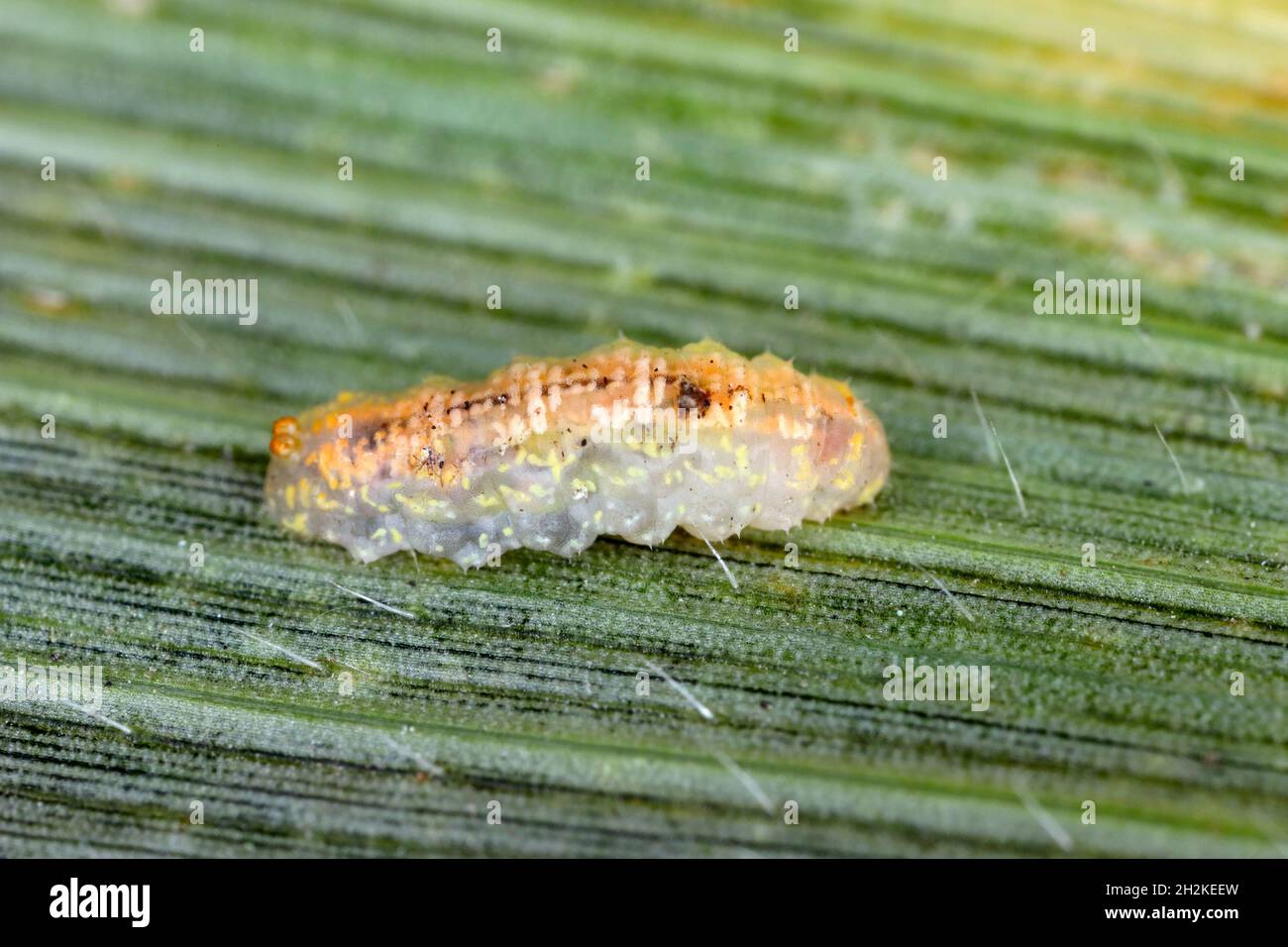 Hoverflies, also called flower flies or syrphid flies, make up the insect family Syrphidae - larva on a corn leaf. They are the natural enemy of aphid Stock Photohttps://www.alamy.com/image-license-details/?v=1https://www.alamy.com/hoverflies-also-called-flower-flies-or-syrphid-flies-make-up-the-insect-family-syrphidae-larva-on-a-corn-leaf-they-are-the-natural-enemy-of-aphid-image449127361.html
Hoverflies, also called flower flies or syrphid flies, make up the insect family Syrphidae - larva on a corn leaf. They are the natural enemy of aphid Stock Photohttps://www.alamy.com/image-license-details/?v=1https://www.alamy.com/hoverflies-also-called-flower-flies-or-syrphid-flies-make-up-the-insect-family-syrphidae-larva-on-a-corn-leaf-they-are-the-natural-enemy-of-aphid-image449127361.htmlRF2H2KEEW–Hoverflies, also called flower flies or syrphid flies, make up the insect family Syrphidae - larva on a corn leaf. They are the natural enemy of aphid
 . Report of the State Entomologist of Connecticut for the year .. . d. Adult moth. Natural size. b. Tip of ear of corn showing where a half-grown larva has eaten through the husk. Natural size. CORN EAR WORM. PLATE IX.. a. Eggs of common asparagus beetle as laid upon mature stems. Much enlarged. Stock Photohttps://www.alamy.com/image-license-details/?v=1https://www.alamy.com/report-of-the-state-entomologist-of-connecticut-for-the-year-d-adult-moth-natural-size-b-tip-of-ear-of-corn-showing-where-a-half-grown-larva-has-eaten-through-the-husk-natural-size-corn-ear-worm-plate-ix-a-eggs-of-common-asparagus-beetle-as-laid-upon-mature-stems-much-enlarged-image369997322.html
. Report of the State Entomologist of Connecticut for the year .. . d. Adult moth. Natural size. b. Tip of ear of corn showing where a half-grown larva has eaten through the husk. Natural size. CORN EAR WORM. PLATE IX.. a. Eggs of common asparagus beetle as laid upon mature stems. Much enlarged. Stock Photohttps://www.alamy.com/image-license-details/?v=1https://www.alamy.com/report-of-the-state-entomologist-of-connecticut-for-the-year-d-adult-moth-natural-size-b-tip-of-ear-of-corn-showing-where-a-half-grown-larva-has-eaten-through-the-husk-natural-size-corn-ear-worm-plate-ix-a-eggs-of-common-asparagus-beetle-as-laid-upon-mature-stems-much-enlarged-image369997322.htmlRM2CDXRA2–. Report of the State Entomologist of Connecticut for the year .. . d. Adult moth. Natural size. b. Tip of ear of corn showing where a half-grown larva has eaten through the husk. Natural size. CORN EAR WORM. PLATE IX.. a. Eggs of common asparagus beetle as laid upon mature stems. Much enlarged.
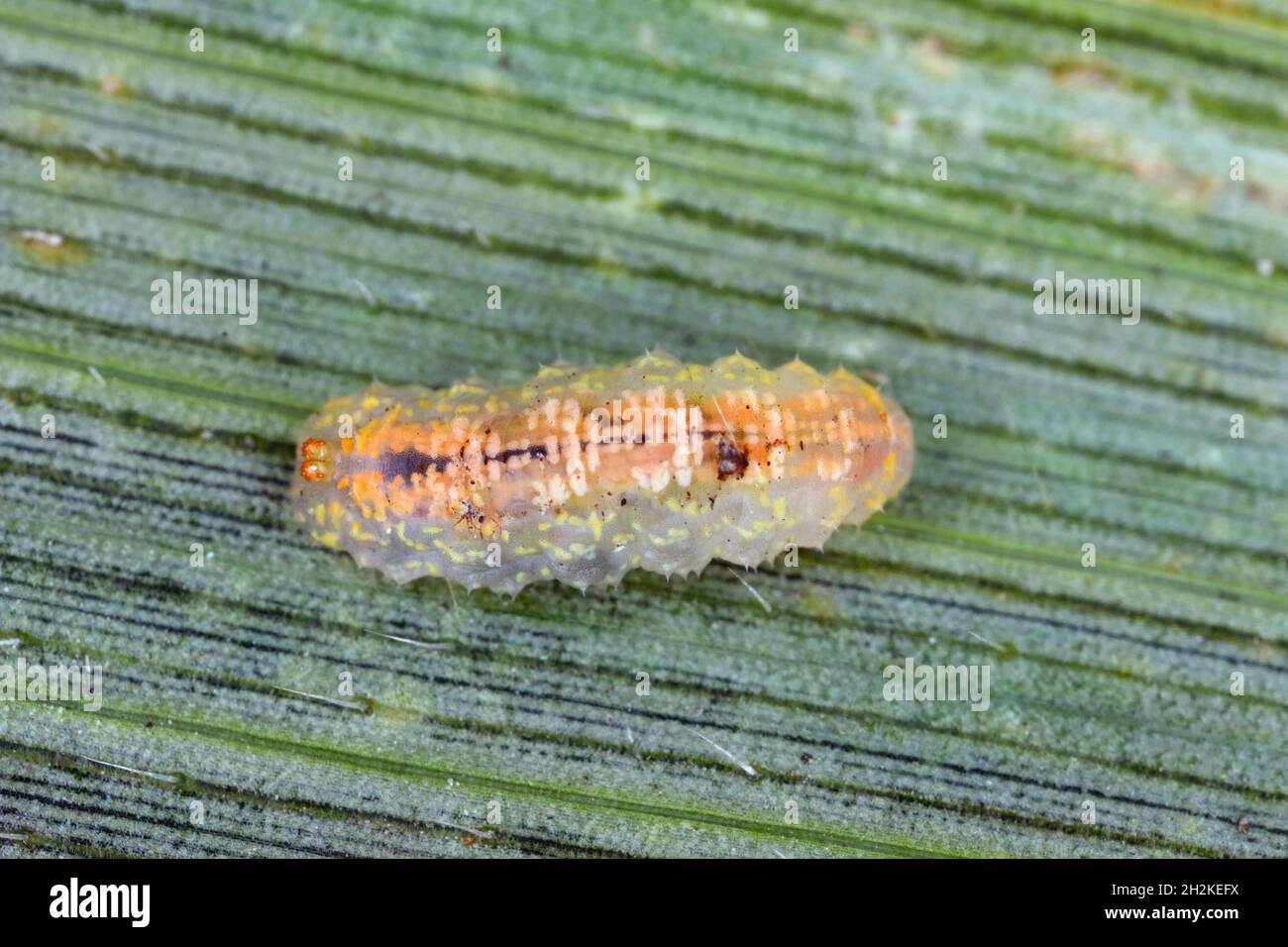 Hoverflies, also called flower flies or syrphid flies, make up the insect family Syrphidae - larva on a corn leaf. They are the natural enemy of aphid Stock Photohttps://www.alamy.com/image-license-details/?v=1https://www.alamy.com/hoverflies-also-called-flower-flies-or-syrphid-flies-make-up-the-insect-family-syrphidae-larva-on-a-corn-leaf-they-are-the-natural-enemy-of-aphid-image449127390.html
Hoverflies, also called flower flies or syrphid flies, make up the insect family Syrphidae - larva on a corn leaf. They are the natural enemy of aphid Stock Photohttps://www.alamy.com/image-license-details/?v=1https://www.alamy.com/hoverflies-also-called-flower-flies-or-syrphid-flies-make-up-the-insect-family-syrphidae-larva-on-a-corn-leaf-they-are-the-natural-enemy-of-aphid-image449127390.htmlRF2H2KEFX–Hoverflies, also called flower flies or syrphid flies, make up the insect family Syrphidae - larva on a corn leaf. They are the natural enemy of aphid
 . Report of the State Entomologist of Connecticut for the year .. . b. Quince leaves injured by resplendent shield bearer: insert at left showsmines; insert at right shows winter case of larva. Both greatly enlarged. LARKSPUR INJURED BY MITES; RESPLENDENT SHIELD BEARER. PLATE XV.. a. Injury to ear of corn by bumble flower beetle. Natural size. Stock Photohttps://www.alamy.com/image-license-details/?v=1https://www.alamy.com/report-of-the-state-entomologist-of-connecticut-for-the-year-b-quince-leaves-injured-by-resplendent-shield-bearer-insert-at-left-showsmines-insert-at-right-shows-winter-case-of-larva-both-greatly-enlarged-larkspur-injured-by-mites-resplendent-shield-bearer-plate-xv-a-injury-to-ear-of-corn-by-bumble-flower-beetle-natural-size-image369996259.html
. Report of the State Entomologist of Connecticut for the year .. . b. Quince leaves injured by resplendent shield bearer: insert at left showsmines; insert at right shows winter case of larva. Both greatly enlarged. LARKSPUR INJURED BY MITES; RESPLENDENT SHIELD BEARER. PLATE XV.. a. Injury to ear of corn by bumble flower beetle. Natural size. Stock Photohttps://www.alamy.com/image-license-details/?v=1https://www.alamy.com/report-of-the-state-entomologist-of-connecticut-for-the-year-b-quince-leaves-injured-by-resplendent-shield-bearer-insert-at-left-showsmines-insert-at-right-shows-winter-case-of-larva-both-greatly-enlarged-larkspur-injured-by-mites-resplendent-shield-bearer-plate-xv-a-injury-to-ear-of-corn-by-bumble-flower-beetle-natural-size-image369996259.htmlRM2CDXP03–. Report of the State Entomologist of Connecticut for the year .. . b. Quince leaves injured by resplendent shield bearer: insert at left showsmines; insert at right shows winter case of larva. Both greatly enlarged. LARKSPUR INJURED BY MITES; RESPLENDENT SHIELD BEARER. PLATE XV.. a. Injury to ear of corn by bumble flower beetle. Natural size.
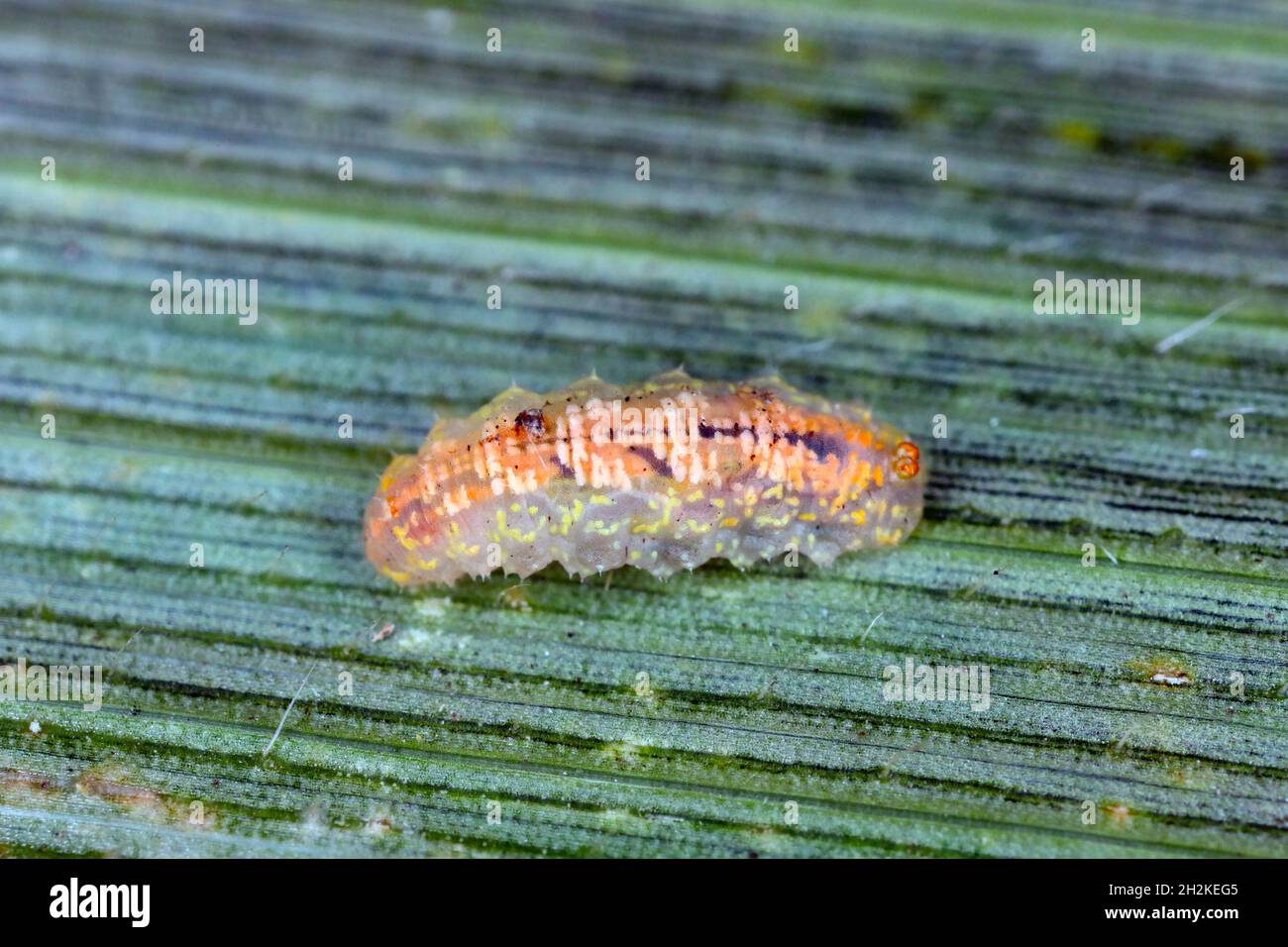 Hoverflies, also called flower flies or syrphid flies, make up the insect family Syrphidae - larva on a corn leaf. They are the natural enemy of aphid Stock Photohttps://www.alamy.com/image-license-details/?v=1https://www.alamy.com/hoverflies-also-called-flower-flies-or-syrphid-flies-make-up-the-insect-family-syrphidae-larva-on-a-corn-leaf-they-are-the-natural-enemy-of-aphid-image449127397.html
Hoverflies, also called flower flies or syrphid flies, make up the insect family Syrphidae - larva on a corn leaf. They are the natural enemy of aphid Stock Photohttps://www.alamy.com/image-license-details/?v=1https://www.alamy.com/hoverflies-also-called-flower-flies-or-syrphid-flies-make-up-the-insect-family-syrphidae-larva-on-a-corn-leaf-they-are-the-natural-enemy-of-aphid-image449127397.htmlRF2H2KEG5–Hoverflies, also called flower flies or syrphid flies, make up the insect family Syrphidae - larva on a corn leaf. They are the natural enemy of aphid
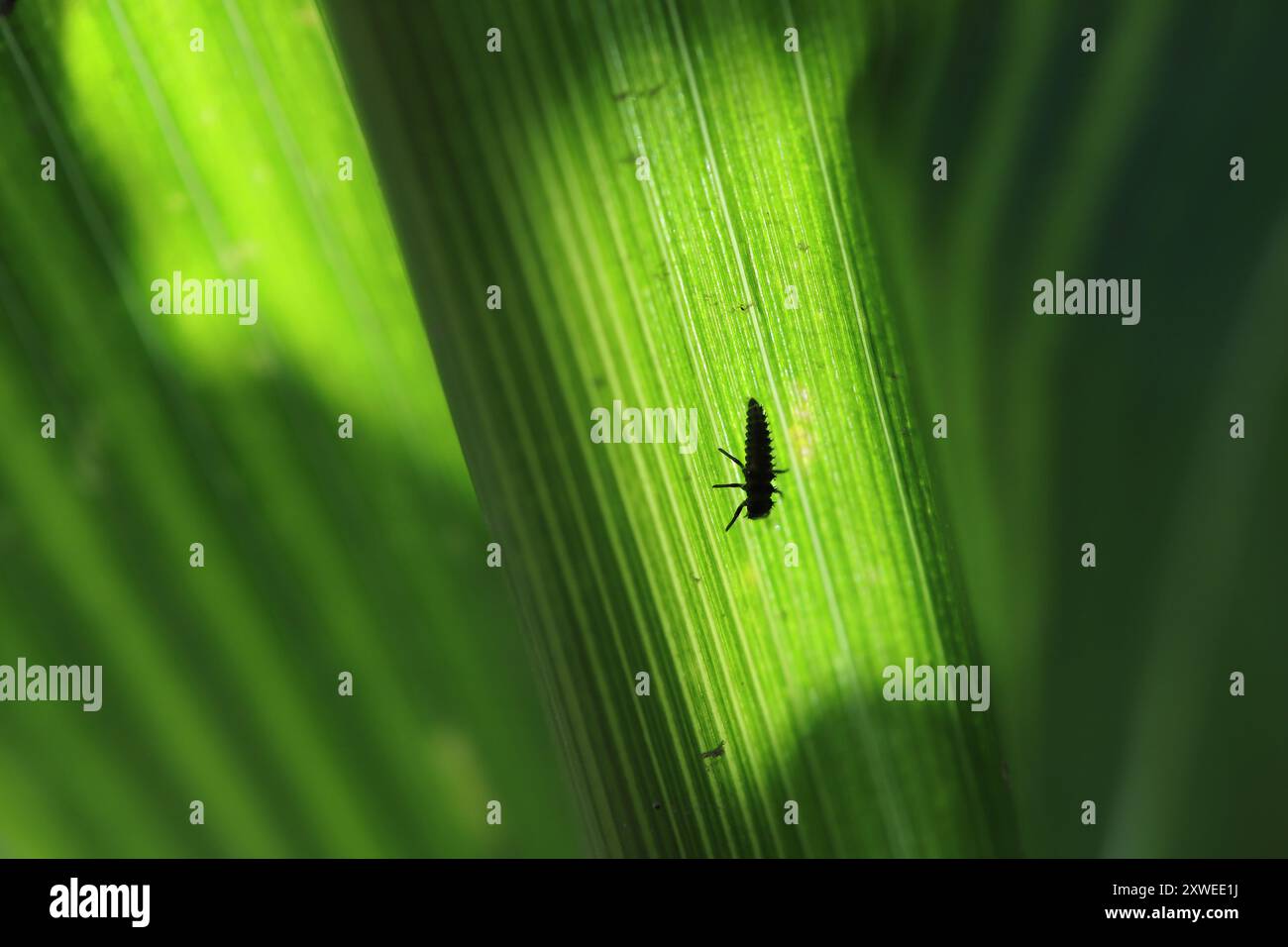 Ladybug larva on a corn leaf. Translucent through the leaf. Predator waiting for prey - aphids. Stock Photohttps://www.alamy.com/image-license-details/?v=1https://www.alamy.com/ladybug-larva-on-a-corn-leaf-translucent-through-the-leaf-predator-waiting-for-prey-aphids-image618047630.html
Ladybug larva on a corn leaf. Translucent through the leaf. Predator waiting for prey - aphids. Stock Photohttps://www.alamy.com/image-license-details/?v=1https://www.alamy.com/ladybug-larva-on-a-corn-leaf-translucent-through-the-leaf-predator-waiting-for-prey-aphids-image618047630.htmlRF2XWEE1J–Ladybug larva on a corn leaf. Translucent through the leaf. Predator waiting for prey - aphids.
![. Injurious insects and the use of insecticides [microform] : a new descriptive manual on noxious insects, with methods for their repression . Fig. 130.—Southern Corn Root-worm. !. Larva. 6. Pupa. c. Beetle. Magnified. (Garmaii.) THE STALK-BOEER. (Gorlyna nilela.) Also known as the Potato Stalk-borer. The larva; of this insectInfest a number of plants, among which are tomatoes, potatoes. Indiaiicorn, dahlias, asters, lilies, salvia, rhubarb, spinach, cocklebur, andthe twigs of theapple, peach, black-berry, and currant. The adult is abrown moth belong-ing to the group ofinsects to which thecut Stock Photo . Injurious insects and the use of insecticides [microform] : a new descriptive manual on noxious insects, with methods for their repression . Fig. 130.—Southern Corn Root-worm. !. Larva. 6. Pupa. c. Beetle. Magnified. (Garmaii.) THE STALK-BOEER. (Gorlyna nilela.) Also known as the Potato Stalk-borer. The larva; of this insectInfest a number of plants, among which are tomatoes, potatoes. Indiaiicorn, dahlias, asters, lilies, salvia, rhubarb, spinach, cocklebur, andthe twigs of theapple, peach, black-berry, and currant. The adult is abrown moth belong-ing to the group ofinsects to which thecut Stock Photo](https://c8.alamy.com/comp/2CH8YJM/injurious-insects-and-the-use-of-insecticides-microform-a-new-descriptive-manual-on-noxious-insects-with-methods-for-their-repression-fig-130southern-corn-root-worm-!-larva-6-pupa-c-beetle-magnified-garmaii-the-stalk-boeer-gorlyna-nilela-also-known-as-the-potato-stalk-borer-the-larva-of-this-insectinfest-a-number-of-plants-among-which-are-tomatoes-potatoes-indiaiicorn-dahlias-asters-lilies-salvia-rhubarb-spinach-cocklebur-andthe-twigs-of-theapple-peach-black-berry-and-currant-the-adult-is-abrown-moth-belong-ing-to-the-group-ofinsects-to-which-thecut-2CH8YJM.jpg) . Injurious insects and the use of insecticides [microform] : a new descriptive manual on noxious insects, with methods for their repression . Fig. 130.—Southern Corn Root-worm. !. Larva. 6. Pupa. c. Beetle. Magnified. (Garmaii.) THE STALK-BOEER. (Gorlyna nilela.) Also known as the Potato Stalk-borer. The larva; of this insectInfest a number of plants, among which are tomatoes, potatoes. Indiaiicorn, dahlias, asters, lilies, salvia, rhubarb, spinach, cocklebur, andthe twigs of theapple, peach, black-berry, and currant. The adult is abrown moth belong-ing to the group ofinsects to which thecut Stock Photohttps://www.alamy.com/image-license-details/?v=1https://www.alamy.com/injurious-insects-and-the-use-of-insecticides-microform-a-new-descriptive-manual-on-noxious-insects-with-methods-for-their-repression-fig-130southern-corn-root-worm-!-larva-6-pupa-c-beetle-magnified-garmaii-the-stalk-boeer-gorlyna-nilela-also-known-as-the-potato-stalk-borer-the-larva-of-this-insectinfest-a-number-of-plants-among-which-are-tomatoes-potatoes-indiaiicorn-dahlias-asters-lilies-salvia-rhubarb-spinach-cocklebur-andthe-twigs-of-theapple-peach-black-berry-and-currant-the-adult-is-abrown-moth-belong-ing-to-the-group-ofinsects-to-which-thecut-image372064188.html
. Injurious insects and the use of insecticides [microform] : a new descriptive manual on noxious insects, with methods for their repression . Fig. 130.—Southern Corn Root-worm. !. Larva. 6. Pupa. c. Beetle. Magnified. (Garmaii.) THE STALK-BOEER. (Gorlyna nilela.) Also known as the Potato Stalk-borer. The larva; of this insectInfest a number of plants, among which are tomatoes, potatoes. Indiaiicorn, dahlias, asters, lilies, salvia, rhubarb, spinach, cocklebur, andthe twigs of theapple, peach, black-berry, and currant. The adult is abrown moth belong-ing to the group ofinsects to which thecut Stock Photohttps://www.alamy.com/image-license-details/?v=1https://www.alamy.com/injurious-insects-and-the-use-of-insecticides-microform-a-new-descriptive-manual-on-noxious-insects-with-methods-for-their-repression-fig-130southern-corn-root-worm-!-larva-6-pupa-c-beetle-magnified-garmaii-the-stalk-boeer-gorlyna-nilela-also-known-as-the-potato-stalk-borer-the-larva-of-this-insectinfest-a-number-of-plants-among-which-are-tomatoes-potatoes-indiaiicorn-dahlias-asters-lilies-salvia-rhubarb-spinach-cocklebur-andthe-twigs-of-theapple-peach-black-berry-and-currant-the-adult-is-abrown-moth-belong-ing-to-the-group-ofinsects-to-which-thecut-image372064188.htmlRM2CH8YJM–. Injurious insects and the use of insecticides [microform] : a new descriptive manual on noxious insects, with methods for their repression . Fig. 130.—Southern Corn Root-worm. !. Larva. 6. Pupa. c. Beetle. Magnified. (Garmaii.) THE STALK-BOEER. (Gorlyna nilela.) Also known as the Potato Stalk-borer. The larva; of this insectInfest a number of plants, among which are tomatoes, potatoes. Indiaiicorn, dahlias, asters, lilies, salvia, rhubarb, spinach, cocklebur, andthe twigs of theapple, peach, black-berry, and currant. The adult is abrown moth belong-ing to the group ofinsects to which thecut
 The maize weevil or Greater rice weevil - Sitophilus zeamais. Is known of all the world as a pests stored grains of cereals, wheat, barley, rice, corn Stock Photohttps://www.alamy.com/image-license-details/?v=1https://www.alamy.com/the-maize-weevil-or-greater-rice-weevil-sitophilus-zeamais-is-known-of-all-the-world-as-a-pests-stored-grains-of-cereals-wheat-barley-rice-corn-image455786879.html
The maize weevil or Greater rice weevil - Sitophilus zeamais. Is known of all the world as a pests stored grains of cereals, wheat, barley, rice, corn Stock Photohttps://www.alamy.com/image-license-details/?v=1https://www.alamy.com/the-maize-weevil-or-greater-rice-weevil-sitophilus-zeamais-is-known-of-all-the-world-as-a-pests-stored-grains-of-cereals-wheat-barley-rice-corn-image455786879.htmlRF2HDETPR–The maize weevil or Greater rice weevil - Sitophilus zeamais. Is known of all the world as a pests stored grains of cereals, wheat, barley, rice, corn
 . Birds in their relations to man; a manual of economic ornithology for the United States and Canada . TIGER-BEETLE.Magnified. I From Trued Life.) 54 BIRDS IN THEIR RELATIONS TO MAN.. CLICK-BEETLE AND LARVA.{After Bruner.) family is the Colorado potato-beetle, but there are manyothers, such as the corn-root worm, the various flea-beetles,the striped cucumber-beetle, and the asparagus-beetle, whichare almost equally injurious. The larva? of this group vary much in appearance and life-history :some live exposed on leaves, othersare leaf-miners, and others live onroots and under ground. Most of t Stock Photohttps://www.alamy.com/image-license-details/?v=1https://www.alamy.com/birds-in-their-relations-to-man-a-manual-of-economic-ornithology-for-the-united-states-and-canada-tiger-beetlemagnified-i-from-trued-life-54-birds-in-their-relations-to-man-click-beetle-and-larvaafter-bruner-family-is-the-colorado-potato-beetle-but-there-are-manyothers-such-as-the-corn-root-worm-the-various-flea-beetlesthe-striped-cucumber-beetle-and-the-asparagus-beetle-whichare-almost-equally-injurious-the-larva-of-this-group-vary-much-in-appearance-and-life-history-some-live-exposed-on-leaves-othersare-leaf-miners-and-others-live-onroots-and-under-ground-most-of-t-image374980081.html
. Birds in their relations to man; a manual of economic ornithology for the United States and Canada . TIGER-BEETLE.Magnified. I From Trued Life.) 54 BIRDS IN THEIR RELATIONS TO MAN.. CLICK-BEETLE AND LARVA.{After Bruner.) family is the Colorado potato-beetle, but there are manyothers, such as the corn-root worm, the various flea-beetles,the striped cucumber-beetle, and the asparagus-beetle, whichare almost equally injurious. The larva? of this group vary much in appearance and life-history :some live exposed on leaves, othersare leaf-miners, and others live onroots and under ground. Most of t Stock Photohttps://www.alamy.com/image-license-details/?v=1https://www.alamy.com/birds-in-their-relations-to-man-a-manual-of-economic-ornithology-for-the-united-states-and-canada-tiger-beetlemagnified-i-from-trued-life-54-birds-in-their-relations-to-man-click-beetle-and-larvaafter-bruner-family-is-the-colorado-potato-beetle-but-there-are-manyothers-such-as-the-corn-root-worm-the-various-flea-beetlesthe-striped-cucumber-beetle-and-the-asparagus-beetle-whichare-almost-equally-injurious-the-larva-of-this-group-vary-much-in-appearance-and-life-history-some-live-exposed-on-leaves-othersare-leaf-miners-and-others-live-onroots-and-under-ground-most-of-t-image374980081.htmlRM2CP1PWN–. Birds in their relations to man; a manual of economic ornithology for the United States and Canada . TIGER-BEETLE.Magnified. I From Trued Life.) 54 BIRDS IN THEIR RELATIONS TO MAN.. CLICK-BEETLE AND LARVA.{After Bruner.) family is the Colorado potato-beetle, but there are manyothers, such as the corn-root worm, the various flea-beetles,the striped cucumber-beetle, and the asparagus-beetle, whichare almost equally injurious. The larva? of this group vary much in appearance and life-history :some live exposed on leaves, othersare leaf-miners, and others live onroots and under ground. Most of t
 . Insect pests of farm, garden and orchard . pa; c, larva—all enlarged; d, antenna of larva—still moreenlarged; d, the red or square-necked grain beetle {Cathartus gemellatusDuv.) (After Chittenden, U. S. Dept. Agr.) injurious to seed-corn. It feeds mostly out of doors, thoughsometimes infesting the granary. The Foreign Grain-beetle f is of much the same generalappearance, but smaller and of a more robust appearance Itfeeds upon a great variety of stored products as well as grain,but rarely becomes troublesome. The Cadelle % also has the bad habit of first attacking theembryo or germ of the ke Stock Photohttps://www.alamy.com/image-license-details/?v=1https://www.alamy.com/insect-pests-of-farm-garden-and-orchard-pa-c-larvaall-enlarged-d-antenna-of-larvastill-moreenlarged-d-the-red-or-square-necked-grain-beetle-cathartus-gemellatusduv-after-chittenden-u-s-dept-agr-injurious-to-seed-corn-it-feeds-mostly-out-of-doors-thoughsometimes-infesting-the-granary-the-foreign-grain-beetle-f-is-of-much-the-same-generalappearance-but-smaller-and-of-a-more-robust-appearance-itfeeds-upon-a-great-variety-of-stored-products-as-well-as-grainbut-rarely-becomes-troublesome-the-cadelle-also-has-the-bad-habit-of-first-attacking-theembryo-or-germ-of-the-ke-image369668147.html
. Insect pests of farm, garden and orchard . pa; c, larva—all enlarged; d, antenna of larva—still moreenlarged; d, the red or square-necked grain beetle {Cathartus gemellatusDuv.) (After Chittenden, U. S. Dept. Agr.) injurious to seed-corn. It feeds mostly out of doors, thoughsometimes infesting the granary. The Foreign Grain-beetle f is of much the same generalappearance, but smaller and of a more robust appearance Itfeeds upon a great variety of stored products as well as grain,but rarely becomes troublesome. The Cadelle % also has the bad habit of first attacking theembryo or germ of the ke Stock Photohttps://www.alamy.com/image-license-details/?v=1https://www.alamy.com/insect-pests-of-farm-garden-and-orchard-pa-c-larvaall-enlarged-d-antenna-of-larvastill-moreenlarged-d-the-red-or-square-necked-grain-beetle-cathartus-gemellatusduv-after-chittenden-u-s-dept-agr-injurious-to-seed-corn-it-feeds-mostly-out-of-doors-thoughsometimes-infesting-the-granary-the-foreign-grain-beetle-f-is-of-much-the-same-generalappearance-but-smaller-and-of-a-more-robust-appearance-itfeeds-upon-a-great-variety-of-stored-products-as-well-as-grainbut-rarely-becomes-troublesome-the-cadelle-also-has-the-bad-habit-of-first-attacking-theembryo-or-germ-of-the-ke-image369668147.htmlRM2CDBRDR–. Insect pests of farm, garden and orchard . pa; c, larva—all enlarged; d, antenna of larva—still moreenlarged; d, the red or square-necked grain beetle {Cathartus gemellatusDuv.) (After Chittenden, U. S. Dept. Agr.) injurious to seed-corn. It feeds mostly out of doors, thoughsometimes infesting the granary. The Foreign Grain-beetle f is of much the same generalappearance, but smaller and of a more robust appearance Itfeeds upon a great variety of stored products as well as grain,but rarely becomes troublesome. The Cadelle % also has the bad habit of first attacking theembryo or germ of the ke
 . Bulletin : report of Agricultural Experiment Station, Agricultural and Mechanical College, Auburn, Ala. Agriculture -- Alabama. Fig. 15. Corn Sap-Beetle. Larva and adult, enlarged.. Please note that these images are extracted from scanned page images that may have been digitally enhanced for readability - coloration and appearance of these illustrations may not perfectly resemble the original work.. Agricultural and Mechanical College of Alabama. Agricultural Experiment Station. Auburn, Ala. : The Station Stock Photohttps://www.alamy.com/image-license-details/?v=1https://www.alamy.com/bulletin-report-of-agricultural-experiment-station-agricultural-and-mechanical-college-auburn-ala-agriculture-alabama-fig-15-corn-sap-beetle-larva-and-adult-enlarged-please-note-that-these-images-are-extracted-from-scanned-page-images-that-may-have-been-digitally-enhanced-for-readability-coloration-and-appearance-of-these-illustrations-may-not-perfectly-resemble-the-original-work-agricultural-and-mechanical-college-of-alabama-agricultural-experiment-station-auburn-ala-the-station-image233782553.html
. Bulletin : report of Agricultural Experiment Station, Agricultural and Mechanical College, Auburn, Ala. Agriculture -- Alabama. Fig. 15. Corn Sap-Beetle. Larva and adult, enlarged.. Please note that these images are extracted from scanned page images that may have been digitally enhanced for readability - coloration and appearance of these illustrations may not perfectly resemble the original work.. Agricultural and Mechanical College of Alabama. Agricultural Experiment Station. Auburn, Ala. : The Station Stock Photohttps://www.alamy.com/image-license-details/?v=1https://www.alamy.com/bulletin-report-of-agricultural-experiment-station-agricultural-and-mechanical-college-auburn-ala-agriculture-alabama-fig-15-corn-sap-beetle-larva-and-adult-enlarged-please-note-that-these-images-are-extracted-from-scanned-page-images-that-may-have-been-digitally-enhanced-for-readability-coloration-and-appearance-of-these-illustrations-may-not-perfectly-resemble-the-original-work-agricultural-and-mechanical-college-of-alabama-agricultural-experiment-station-auburn-ala-the-station-image233782553.htmlRMRG9M0W–. Bulletin : report of Agricultural Experiment Station, Agricultural and Mechanical College, Auburn, Ala. Agriculture -- Alabama. Fig. 15. Corn Sap-Beetle. Larva and adult, enlarged.. Please note that these images are extracted from scanned page images that may have been digitally enhanced for readability - coloration and appearance of these illustrations may not perfectly resemble the original work.. Agricultural and Mechanical College of Alabama. Agricultural Experiment Station. Auburn, Ala. : The Station
 . The transformations (or metamorphoses) of insects. Insects; Insects; Myriapoda; Arachnida; Crustacea. THE CALANDRA PALMARUM. 121. THE METAMORPHOSES OF Calafidrapahimruiii. The beetle is seen on the wood of the pahn, and its beak is a very prominent part of its structure; the larva is gnawing the wood, and there is a large cocoon in a cavity below. beetle, about one-eighth of an inch in length, and is of a pitchy red colour. The female deposits her eggs upon the corn after V. Please note that these images are extracted from scanned page images that may have been digitally enhanced for readabi Stock Photohttps://www.alamy.com/image-license-details/?v=1https://www.alamy.com/the-transformations-or-metamorphoses-of-insects-insects-insects-myriapoda-arachnida-crustacea-the-calandra-palmarum-121-the-metamorphoses-of-calafidrapahimruiii-the-beetle-is-seen-on-the-wood-of-the-pahn-and-its-beak-is-a-very-prominent-part-of-its-structure-the-larva-is-gnawing-the-wood-and-there-is-a-large-cocoon-in-a-cavity-below-beetle-about-one-eighth-of-an-inch-in-length-and-is-of-a-pitchy-red-colour-the-female-deposits-her-eggs-upon-the-corn-after-v-please-note-that-these-images-are-extracted-from-scanned-page-images-that-may-have-been-digitally-enhanced-for-readabi-image237914908.html
. The transformations (or metamorphoses) of insects. Insects; Insects; Myriapoda; Arachnida; Crustacea. THE CALANDRA PALMARUM. 121. THE METAMORPHOSES OF Calafidrapahimruiii. The beetle is seen on the wood of the pahn, and its beak is a very prominent part of its structure; the larva is gnawing the wood, and there is a large cocoon in a cavity below. beetle, about one-eighth of an inch in length, and is of a pitchy red colour. The female deposits her eggs upon the corn after V. Please note that these images are extracted from scanned page images that may have been digitally enhanced for readabi Stock Photohttps://www.alamy.com/image-license-details/?v=1https://www.alamy.com/the-transformations-or-metamorphoses-of-insects-insects-insects-myriapoda-arachnida-crustacea-the-calandra-palmarum-121-the-metamorphoses-of-calafidrapahimruiii-the-beetle-is-seen-on-the-wood-of-the-pahn-and-its-beak-is-a-very-prominent-part-of-its-structure-the-larva-is-gnawing-the-wood-and-there-is-a-large-cocoon-in-a-cavity-below-beetle-about-one-eighth-of-an-inch-in-length-and-is-of-a-pitchy-red-colour-the-female-deposits-her-eggs-upon-the-corn-after-v-please-note-that-these-images-are-extracted-from-scanned-page-images-that-may-have-been-digitally-enhanced-for-readabi-image237914908.htmlRMRR1XW0–. The transformations (or metamorphoses) of insects. Insects; Insects; Myriapoda; Arachnida; Crustacea. THE CALANDRA PALMARUM. 121. THE METAMORPHOSES OF Calafidrapahimruiii. The beetle is seen on the wood of the pahn, and its beak is a very prominent part of its structure; the larva is gnawing the wood, and there is a large cocoon in a cavity below. beetle, about one-eighth of an inch in length, and is of a pitchy red colour. The female deposits her eggs upon the corn after V. Please note that these images are extracted from scanned page images that may have been digitally enhanced for readabi
![. Corn; growing, judging, breeding, feeding, marketing;. Corn. PLATE III. Tlic Wliiie Grub; the beetle, egg, larva and pupa; enlarged two and one-half diameters. C0URTE8T OF PRaFESSOR S. A. FORBES. ILUtNOIS STATE ENTOMOLOGIST.. Please note that these images are extracted from scanned page images that may have been digitally enhanced for readability - coloration and appearance of these illustrations may not perfectly resemble the original work.. Bowman, Melville Le Roy, 1881- [from old catalog]. Waterloo, Iowa, Sold by Waterloo publishing co. Stock Photo . Corn; growing, judging, breeding, feeding, marketing;. Corn. PLATE III. Tlic Wliiie Grub; the beetle, egg, larva and pupa; enlarged two and one-half diameters. C0URTE8T OF PRaFESSOR S. A. FORBES. ILUtNOIS STATE ENTOMOLOGIST.. Please note that these images are extracted from scanned page images that may have been digitally enhanced for readability - coloration and appearance of these illustrations may not perfectly resemble the original work.. Bowman, Melville Le Roy, 1881- [from old catalog]. Waterloo, Iowa, Sold by Waterloo publishing co. Stock Photo](https://c8.alamy.com/comp/RE87NJ/corn-growing-judging-breeding-feeding-marketing-corn-plate-iii-tlic-wliiie-grub-the-beetle-egg-larva-and-pupa-enlarged-two-and-one-half-diameters-c0urte8t-of-prafessor-s-a-forbes-ilutnois-state-entomologist-please-note-that-these-images-are-extracted-from-scanned-page-images-that-may-have-been-digitally-enhanced-for-readability-coloration-and-appearance-of-these-illustrations-may-not-perfectly-resemble-the-original-work-bowman-melville-le-roy-1881-from-old-catalog-waterloo-iowa-sold-by-waterloo-publishing-co-RE87NJ.jpg) . Corn; growing, judging, breeding, feeding, marketing;. Corn. PLATE III. Tlic Wliiie Grub; the beetle, egg, larva and pupa; enlarged two and one-half diameters. C0URTE8T OF PRaFESSOR S. A. FORBES. ILUtNOIS STATE ENTOMOLOGIST.. Please note that these images are extracted from scanned page images that may have been digitally enhanced for readability - coloration and appearance of these illustrations may not perfectly resemble the original work.. Bowman, Melville Le Roy, 1881- [from old catalog]. Waterloo, Iowa, Sold by Waterloo publishing co. Stock Photohttps://www.alamy.com/image-license-details/?v=1https://www.alamy.com/corn-growing-judging-breeding-feeding-marketing-corn-plate-iii-tlic-wliiie-grub-the-beetle-egg-larva-and-pupa-enlarged-two-and-one-half-diameters-c0urte8t-of-prafessor-s-a-forbes-ilutnois-state-entomologist-please-note-that-these-images-are-extracted-from-scanned-page-images-that-may-have-been-digitally-enhanced-for-readability-coloration-and-appearance-of-these-illustrations-may-not-perfectly-resemble-the-original-work-bowman-melville-le-roy-1881-from-old-catalog-waterloo-iowa-sold-by-waterloo-publishing-co-image232521678.html
. Corn; growing, judging, breeding, feeding, marketing;. Corn. PLATE III. Tlic Wliiie Grub; the beetle, egg, larva and pupa; enlarged two and one-half diameters. C0URTE8T OF PRaFESSOR S. A. FORBES. ILUtNOIS STATE ENTOMOLOGIST.. Please note that these images are extracted from scanned page images that may have been digitally enhanced for readability - coloration and appearance of these illustrations may not perfectly resemble the original work.. Bowman, Melville Le Roy, 1881- [from old catalog]. Waterloo, Iowa, Sold by Waterloo publishing co. Stock Photohttps://www.alamy.com/image-license-details/?v=1https://www.alamy.com/corn-growing-judging-breeding-feeding-marketing-corn-plate-iii-tlic-wliiie-grub-the-beetle-egg-larva-and-pupa-enlarged-two-and-one-half-diameters-c0urte8t-of-prafessor-s-a-forbes-ilutnois-state-entomologist-please-note-that-these-images-are-extracted-from-scanned-page-images-that-may-have-been-digitally-enhanced-for-readability-coloration-and-appearance-of-these-illustrations-may-not-perfectly-resemble-the-original-work-bowman-melville-le-roy-1881-from-old-catalog-waterloo-iowa-sold-by-waterloo-publishing-co-image232521678.htmlRMRE87NJ–. Corn; growing, judging, breeding, feeding, marketing;. Corn. PLATE III. Tlic Wliiie Grub; the beetle, egg, larva and pupa; enlarged two and one-half diameters. C0URTE8T OF PRaFESSOR S. A. FORBES. ILUtNOIS STATE ENTOMOLOGIST.. Please note that these images are extracted from scanned page images that may have been digitally enhanced for readability - coloration and appearance of these illustrations may not perfectly resemble the original work.. Bowman, Melville Le Roy, 1881- [from old catalog]. Waterloo, Iowa, Sold by Waterloo publishing co.
 . Elementary entomology. Entomology. 156 ELEMENTARY ENTOMOLOGY. Fig. 223. Striped cucumber-beetle Striped cucumber-beetle {Diahrotica vittatd) is about the same size, bright yellow with black stripes, and is one of the worst pests of young cucumber and melon vines. The larvae are long, slender whitish grubs which feed on the roots. The twelve-spotted Diabrotica is green with twelve black spots, with similar food habits in the adult stage, but in the South the larvae do serious injury to the roots of corn, while the larva of another pale green species,. Please note that these images are extract Stock Photohttps://www.alamy.com/image-license-details/?v=1https://www.alamy.com/elementary-entomology-entomology-156-elementary-entomology-fig-223-striped-cucumber-beetle-striped-cucumber-beetle-diahrotica-vittatd-is-about-the-same-size-bright-yellow-with-black-stripes-and-is-one-of-the-worst-pests-of-young-cucumber-and-melon-vines-the-larvae-are-long-slender-whitish-grubs-which-feed-on-the-roots-the-twelve-spotted-diabrotica-is-green-with-twelve-black-spots-with-similar-food-habits-in-the-adult-stage-but-in-the-south-the-larvae-do-serious-injury-to-the-roots-of-corn-while-the-larva-of-another-pale-green-species-please-note-that-these-images-are-extract-image231808185.html
. Elementary entomology. Entomology. 156 ELEMENTARY ENTOMOLOGY. Fig. 223. Striped cucumber-beetle Striped cucumber-beetle {Diahrotica vittatd) is about the same size, bright yellow with black stripes, and is one of the worst pests of young cucumber and melon vines. The larvae are long, slender whitish grubs which feed on the roots. The twelve-spotted Diabrotica is green with twelve black spots, with similar food habits in the adult stage, but in the South the larvae do serious injury to the roots of corn, while the larva of another pale green species,. Please note that these images are extract Stock Photohttps://www.alamy.com/image-license-details/?v=1https://www.alamy.com/elementary-entomology-entomology-156-elementary-entomology-fig-223-striped-cucumber-beetle-striped-cucumber-beetle-diahrotica-vittatd-is-about-the-same-size-bright-yellow-with-black-stripes-and-is-one-of-the-worst-pests-of-young-cucumber-and-melon-vines-the-larvae-are-long-slender-whitish-grubs-which-feed-on-the-roots-the-twelve-spotted-diabrotica-is-green-with-twelve-black-spots-with-similar-food-habits-in-the-adult-stage-but-in-the-south-the-larvae-do-serious-injury-to-the-roots-of-corn-while-the-larva-of-another-pale-green-species-please-note-that-these-images-are-extract-image231808185.htmlRMRD3NKN–. Elementary entomology. Entomology. 156 ELEMENTARY ENTOMOLOGY. Fig. 223. Striped cucumber-beetle Striped cucumber-beetle {Diahrotica vittatd) is about the same size, bright yellow with black stripes, and is one of the worst pests of young cucumber and melon vines. The larvae are long, slender whitish grubs which feed on the roots. The twelve-spotted Diabrotica is green with twelve black spots, with similar food habits in the adult stage, but in the South the larvae do serious injury to the roots of corn, while the larva of another pale green species,. Please note that these images are extract
 . Bulletin. Insects; Insect pests; Entomology; Insects; Insect pests; Entomology. 14 feeding- on the roots of timothy and other g^rasses, and Indian corn, in addition to clover, strawberry, and grape, which Avould lead to the belief that the species might haye been originally a grass-feeding one. There is little doubt that the insect is single-brooded, and it has been surmised that it hibernates as a partly grown larva. The beetles which arc to be found from June to September probably also hibernate. THE BEET TORTOISE BEETLE.. Fig. G.—Cas^idd ncbidotia: beetle, about 4 times natural size (orig Stock Photohttps://www.alamy.com/image-license-details/?v=1https://www.alamy.com/bulletin-insects-insect-pests-entomology-insects-insect-pests-entomology-14-feeding-on-the-roots-of-timothy-and-other-grasses-and-indian-corn-in-addition-to-clover-strawberry-and-grape-which-avould-lead-to-the-belief-that-the-species-might-haye-been-originally-a-grass-feeding-one-there-is-little-doubt-that-the-insect-is-single-brooded-and-it-has-been-surmised-that-it-hibernates-as-a-partly-grown-larva-the-beetles-which-arc-to-be-found-from-june-to-september-probably-also-hibernate-the-beet-tortoise-beetle-fig-gcasidd-ncbidotia-beetle-about-4-times-natural-size-orig-image234119125.html
. Bulletin. Insects; Insect pests; Entomology; Insects; Insect pests; Entomology. 14 feeding- on the roots of timothy and other g^rasses, and Indian corn, in addition to clover, strawberry, and grape, which Avould lead to the belief that the species might haye been originally a grass-feeding one. There is little doubt that the insect is single-brooded, and it has been surmised that it hibernates as a partly grown larva. The beetles which arc to be found from June to September probably also hibernate. THE BEET TORTOISE BEETLE.. Fig. G.—Cas^idd ncbidotia: beetle, about 4 times natural size (orig Stock Photohttps://www.alamy.com/image-license-details/?v=1https://www.alamy.com/bulletin-insects-insect-pests-entomology-insects-insect-pests-entomology-14-feeding-on-the-roots-of-timothy-and-other-grasses-and-indian-corn-in-addition-to-clover-strawberry-and-grape-which-avould-lead-to-the-belief-that-the-species-might-haye-been-originally-a-grass-feeding-one-there-is-little-doubt-that-the-insect-is-single-brooded-and-it-has-been-surmised-that-it-hibernates-as-a-partly-grown-larva-the-beetles-which-arc-to-be-found-from-june-to-september-probably-also-hibernate-the-beet-tortoise-beetle-fig-gcasidd-ncbidotia-beetle-about-4-times-natural-size-orig-image234119125.htmlRMRGW199–. Bulletin. Insects; Insect pests; Entomology; Insects; Insect pests; Entomology. 14 feeding- on the roots of timothy and other g^rasses, and Indian corn, in addition to clover, strawberry, and grape, which Avould lead to the belief that the species might haye been originally a grass-feeding one. There is little doubt that the insect is single-brooded, and it has been surmised that it hibernates as a partly grown larva. The beetles which arc to be found from June to September probably also hibernate. THE BEET TORTOISE BEETLE.. Fig. G.—Cas^idd ncbidotia: beetle, about 4 times natural size (orig
 . Corn; growing, judging, breeding, feeding, marketing; for the farmer, student and teacher of agriculture, a textbook for agricultural colleges and high shcools. Corn. PLATE 111. The White Cinib; the beetle, egg, larva and pupa; enlarged two and one-half diameters. COUHTEST OF PflOpeSSOH 9. A. FORSeS. ILLINOIS STATE El. Please note that these images are extracted from scanned page images that may have been digitally enhanced for readability - coloration and appearance of these illustrations may not perfectly resemble the original work.. Bowman, Melville Le Roy, 1881-. Waterloo, Ia. , Sold by Stock Photohttps://www.alamy.com/image-license-details/?v=1https://www.alamy.com/corn-growing-judging-breeding-feeding-marketing-for-the-farmer-student-and-teacher-of-agriculture-a-textbook-for-agricultural-colleges-and-high-shcools-corn-plate-111-the-white-cinib-the-beetle-egg-larva-and-pupa-enlarged-two-and-one-half-diameters-couhtest-of-pflopessoh-9-a-forses-illinois-state-el-please-note-that-these-images-are-extracted-from-scanned-page-images-that-may-have-been-digitally-enhanced-for-readability-coloration-and-appearance-of-these-illustrations-may-not-perfectly-resemble-the-original-work-bowman-melville-le-roy-1881-waterloo-ia-sold-by-image232425126.html
. Corn; growing, judging, breeding, feeding, marketing; for the farmer, student and teacher of agriculture, a textbook for agricultural colleges and high shcools. Corn. PLATE 111. The White Cinib; the beetle, egg, larva and pupa; enlarged two and one-half diameters. COUHTEST OF PflOpeSSOH 9. A. FORSeS. ILLINOIS STATE El. Please note that these images are extracted from scanned page images that may have been digitally enhanced for readability - coloration and appearance of these illustrations may not perfectly resemble the original work.. Bowman, Melville Le Roy, 1881-. Waterloo, Ia. , Sold by Stock Photohttps://www.alamy.com/image-license-details/?v=1https://www.alamy.com/corn-growing-judging-breeding-feeding-marketing-for-the-farmer-student-and-teacher-of-agriculture-a-textbook-for-agricultural-colleges-and-high-shcools-corn-plate-111-the-white-cinib-the-beetle-egg-larva-and-pupa-enlarged-two-and-one-half-diameters-couhtest-of-pflopessoh-9-a-forses-illinois-state-el-please-note-that-these-images-are-extracted-from-scanned-page-images-that-may-have-been-digitally-enhanced-for-readability-coloration-and-appearance-of-these-illustrations-may-not-perfectly-resemble-the-original-work-bowman-melville-le-roy-1881-waterloo-ia-sold-by-image232425126.htmlRMRE3THA–. Corn; growing, judging, breeding, feeding, marketing; for the farmer, student and teacher of agriculture, a textbook for agricultural colleges and high shcools. Corn. PLATE 111. The White Cinib; the beetle, egg, larva and pupa; enlarged two and one-half diameters. COUHTEST OF PflOpeSSOH 9. A. FORSeS. ILLINOIS STATE El. Please note that these images are extracted from scanned page images that may have been digitally enhanced for readability - coloration and appearance of these illustrations may not perfectly resemble the original work.. Bowman, Melville Le Roy, 1881-. Waterloo, Ia. , Sold by
 . Bulletin. Agriculture -- Ontario. 30 Corn-Ear Worm : Sometimes found feeding on the fruit of tomato. (For description of larva, see insects affecting corn.) Flea-Beetles (Epitrix cucumeris) : This is the same flea-beetle that causes injury to the potato, ft riddles the leaves of the tomato with little holes, and injures the function of the leaf. For further description of this pest and treatment, see insects affect- ing the potato. (Fungi.) Black Rot (Macrosporium tomato) : This fungus produces roundish, black velvety areas on the fruit of the tomato. The spores are many-celled, and sooty-co Stock Photohttps://www.alamy.com/image-license-details/?v=1https://www.alamy.com/bulletin-agriculture-ontario-30-corn-ear-worm-sometimes-found-feeding-on-the-fruit-of-tomato-for-description-of-larva-see-insects-affecting-corn-flea-beetles-epitrix-cucumeris-this-is-the-same-flea-beetle-that-causes-injury-to-the-potato-ft-riddles-the-leaves-of-the-tomato-with-little-holes-and-injures-the-function-of-the-leaf-for-further-description-of-this-pest-and-treatment-see-insects-affect-ing-the-potato-fungi-black-rot-macrosporium-tomato-this-fungus-produces-roundish-black-velvety-areas-on-the-fruit-of-the-tomato-the-spores-are-many-celled-and-sooty-co-image234206569.html
. Bulletin. Agriculture -- Ontario. 30 Corn-Ear Worm : Sometimes found feeding on the fruit of tomato. (For description of larva, see insects affecting corn.) Flea-Beetles (Epitrix cucumeris) : This is the same flea-beetle that causes injury to the potato, ft riddles the leaves of the tomato with little holes, and injures the function of the leaf. For further description of this pest and treatment, see insects affect- ing the potato. (Fungi.) Black Rot (Macrosporium tomato) : This fungus produces roundish, black velvety areas on the fruit of the tomato. The spores are many-celled, and sooty-co Stock Photohttps://www.alamy.com/image-license-details/?v=1https://www.alamy.com/bulletin-agriculture-ontario-30-corn-ear-worm-sometimes-found-feeding-on-the-fruit-of-tomato-for-description-of-larva-see-insects-affecting-corn-flea-beetles-epitrix-cucumeris-this-is-the-same-flea-beetle-that-causes-injury-to-the-potato-ft-riddles-the-leaves-of-the-tomato-with-little-holes-and-injures-the-function-of-the-leaf-for-further-description-of-this-pest-and-treatment-see-insects-affect-ing-the-potato-fungi-black-rot-macrosporium-tomato-this-fungus-produces-roundish-black-velvety-areas-on-the-fruit-of-the-tomato-the-spores-are-many-celled-and-sooty-co-image234206569.htmlRMRH10T9–. Bulletin. Agriculture -- Ontario. 30 Corn-Ear Worm : Sometimes found feeding on the fruit of tomato. (For description of larva, see insects affecting corn.) Flea-Beetles (Epitrix cucumeris) : This is the same flea-beetle that causes injury to the potato, ft riddles the leaves of the tomato with little holes, and injures the function of the leaf. For further description of this pest and treatment, see insects affect- ing the potato. (Fungi.) Black Rot (Macrosporium tomato) : This fungus produces roundish, black velvety areas on the fruit of the tomato. The spores are many-celled, and sooty-co
![. Elementary entomology. Insects. FIG. 254. The granary weevil (Calandra granaria]. (Enlarged) rt, beetle ; l>, larva; c, pupa; d, the adult rice weevil (Calandra otyza}. (After Chittenden, United States Department of Agriculture) sculptured. They attack corn, timothy, and other grasses, particu- larly the coarse swamp grasses and sedges. The fat white larvae. Please note that these images are extracted from scanned page images that may have been digitally enhanced for readability - coloration and appearance of these illustrations may not perfectly resemble the original work.. Sanderson, Dw Stock Photo . Elementary entomology. Insects. FIG. 254. The granary weevil (Calandra granaria]. (Enlarged) rt, beetle ; l>, larva; c, pupa; d, the adult rice weevil (Calandra otyza}. (After Chittenden, United States Department of Agriculture) sculptured. They attack corn, timothy, and other grasses, particu- larly the coarse swamp grasses and sedges. The fat white larvae. Please note that these images are extracted from scanned page images that may have been digitally enhanced for readability - coloration and appearance of these illustrations may not perfectly resemble the original work.. Sanderson, Dw Stock Photo](https://c8.alamy.com/comp/RD2CE7/elementary-entomology-insects-fig-254-the-granary-weevil-calandra-granaria-enlarged-rt-beetle-lgt-larva-c-pupa-d-the-adult-rice-weevil-calandra-otyza-after-chittenden-united-states-department-of-agriculture-sculptured-they-attack-corn-timothy-and-other-grasses-particu-larly-the-coarse-swamp-grasses-and-sedges-the-fat-white-larvae-please-note-that-these-images-are-extracted-from-scanned-page-images-that-may-have-been-digitally-enhanced-for-readability-coloration-and-appearance-of-these-illustrations-may-not-perfectly-resemble-the-original-work-sanderson-dw-RD2CE7.jpg) . Elementary entomology. Insects. FIG. 254. The granary weevil (Calandra granaria]. (Enlarged) rt, beetle ; l>, larva; c, pupa; d, the adult rice weevil (Calandra otyza}. (After Chittenden, United States Department of Agriculture) sculptured. They attack corn, timothy, and other grasses, particu- larly the coarse swamp grasses and sedges. The fat white larvae. Please note that these images are extracted from scanned page images that may have been digitally enhanced for readability - coloration and appearance of these illustrations may not perfectly resemble the original work.. Sanderson, Dw Stock Photohttps://www.alamy.com/image-license-details/?v=1https://www.alamy.com/elementary-entomology-insects-fig-254-the-granary-weevil-calandra-granaria-enlarged-rt-beetle-lgt-larva-c-pupa-d-the-adult-rice-weevil-calandra-otyza-after-chittenden-united-states-department-of-agriculture-sculptured-they-attack-corn-timothy-and-other-grasses-particu-larly-the-coarse-swamp-grasses-and-sedges-the-fat-white-larvae-please-note-that-these-images-are-extracted-from-scanned-page-images-that-may-have-been-digitally-enhanced-for-readability-coloration-and-appearance-of-these-illustrations-may-not-perfectly-resemble-the-original-work-sanderson-dw-image231779023.html
. Elementary entomology. Insects. FIG. 254. The granary weevil (Calandra granaria]. (Enlarged) rt, beetle ; l>, larva; c, pupa; d, the adult rice weevil (Calandra otyza}. (After Chittenden, United States Department of Agriculture) sculptured. They attack corn, timothy, and other grasses, particu- larly the coarse swamp grasses and sedges. The fat white larvae. Please note that these images are extracted from scanned page images that may have been digitally enhanced for readability - coloration and appearance of these illustrations may not perfectly resemble the original work.. Sanderson, Dw Stock Photohttps://www.alamy.com/image-license-details/?v=1https://www.alamy.com/elementary-entomology-insects-fig-254-the-granary-weevil-calandra-granaria-enlarged-rt-beetle-lgt-larva-c-pupa-d-the-adult-rice-weevil-calandra-otyza-after-chittenden-united-states-department-of-agriculture-sculptured-they-attack-corn-timothy-and-other-grasses-particu-larly-the-coarse-swamp-grasses-and-sedges-the-fat-white-larvae-please-note-that-these-images-are-extracted-from-scanned-page-images-that-may-have-been-digitally-enhanced-for-readability-coloration-and-appearance-of-these-illustrations-may-not-perfectly-resemble-the-original-work-sanderson-dw-image231779023.htmlRMRD2CE7–. Elementary entomology. Insects. FIG. 254. The granary weevil (Calandra granaria]. (Enlarged) rt, beetle ; l>, larva; c, pupa; d, the adult rice weevil (Calandra otyza}. (After Chittenden, United States Department of Agriculture) sculptured. They attack corn, timothy, and other grasses, particu- larly the coarse swamp grasses and sedges. The fat white larvae. Please note that these images are extracted from scanned page images that may have been digitally enhanced for readability - coloration and appearance of these illustrations may not perfectly resemble the original work.. Sanderson, Dw
 . Bulletin : report of Agricultural Experiment Station, Agricultural and Mechanical College, Auburn, Ala. Agriculture -- Alabama. The Coen-Sap Beetle. (Garpo2^1dlus /cdUpennls, Say.) Fig. 14. Brown Grain Beetle. Enlarged. The corn-sap beetle is about one-seventh of an inch in length, of a dark brown color, with the wing covers lighter in color and not ex- tending to the end of the abdomen. An en- larged beetle and larva is represented in figure 15, with the natural size indicated by lines at the side. This beetle, like most of the beetles belonging. Please note that these images are extracted Stock Photohttps://www.alamy.com/image-license-details/?v=1https://www.alamy.com/bulletin-report-of-agricultural-experiment-station-agricultural-and-mechanical-college-auburn-ala-agriculture-alabama-the-coen-sap-beetle-garpo21dlus-cdupennls-say-fig-14-brown-grain-beetle-enlarged-the-corn-sap-beetle-is-about-one-seventh-of-an-inch-in-length-of-a-dark-brown-color-with-the-wing-covers-lighter-in-color-and-not-ex-tending-to-the-end-of-the-abdomen-an-en-larged-beetle-and-larva-is-represented-in-figure-15-with-the-natural-size-indicated-by-lines-at-the-side-this-beetle-like-most-of-the-beetles-belonging-please-note-that-these-images-are-extracted-image233782560.html
. Bulletin : report of Agricultural Experiment Station, Agricultural and Mechanical College, Auburn, Ala. Agriculture -- Alabama. The Coen-Sap Beetle. (Garpo2^1dlus /cdUpennls, Say.) Fig. 14. Brown Grain Beetle. Enlarged. The corn-sap beetle is about one-seventh of an inch in length, of a dark brown color, with the wing covers lighter in color and not ex- tending to the end of the abdomen. An en- larged beetle and larva is represented in figure 15, with the natural size indicated by lines at the side. This beetle, like most of the beetles belonging. Please note that these images are extracted Stock Photohttps://www.alamy.com/image-license-details/?v=1https://www.alamy.com/bulletin-report-of-agricultural-experiment-station-agricultural-and-mechanical-college-auburn-ala-agriculture-alabama-the-coen-sap-beetle-garpo21dlus-cdupennls-say-fig-14-brown-grain-beetle-enlarged-the-corn-sap-beetle-is-about-one-seventh-of-an-inch-in-length-of-a-dark-brown-color-with-the-wing-covers-lighter-in-color-and-not-ex-tending-to-the-end-of-the-abdomen-an-en-larged-beetle-and-larva-is-represented-in-figure-15-with-the-natural-size-indicated-by-lines-at-the-side-this-beetle-like-most-of-the-beetles-belonging-please-note-that-these-images-are-extracted-image233782560.htmlRMRG9M14–. Bulletin : report of Agricultural Experiment Station, Agricultural and Mechanical College, Auburn, Ala. Agriculture -- Alabama. The Coen-Sap Beetle. (Garpo2^1dlus /cdUpennls, Say.) Fig. 14. Brown Grain Beetle. Enlarged. The corn-sap beetle is about one-seventh of an inch in length, of a dark brown color, with the wing covers lighter in color and not ex- tending to the end of the abdomen. An en- larged beetle and larva is represented in figure 15, with the natural size indicated by lines at the side. This beetle, like most of the beetles belonging. Please note that these images are extracted
 . Bulletin of the U.S. Department of Agriculture. Agriculture; Agriculture. THE DESERT COEN PLEA-BEETLE.. Fig. 4.—The desert corn flea-beetle: Prepupa. Greatly enlarged. (Original.) partially covered with short stiff hairs. In color and texture they are so much hke the corn roots in which they are found feeding that one will often overlook a larva, even with the aid of a microscope. However, when quite numerous, the full- grown larvae are easily found on the roots of a com plant or in the surrounding soil. The full-grown larvse just previous to changing to prepupse are often as much as o mm. ( Stock Photohttps://www.alamy.com/image-license-details/?v=1https://www.alamy.com/bulletin-of-the-us-department-of-agriculture-agriculture-agriculture-the-desert-coen-plea-beetle-fig-4the-desert-corn-flea-beetle-prepupa-greatly-enlarged-original-partially-covered-with-short-stiff-hairs-in-color-and-texture-they-are-so-much-hke-the-corn-roots-in-which-they-are-found-feeding-that-one-will-often-overlook-a-larva-even-with-the-aid-of-a-microscope-however-when-quite-numerous-the-full-grown-larvae-are-easily-found-on-the-roots-of-a-com-plant-or-in-the-surrounding-soil-the-full-grown-larvse-just-previous-to-changing-to-prepupse-are-often-as-much-as-o-mm-image233819720.html
. Bulletin of the U.S. Department of Agriculture. Agriculture; Agriculture. THE DESERT COEN PLEA-BEETLE.. Fig. 4.—The desert corn flea-beetle: Prepupa. Greatly enlarged. (Original.) partially covered with short stiff hairs. In color and texture they are so much hke the corn roots in which they are found feeding that one will often overlook a larva, even with the aid of a microscope. However, when quite numerous, the full- grown larvae are easily found on the roots of a com plant or in the surrounding soil. The full-grown larvse just previous to changing to prepupse are often as much as o mm. ( Stock Photohttps://www.alamy.com/image-license-details/?v=1https://www.alamy.com/bulletin-of-the-us-department-of-agriculture-agriculture-agriculture-the-desert-coen-plea-beetle-fig-4the-desert-corn-flea-beetle-prepupa-greatly-enlarged-original-partially-covered-with-short-stiff-hairs-in-color-and-texture-they-are-so-much-hke-the-corn-roots-in-which-they-are-found-feeding-that-one-will-often-overlook-a-larva-even-with-the-aid-of-a-microscope-however-when-quite-numerous-the-full-grown-larvae-are-easily-found-on-the-roots-of-a-com-plant-or-in-the-surrounding-soil-the-full-grown-larvse-just-previous-to-changing-to-prepupse-are-often-as-much-as-o-mm-image233819720.htmlRMRGBBC8–. Bulletin of the U.S. Department of Agriculture. Agriculture; Agriculture. THE DESERT COEN PLEA-BEETLE.. Fig. 4.—The desert corn flea-beetle: Prepupa. Greatly enlarged. (Original.) partially covered with short stiff hairs. In color and texture they are so much hke the corn roots in which they are found feeding that one will often overlook a larva, even with the aid of a microscope. However, when quite numerous, the full- grown larvae are easily found on the roots of a com plant or in the surrounding soil. The full-grown larvse just previous to changing to prepupse are often as much as o mm. (
![. Bulletin of the U.S. Department of Agriculture. Agriculture; Agriculture -- United States. Fig. 6.—The southern corn wireworm (Monocrepidius vespertinus) : a, Side view of larva; 1), top view of larva; c, adult beetle; <t, pupa. All enlarged. (After Chittenden.). Please note that these images are extracted from scanned page images that may have been digitally enhanced for readability - coloration and appearance of these illustrations may not perfectly resemble the original work.. United States. Dept. of Agriculture. [Washington, D. C. ?] : The Dept. : Supt. of Docs. , Govt. Print. Off. Stock Photo . Bulletin of the U.S. Department of Agriculture. Agriculture; Agriculture -- United States. Fig. 6.—The southern corn wireworm (Monocrepidius vespertinus) : a, Side view of larva; 1), top view of larva; c, adult beetle; <t, pupa. All enlarged. (After Chittenden.). Please note that these images are extracted from scanned page images that may have been digitally enhanced for readability - coloration and appearance of these illustrations may not perfectly resemble the original work.. United States. Dept. of Agriculture. [Washington, D. C. ?] : The Dept. : Supt. of Docs. , Govt. Print. Off. Stock Photo](https://c8.alamy.com/comp/RGBMNW/bulletin-of-the-us-department-of-agriculture-agriculture-agriculture-united-states-fig-6the-southern-corn-wireworm-monocrepidius-vespertinus-a-side-view-of-larva-1-top-view-of-larva-c-adult-beetle-ltt-pupa-all-enlarged-after-chittenden-please-note-that-these-images-are-extracted-from-scanned-page-images-that-may-have-been-digitally-enhanced-for-readability-coloration-and-appearance-of-these-illustrations-may-not-perfectly-resemble-the-original-work-united-states-dept-of-agriculture-washington-d-c-the-dept-supt-of-docs-govt-print-off-RGBMNW.jpg) . Bulletin of the U.S. Department of Agriculture. Agriculture; Agriculture -- United States. Fig. 6.—The southern corn wireworm (Monocrepidius vespertinus) : a, Side view of larva; 1), top view of larva; c, adult beetle; <t, pupa. All enlarged. (After Chittenden.). Please note that these images are extracted from scanned page images that may have been digitally enhanced for readability - coloration and appearance of these illustrations may not perfectly resemble the original work.. United States. Dept. of Agriculture. [Washington, D. C. ?] : The Dept. : Supt. of Docs. , Govt. Print. Off. Stock Photohttps://www.alamy.com/image-license-details/?v=1https://www.alamy.com/bulletin-of-the-us-department-of-agriculture-agriculture-agriculture-united-states-fig-6the-southern-corn-wireworm-monocrepidius-vespertinus-a-side-view-of-larva-1-top-view-of-larva-c-adult-beetle-ltt-pupa-all-enlarged-after-chittenden-please-note-that-these-images-are-extracted-from-scanned-page-images-that-may-have-been-digitally-enhanced-for-readability-coloration-and-appearance-of-these-illustrations-may-not-perfectly-resemble-the-original-work-united-states-dept-of-agriculture-washington-d-c-the-dept-supt-of-docs-govt-print-off-image233827045.html
. Bulletin of the U.S. Department of Agriculture. Agriculture; Agriculture -- United States. Fig. 6.—The southern corn wireworm (Monocrepidius vespertinus) : a, Side view of larva; 1), top view of larva; c, adult beetle; <t, pupa. All enlarged. (After Chittenden.). Please note that these images are extracted from scanned page images that may have been digitally enhanced for readability - coloration and appearance of these illustrations may not perfectly resemble the original work.. United States. Dept. of Agriculture. [Washington, D. C. ?] : The Dept. : Supt. of Docs. , Govt. Print. Off. Stock Photohttps://www.alamy.com/image-license-details/?v=1https://www.alamy.com/bulletin-of-the-us-department-of-agriculture-agriculture-agriculture-united-states-fig-6the-southern-corn-wireworm-monocrepidius-vespertinus-a-side-view-of-larva-1-top-view-of-larva-c-adult-beetle-ltt-pupa-all-enlarged-after-chittenden-please-note-that-these-images-are-extracted-from-scanned-page-images-that-may-have-been-digitally-enhanced-for-readability-coloration-and-appearance-of-these-illustrations-may-not-perfectly-resemble-the-original-work-united-states-dept-of-agriculture-washington-d-c-the-dept-supt-of-docs-govt-print-off-image233827045.htmlRMRGBMNW–. Bulletin of the U.S. Department of Agriculture. Agriculture; Agriculture -- United States. Fig. 6.—The southern corn wireworm (Monocrepidius vespertinus) : a, Side view of larva; 1), top view of larva; c, adult beetle; <t, pupa. All enlarged. (After Chittenden.). Please note that these images are extracted from scanned page images that may have been digitally enhanced for readability - coloration and appearance of these illustrations may not perfectly resemble the original work.. United States. Dept. of Agriculture. [Washington, D. C. ?] : The Dept. : Supt. of Docs. , Govt. Print. Off.
 . Bulletin of the U.S. Department of Agriculture. Agriculture; Agriculture. Fig. 4.—The desert corn flea-beetle: Prepupa. Greatly enlarged. (Original.) partially covered with short stiff hairs. In color and texture they are so much hke the corn roots in which they are found feeding that one will often overlook a larva, even with the aid of a microscope. However, when quite numerous, the full- grown larvae are easily found on the roots of a com plant or in the surrounding soil. The full-grown larvse just previous to changing to prepupse are often as much as o mm. (three-sixteenths of an inch) l Stock Photohttps://www.alamy.com/image-license-details/?v=1https://www.alamy.com/bulletin-of-the-us-department-of-agriculture-agriculture-agriculture-fig-4the-desert-corn-flea-beetle-prepupa-greatly-enlarged-original-partially-covered-with-short-stiff-hairs-in-color-and-texture-they-are-so-much-hke-the-corn-roots-in-which-they-are-found-feeding-that-one-will-often-overlook-a-larva-even-with-the-aid-of-a-microscope-however-when-quite-numerous-the-full-grown-larvae-are-easily-found-on-the-roots-of-a-com-plant-or-in-the-surrounding-soil-the-full-grown-larvse-just-previous-to-changing-to-prepupse-are-often-as-much-as-o-mm-three-sixteenths-of-an-inch-l-image233819711.html
. Bulletin of the U.S. Department of Agriculture. Agriculture; Agriculture. Fig. 4.—The desert corn flea-beetle: Prepupa. Greatly enlarged. (Original.) partially covered with short stiff hairs. In color and texture they are so much hke the corn roots in which they are found feeding that one will often overlook a larva, even with the aid of a microscope. However, when quite numerous, the full- grown larvae are easily found on the roots of a com plant or in the surrounding soil. The full-grown larvse just previous to changing to prepupse are often as much as o mm. (three-sixteenths of an inch) l Stock Photohttps://www.alamy.com/image-license-details/?v=1https://www.alamy.com/bulletin-of-the-us-department-of-agriculture-agriculture-agriculture-fig-4the-desert-corn-flea-beetle-prepupa-greatly-enlarged-original-partially-covered-with-short-stiff-hairs-in-color-and-texture-they-are-so-much-hke-the-corn-roots-in-which-they-are-found-feeding-that-one-will-often-overlook-a-larva-even-with-the-aid-of-a-microscope-however-when-quite-numerous-the-full-grown-larvae-are-easily-found-on-the-roots-of-a-com-plant-or-in-the-surrounding-soil-the-full-grown-larvse-just-previous-to-changing-to-prepupse-are-often-as-much-as-o-mm-three-sixteenths-of-an-inch-l-image233819711.htmlRMRGBBBY–. Bulletin of the U.S. Department of Agriculture. Agriculture; Agriculture. Fig. 4.—The desert corn flea-beetle: Prepupa. Greatly enlarged. (Original.) partially covered with short stiff hairs. In color and texture they are so much hke the corn roots in which they are found feeding that one will often overlook a larva, even with the aid of a microscope. However, when quite numerous, the full- grown larvae are easily found on the roots of a com plant or in the surrounding soil. The full-grown larvse just previous to changing to prepupse are often as much as o mm. (three-sixteenths of an inch) l
 . The book of corn;. Corn. CORN PESTS AND DISEASES 277 light brown, with reddish reflections. The larva is about three-quarters of an inch long, and is consider- ably darker than that of the preceding species. Its habits gre similar to those of the Indian meal moth. The larva constructs tubes of silk and particles of feed or other food in which it lives. It lives on cereals of all kinds and in all conditions, either in the kernel or in the form of flour, meal or bran.. Pig 78—Common Grain and Flour Beetle Tribolmm confusum: a, beetle; b, larva; c, pupa—all enlarged; d, lateral lobe of abdomen Stock Photohttps://www.alamy.com/image-license-details/?v=1https://www.alamy.com/the-book-of-corn-corn-corn-pests-and-diseases-277-light-brown-with-reddish-reflections-the-larva-is-about-three-quarters-of-an-inch-long-and-is-consider-ably-darker-than-that-of-the-preceding-species-its-habits-gre-similar-to-those-of-the-indian-meal-moth-the-larva-constructs-tubes-of-silk-and-particles-of-feed-or-other-food-in-which-it-lives-it-lives-on-cereals-of-all-kinds-and-in-all-conditions-either-in-the-kernel-or-in-the-form-of-flour-meal-or-bran-pig-78common-grain-and-flour-beetle-tribolmm-confusum-a-beetle-b-larva-c-pupaall-enlarged-d-lateral-lobe-of-abdomen-image234464948.html
. The book of corn;. Corn. CORN PESTS AND DISEASES 277 light brown, with reddish reflections. The larva is about three-quarters of an inch long, and is consider- ably darker than that of the preceding species. Its habits gre similar to those of the Indian meal moth. The larva constructs tubes of silk and particles of feed or other food in which it lives. It lives on cereals of all kinds and in all conditions, either in the kernel or in the form of flour, meal or bran.. Pig 78—Common Grain and Flour Beetle Tribolmm confusum: a, beetle; b, larva; c, pupa—all enlarged; d, lateral lobe of abdomen Stock Photohttps://www.alamy.com/image-license-details/?v=1https://www.alamy.com/the-book-of-corn-corn-corn-pests-and-diseases-277-light-brown-with-reddish-reflections-the-larva-is-about-three-quarters-of-an-inch-long-and-is-consider-ably-darker-than-that-of-the-preceding-species-its-habits-gre-similar-to-those-of-the-indian-meal-moth-the-larva-constructs-tubes-of-silk-and-particles-of-feed-or-other-food-in-which-it-lives-it-lives-on-cereals-of-all-kinds-and-in-all-conditions-either-in-the-kernel-or-in-the-form-of-flour-meal-or-bran-pig-78common-grain-and-flour-beetle-tribolmm-confusum-a-beetle-b-larva-c-pupaall-enlarged-d-lateral-lobe-of-abdomen-image234464948.htmlRMRHCPC4–. The book of corn;. Corn. CORN PESTS AND DISEASES 277 light brown, with reddish reflections. The larva is about three-quarters of an inch long, and is consider- ably darker than that of the preceding species. Its habits gre similar to those of the Indian meal moth. The larva constructs tubes of silk and particles of feed or other food in which it lives. It lives on cereals of all kinds and in all conditions, either in the kernel or in the form of flour, meal or bran.. Pig 78—Common Grain and Flour Beetle Tribolmm confusum: a, beetle; b, larva; c, pupa—all enlarged; d, lateral lobe of abdomen